The stories of the people who built San Francisco as told by the marks they left behind
As a builder, how how why cities were built has always fascinated me. This has made me an avid student of historic and current civic growth. One of my favorite pastimes is researching the early development and construction of San Francisco. I’ve become obsessed with photographing, researching, and cataloging patent stamps on historic paving, manholes, and sewer vents. I do paving and utilities at work, so this pastime has been a natural pairing of my professional and personal passions. This led to a Facebook album to collect these images and was surprised by how much response I got by what I thought was a dorky trivial pursuit.
That album made me a serendipitous expert. I was asked to write an article for the (now defunct) San Francisco Bay Guardian to share my finds. The article put me into the public sphere which then got my project more attention. I was asked to lecture, and have been interviewed by other writers and historians.
Initially, I loved the manhole and cared less about the ubiquitous sewer vent covers. There is one in front of every building. A small percentage have the mark of the plumbing or concrete contractor that set them. I didn’t think the mass of them was altogether very interesting. As I researched, though, I realized the small sewer vents can be more interesting. Part of the draw is the crap shoot. You never even know if you will find a reference; most have no reference I can find. Some only have directory listings, which helps to date their years of operation but doesn’t really offer any more insight. However, sometimes there are a lot of publications containing information on one particular fellow. That’s the coolest part. You can piece together the life of this contractor who helped build the city so many years ago and would be forgotten if not for the iron bearing their name and some obscure references in obsolete publications. It’s kind of amazing to relive the lives of these individuals.
Unlike the intimate scale of sewer vents, large manholes bearing the marks of an obscure utility or railroad company, though exciting to find, tell the story of big business. This story is more of vast wealth and power struggles and less the story of a individual craftsmen out to seek their fortunes in the Wild West. As one of these craftsmen myself, I can relate to the little guys in the trade, so I like to discover their stories and retell them. Both big business and small business are integral in the story of America. (The difference is, most of the big utility companies already have a Wiki page.) Below are some of my cool finds!
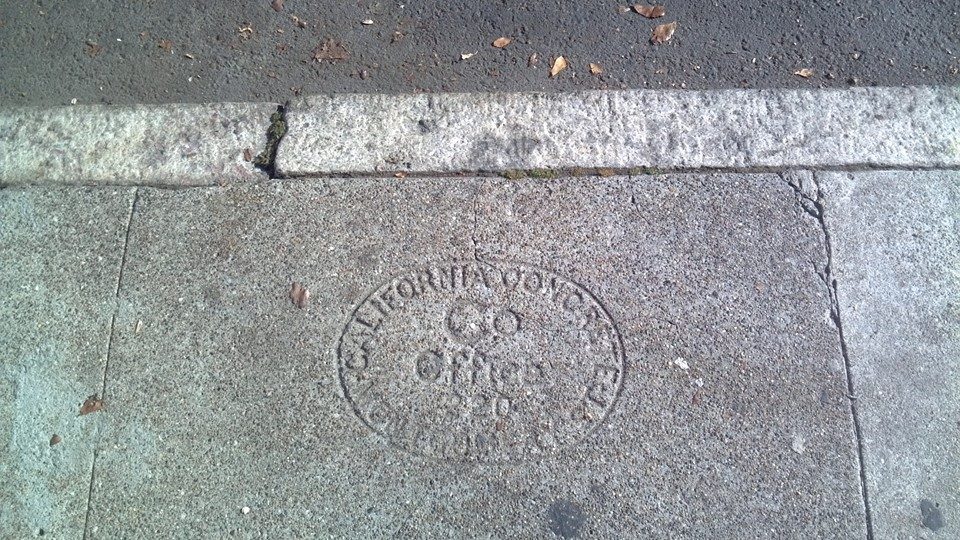
Office 220
Montgomery St’
Concrete patent stamp. Florida at 24th
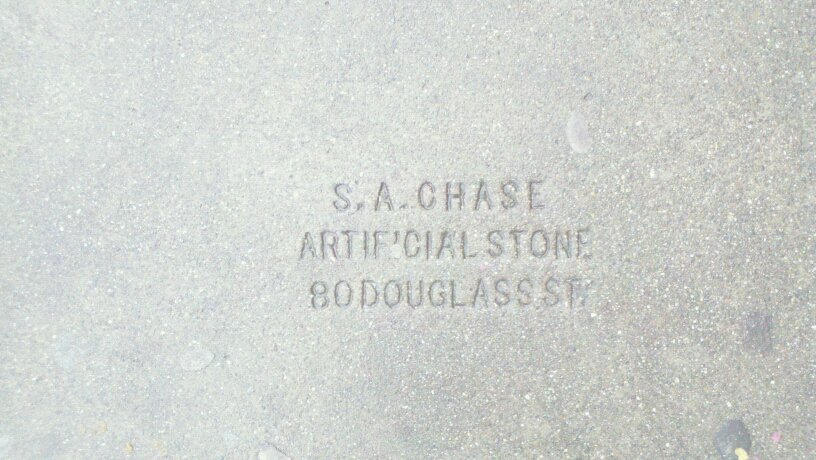
Artificial Stone
80 Douglass”
sidewalk patent stamp 23d at York.
this contractor was referenced in Building and Engineering News
Volume 26, Issue 1
1926
When new materials enter the market, they first imitate the product they replace. Early plastics imitated wood. Early vinyl imitated leather. Concrete imitated stone. Early concrete was marketed as ‘Artificial Stone’. Only after a new product has gained acceptance by imitation is it free to develop its own identity.
In the early years of San Francisco, most all walks were redwood. Only the most wealthy could afford paving in stone. In the mid 1800s concrete was (re)invented and began to appear as a cheaper and therefore more accessible alternative to natural stone.
Anytime you see ‘artificial stone’ in a patent stamp, you know it is very early concrete and likely from when the walk was cast for the first time.
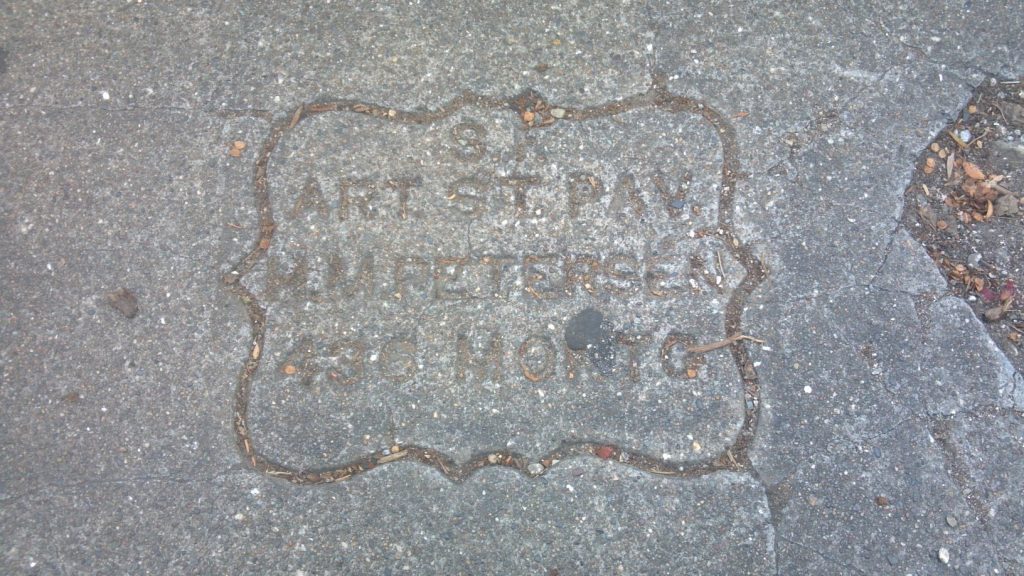
Art. St. Paving
H.M. Petersen
436 Montg”
Concrete patent stamp, 21st at Florida
From The California Architect and Building News
Volume 9
1888
San Francisco Artificial Stone Paving Company.
SCHILLINGER’S PATENT
For artificial stone sidewalks, cellars, floors, concrete foundations ect. ects.
Office 436 Montgomery Street ,
UNDER DONOHOE , KELLY & CO’S BANK .
· OFFICE HOURS , BETWEEN 12 AND 2 P M
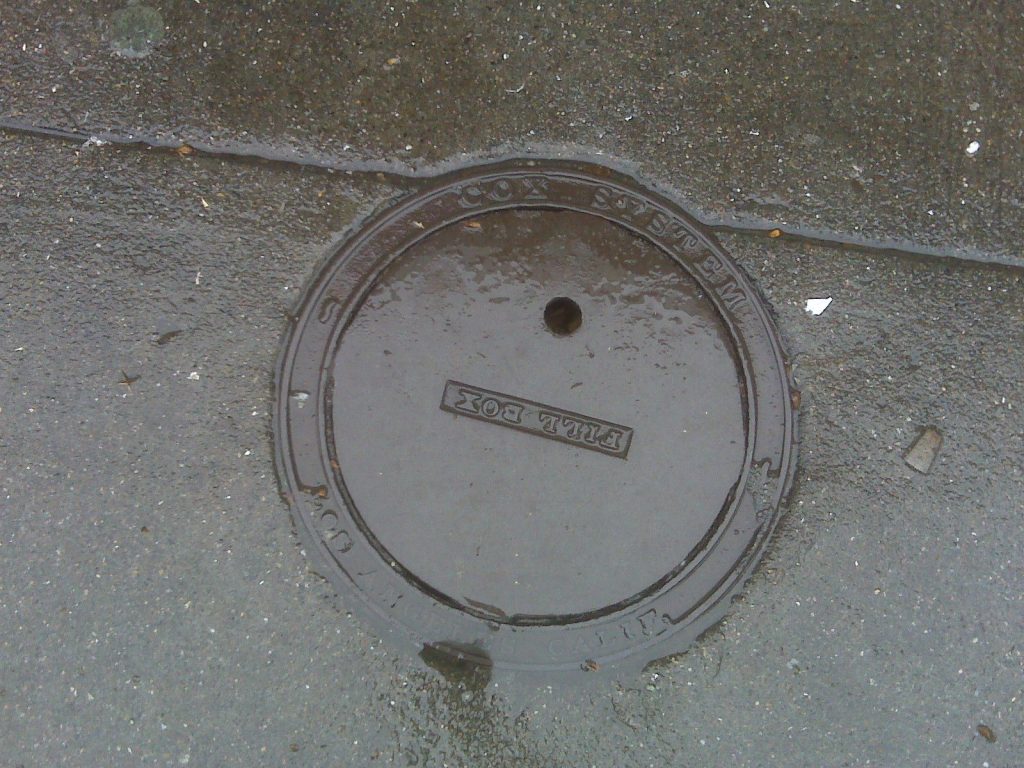
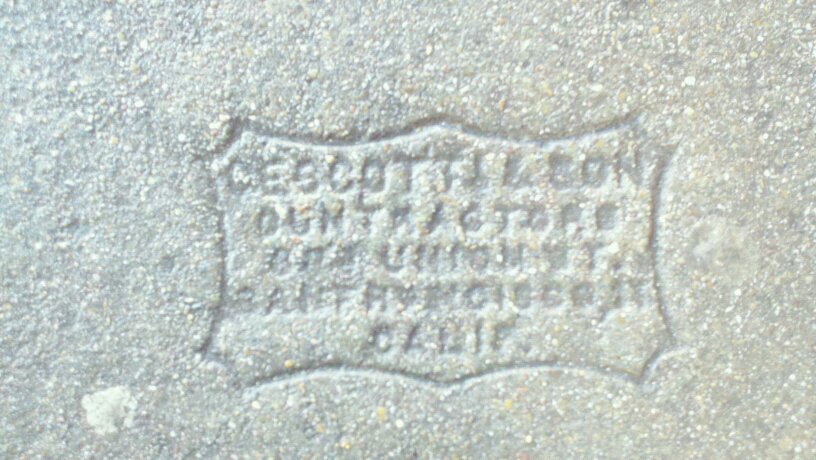
Sidewalk patent stamp, 24th at Potrero
no definitive references found
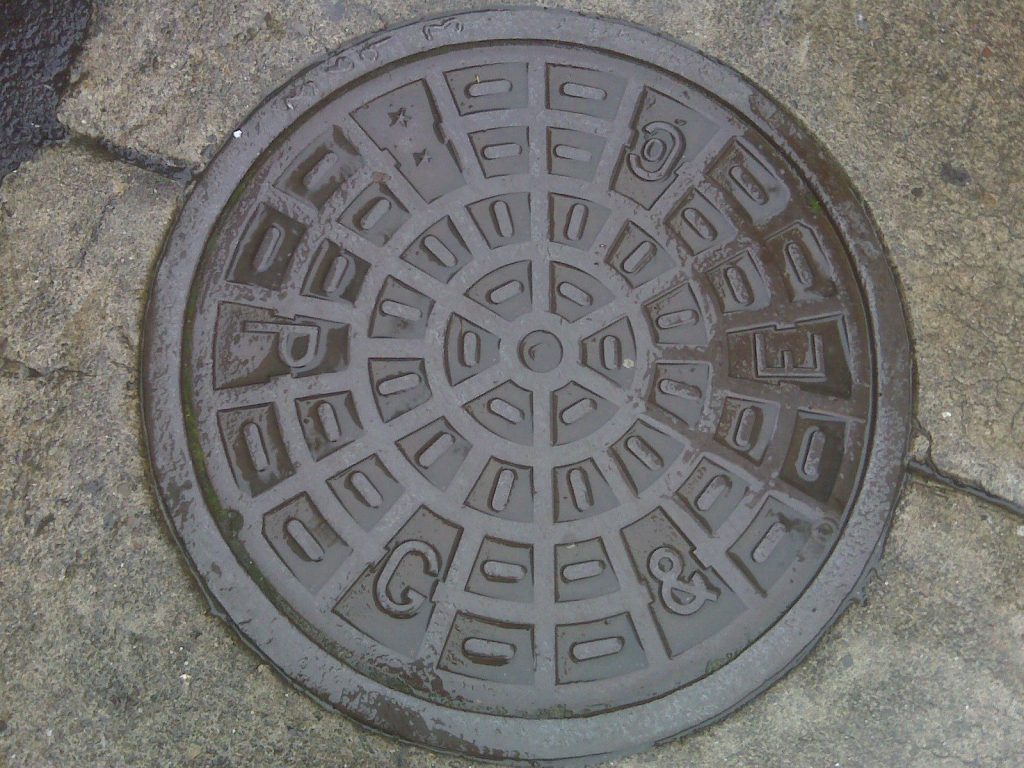
manhole cover. Turk and Polk.
Early enough to have the ‘Co’, before it was shortened the just PG&E
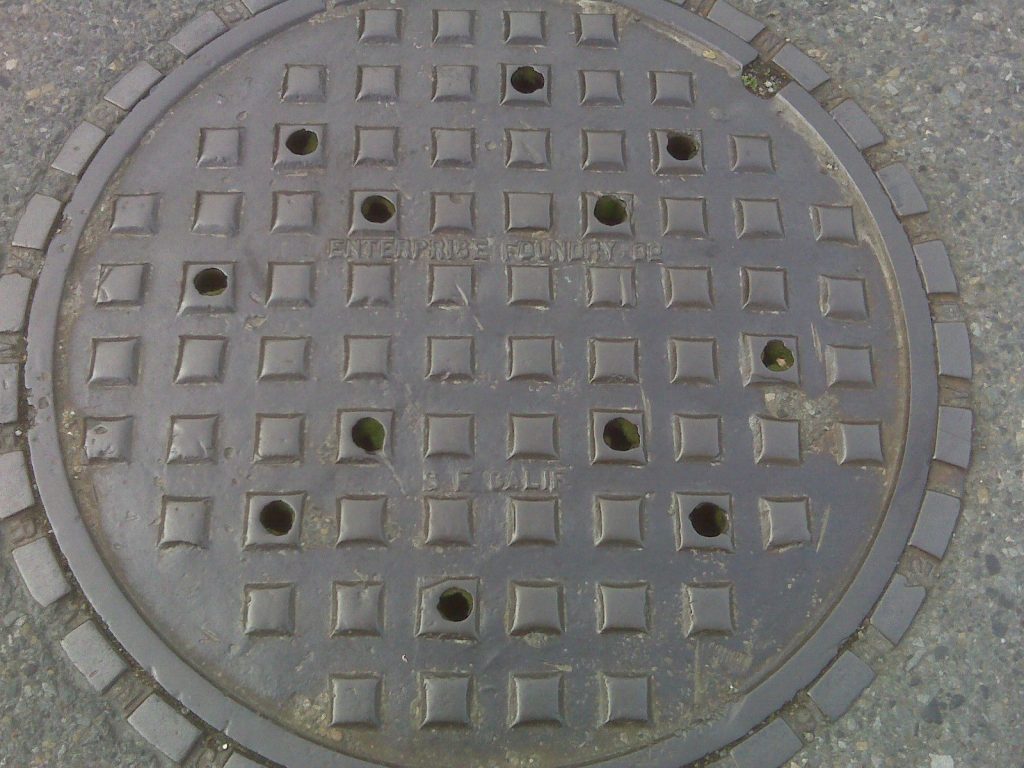
Manhole cover Noe and 26th
Enterprise Foundry was originally founded in 1886 to build gold mining machinery. It later played an important role in the reconstruction of the city after the 1906 quake.
http://en.wikipedia.org/wiki/Enterprise_Engine
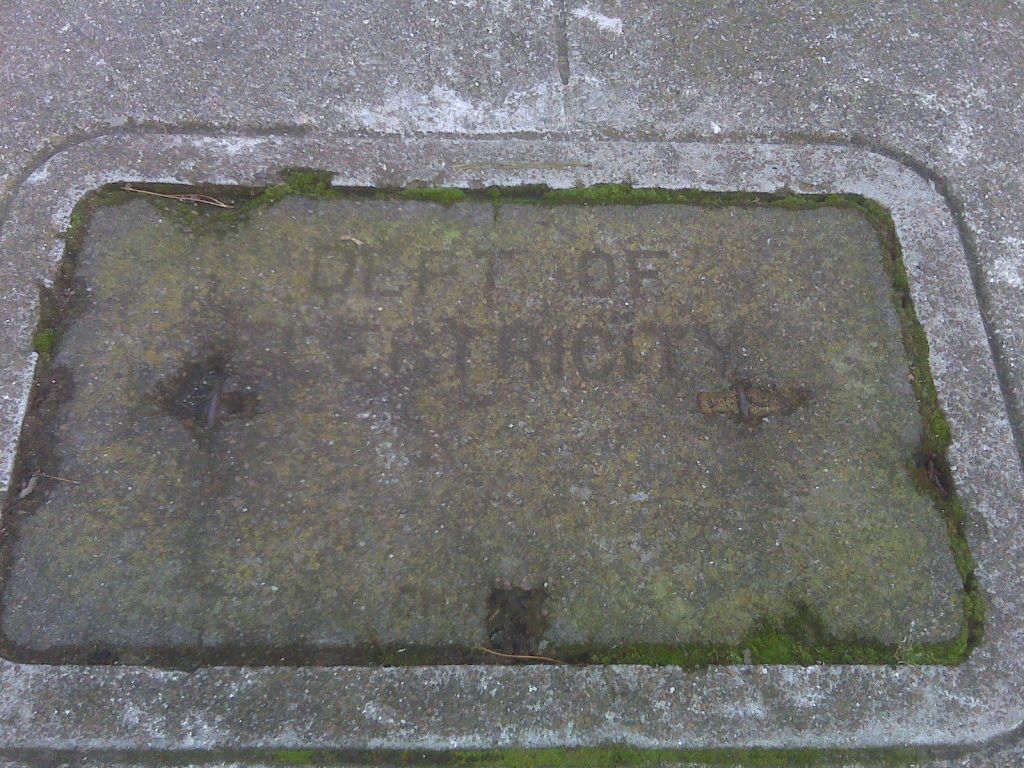
Part of San Francisco’s Emergency fire and police communication network originally installed citywide in 1864 for a cost of $24,000. Used regularly by police until 1967 when handheld radio versions repaced the hardwired system, though still in use for emergencies.
http://www.sfmuseum.org/hist10/cfaspaper.html http://www.sfmuseum.org/hist6/cfalarm.html http://www.sfmuseum.org/conflag/mets.html
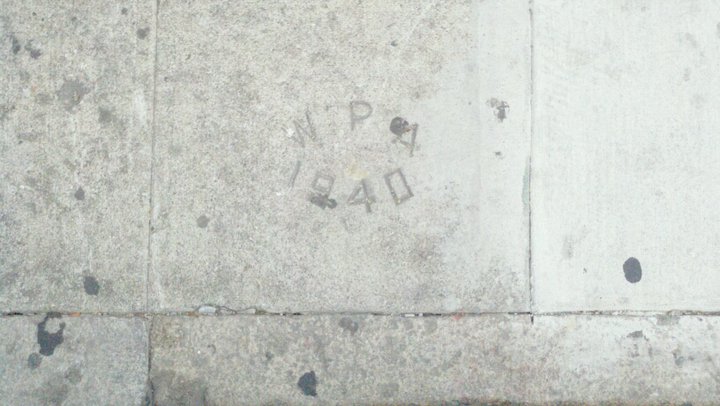
sidewalk patent stamp on the corner of Capp and 22st.
The Works Progress Administration was created to make jobs during the Great Depression. While most of the country was experiencing the dust bowl and the depression, San Francisco was still booming.
Many who were fleeing the dust came to California in search of affordable housing and work opportunities . The endless sea of small matching houses in the Sunset District were built during this time to house the influx.
The WPA and other construction projects like towers downtown and the Golden Gate Bridge. offered these people work. Capp Street was widened by the WPA in 1940
a photo of the work taking place: http://webbie1.sfpl.org/multimedia/sfphotos/AAB-3218.jpg
http://en.wikipedia.org/wiki/Works_Progress_Administration
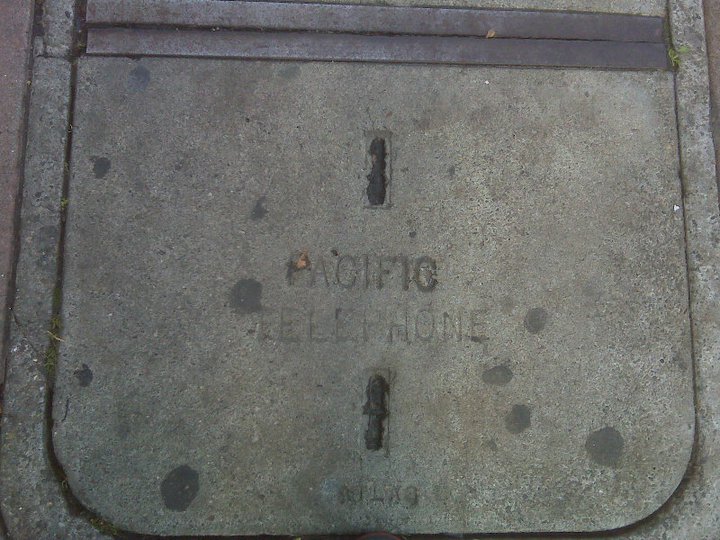
Later became PacBell, Pacific Telephone and Telegraph Company was the name of the original telephone company in San Francisco (1877-1984) http://en.wikipedia.org/wiki/Pacific_Bell
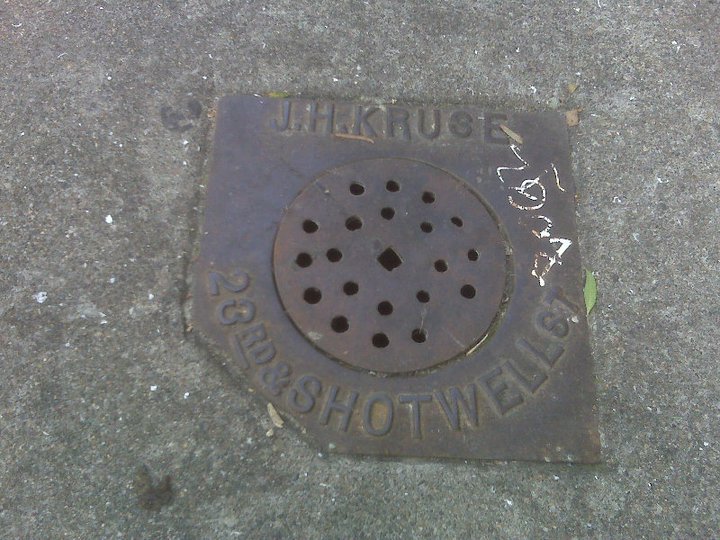
23rd & Shotwell’
In this case, this sewer vent cover bears the name of the hardware store that originally sold it.
J H Kruse was a big player in the construction industry during the beginning of last century. His businesses vertically integrated resource extraction, production, and retail.
He owned and operated a hardware store and lumber yard on the corner of 23rd and Shotwell. The building is still there today- a white building on the corner, and the lumber yard is now a community garden The store and yard were conveniently situated on a rail line that was dismantled and absorbed into the grid in the late 1930s. He also operated a lumber mill and is well referenced in the history books of lumber production in California.
Additionally it seems he was also involved in concrete production and masonry. He was a partner in a company that made lime (which is used in mortar and concrete) from limestone that was quarried out of 240 acres in Hollister CA that he also owned. That company, San Benito Lime Co, is very well referenced in historical mining, geology, and mineralogy books.
It seems he was most active from the teens until the 1930s (perhaps because motor transport became ubiquitous thus rendering his location the rail line outmoded?)
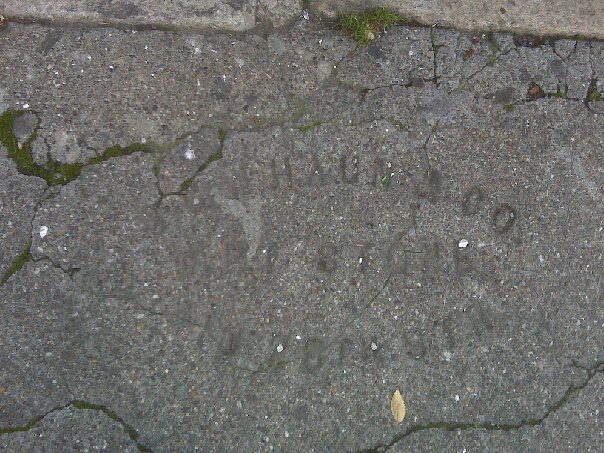
Art. Stone,
413 28th Sth’,
patent stamp. Shotwell at 23d
CCW Huan had a prolific career with many references from 1899-1930
He moved west from Minneapolis at some point after his son’s birth in 1885 and before 1899 when he first appeared in directory listings in San Francisco
(His son’s obituary states: ‘Died July 21 , 1962 George Cleveland Haun , the son of C. C. W. and Emma ( Wachsmuth ) Haun , was born in Minneapolis , Minn . , on April 18 , 1885)
A photo of him can be seen in the mixer ad from Cement World Magazine 1916:
https://www.google.com/books/edition/Cement_World/8uQfAQAAMAAJ?hl=en&gbpv=1&dq=C.+C.+W.+Haun&pg=RA6-PA6&printsec=frontcover
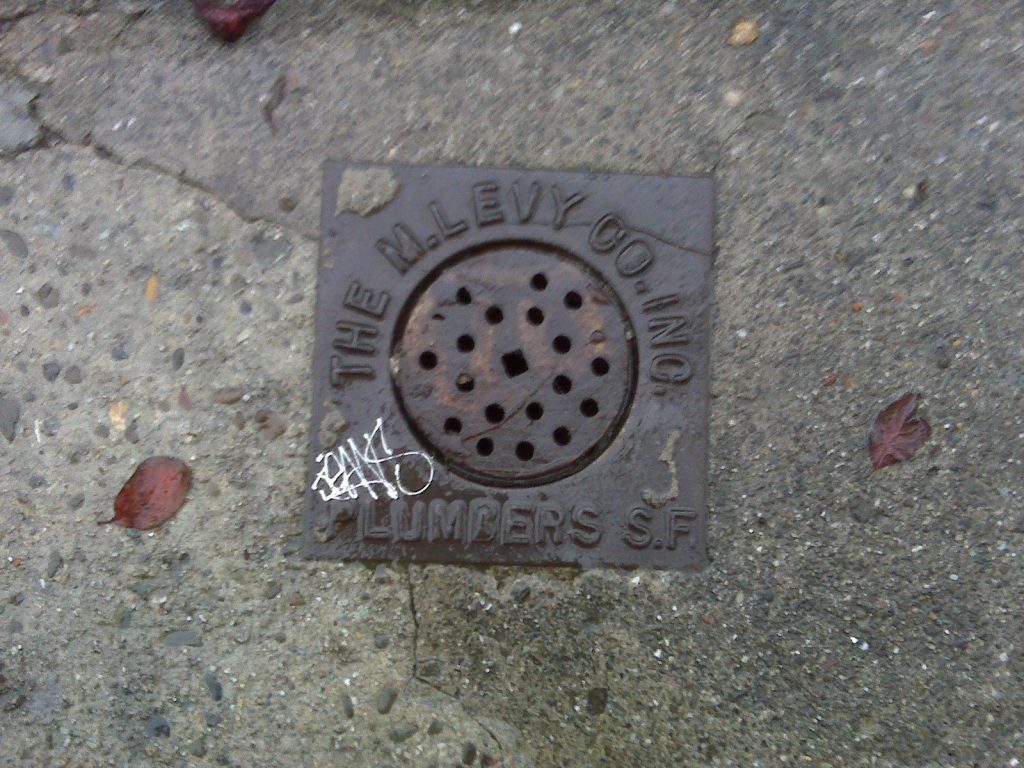
Plumbers SF’
Sewer vent cover. 23d at Harrison
referenced in The Plumbers Trade Journal – Volume 35
1904
‘The M. Levy Company (Inc.), of San Francisco, have succeeded to the business of Occidental Electrical Company and M. Levy, plumber, located at 1711 Polk street.’
Domestic Engineering: DE. – Volume 53 – Page 157
1910
M. Levy the Polk street plumber in San Francisco, has been contracted to install the plumbing, gasfitting, sewer, hot-water circulating system, tanks and standpipes in the six-story brick-building to be erected by Rivers Brothers on Golden Gate avenue off Market street. The consideration mentioned is $12, 420 ($390,000 is 2022 dollars)
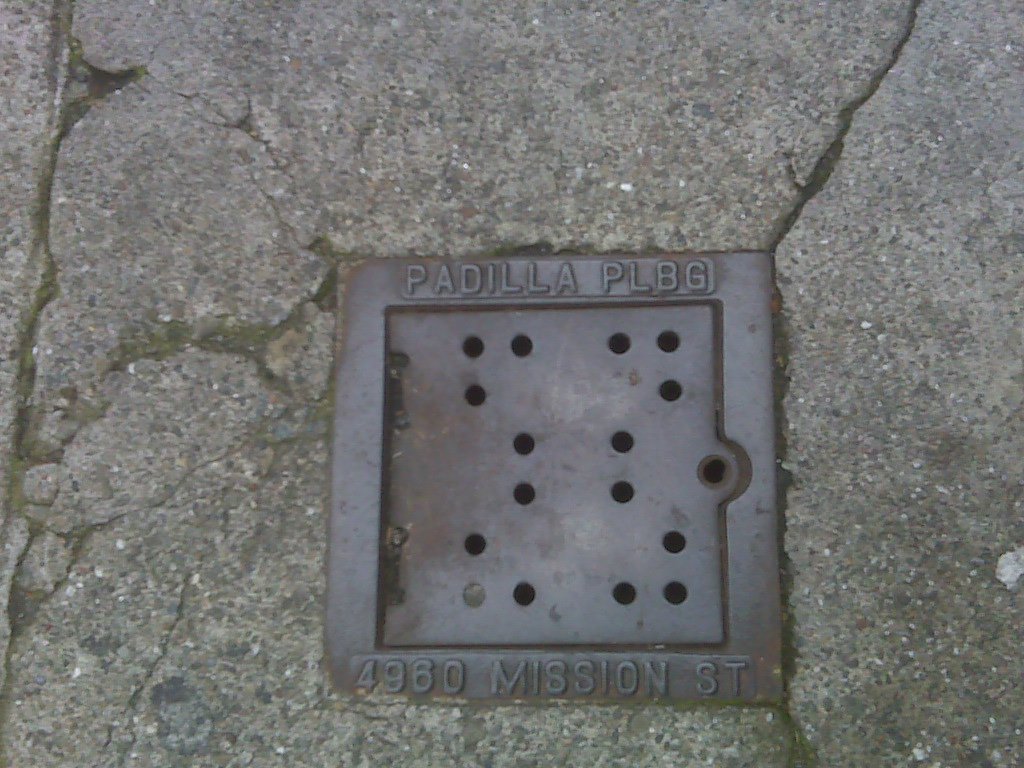
Sewer vent cover. York at 24th.
References found in the 1959 and 1977 versions of the Official Directory, Licensed Contractors of California which explains the more modern look.
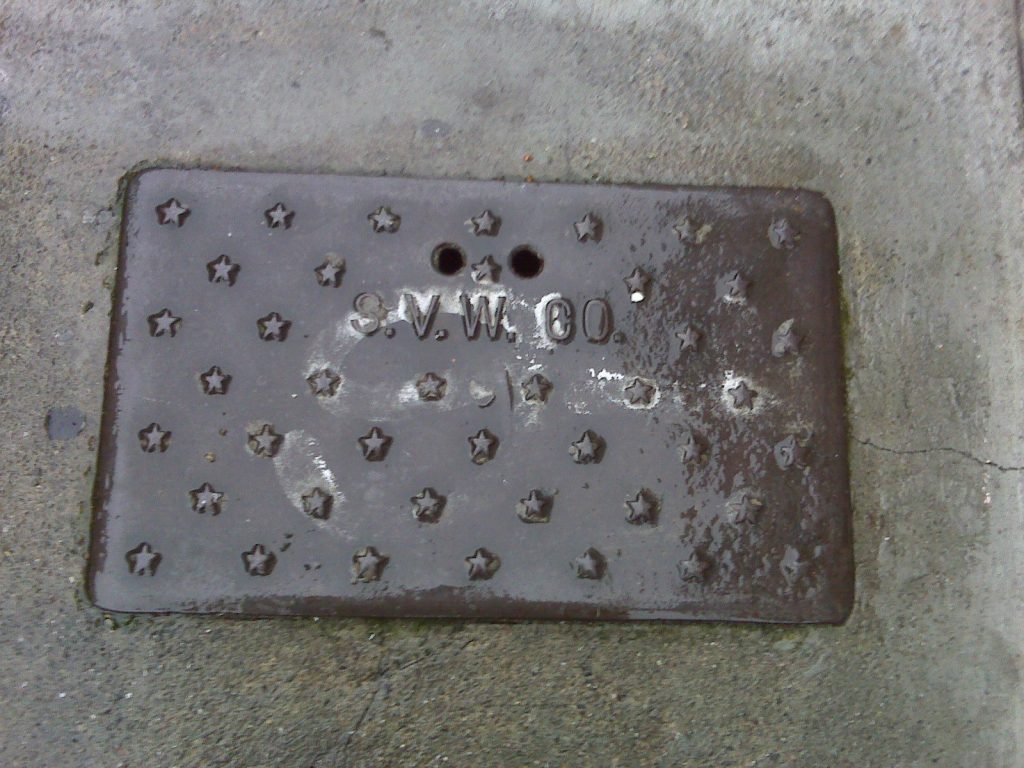
22d at Capp
I was on the hunt for this one for a while! Spring Valley Water Company was the company that had a monopoly on the city’s water supply until the city took it over in 1930.
http://en.wikipedia.org/wiki/Spring_Valley_Water_Company
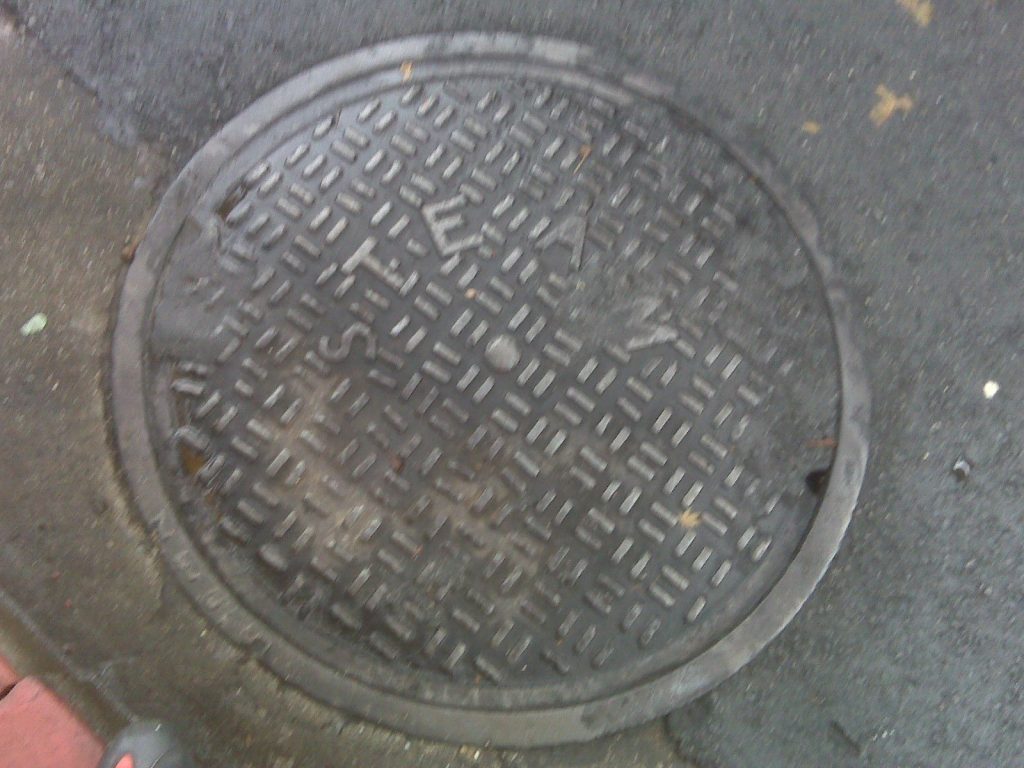
Steam main manhole cover, Lombard and Sansome
So I knew that Manhattan and Chicago had steam utility companies that sell steam as a power source. How steam punk right? I didn’t know downtown San Francisco had an active steam utility company. This manhole cover came as a surprise.
Steam is sold to downtown companies and buildings to use for industrial processes and as radiant heat. The steam is pumped through the walls of local buildings to provided heat. It offers a very efficient form of heat and frees the building from having to provide space for their own boiler.
For more on NRG’s plan to use water pumped from underground Bart stations that would otherwise be wasted:
https://higherlogicdownload.s3-external-1.amazonaws.com/DISTRICTENERGY/3D.2_Chiovoloni_Judd.pdf?AWSAccessKeyId=AKIAVRDO7IEREB57R7MT&Expires=1669954386&Signature=h3jmzQLkS1ESHIkK%2BDvNr%2FPHZiM%3D
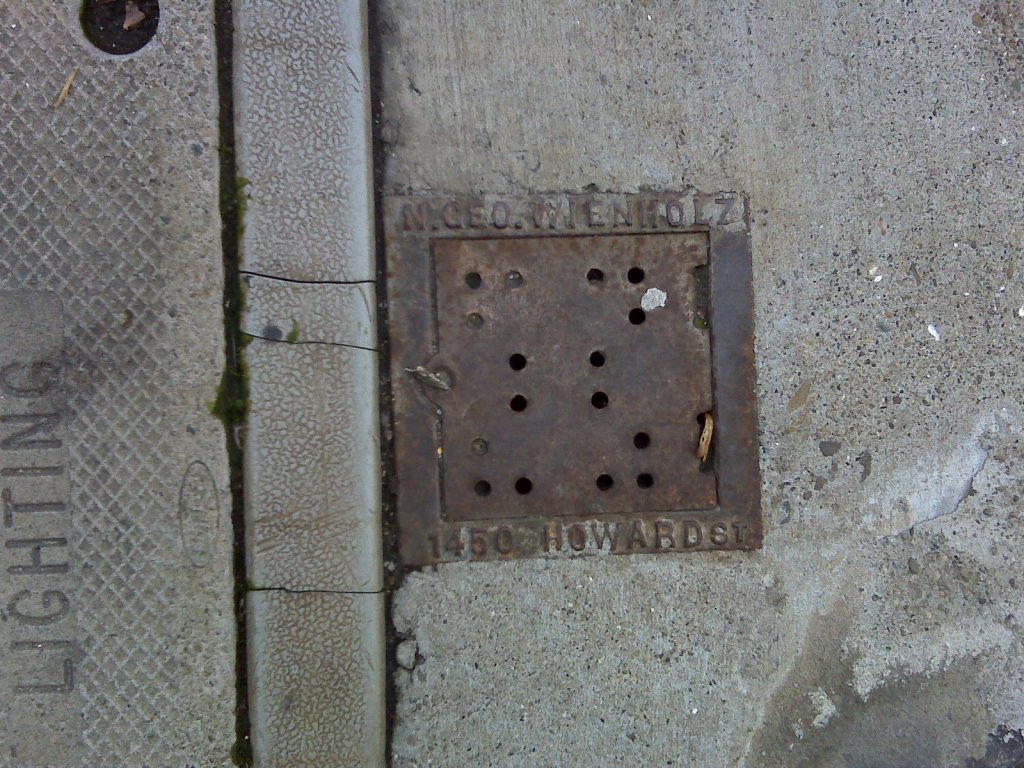
1450 Howard’
sewer vent cover. Noe at Market
Referenced in Building and Engineering News
Volume 26, Issue 2
1926
‘Contractor- N. George Wienholz , 1450 Howard St. , San Francisco . Filed Aug. 30 , 26. Dated Aug. 26 , ’26 . On 10th of each month .75 % Usual 35 days . 25 % TOTAL COST , $ 6311 Bond , $ 3156 . Sureties , Neil O’Hair and D. L. O’Hair. Limit, without delay. Forfeit, $30. Plans and specifications filed”
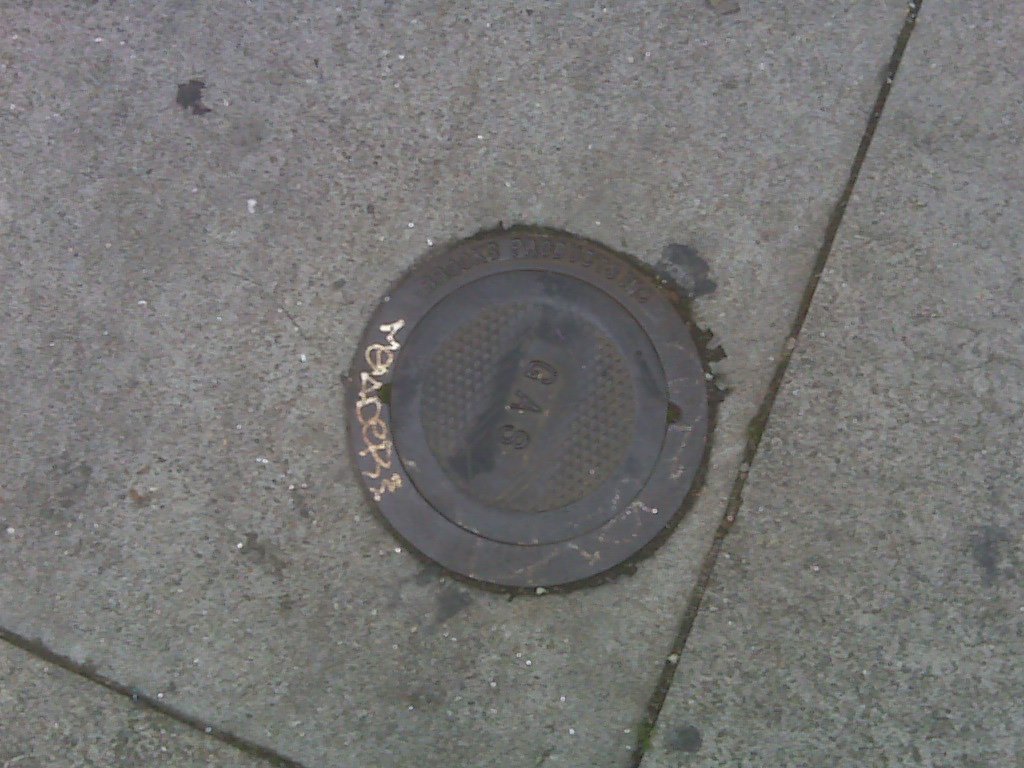
underground gas valve cover.
York at 24th.
This kind of gas valve well cover is something I use now, but today they are made out of plastic and fiberglass reinforced concrete. This one must have been installed after 1953, when the company changed it’s name to ‘Brooks’.Brooks Products wasacquired by Jensen Precast in 1997
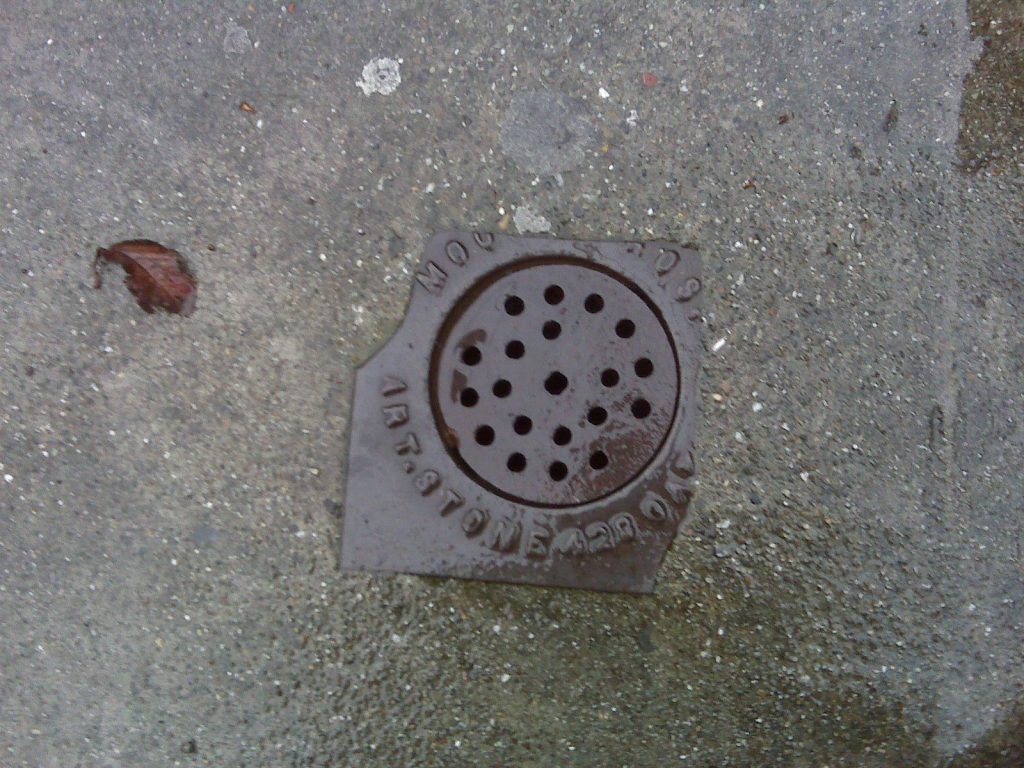
Sewer vent cover from an early concrete contractor 23d at Harrison
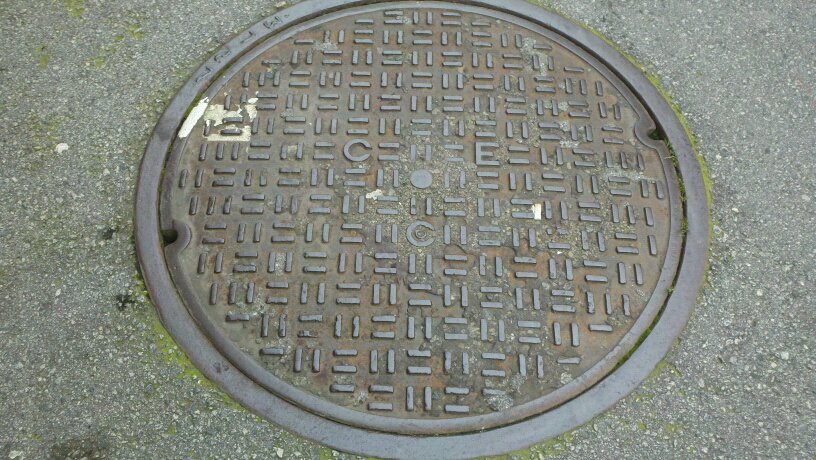
rare manhole cover. Hemlock and Larkin.
San Francisco Gas Co. was founded in 1852. California Electric Light, the nation’s first electric utility, was founded 1877. The two companies merged in 1905 to create Pacific Gas and Electric Co.
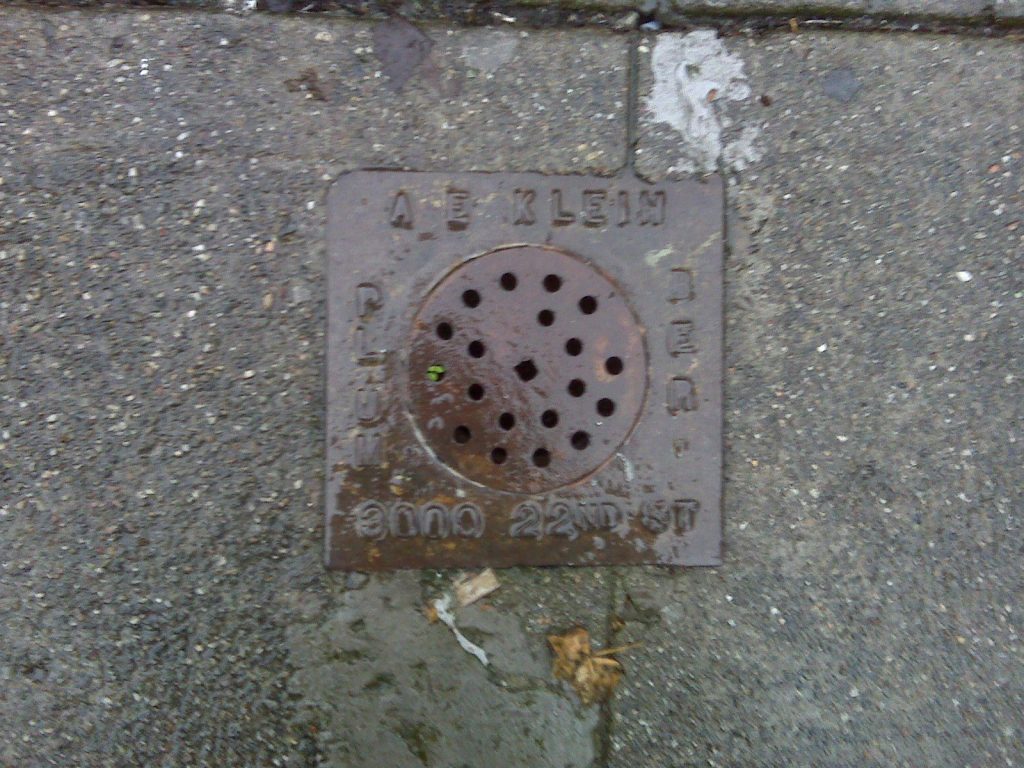
3000 22nd St,
Plumber’
Sewer vent cover, South Van Ness and 23rd
He is listed in the business directory section of The Building Law and the Plumbing Law of the City and County of San Francisco, Together with the State Tenement House Law (that is a mouthful!) 1910
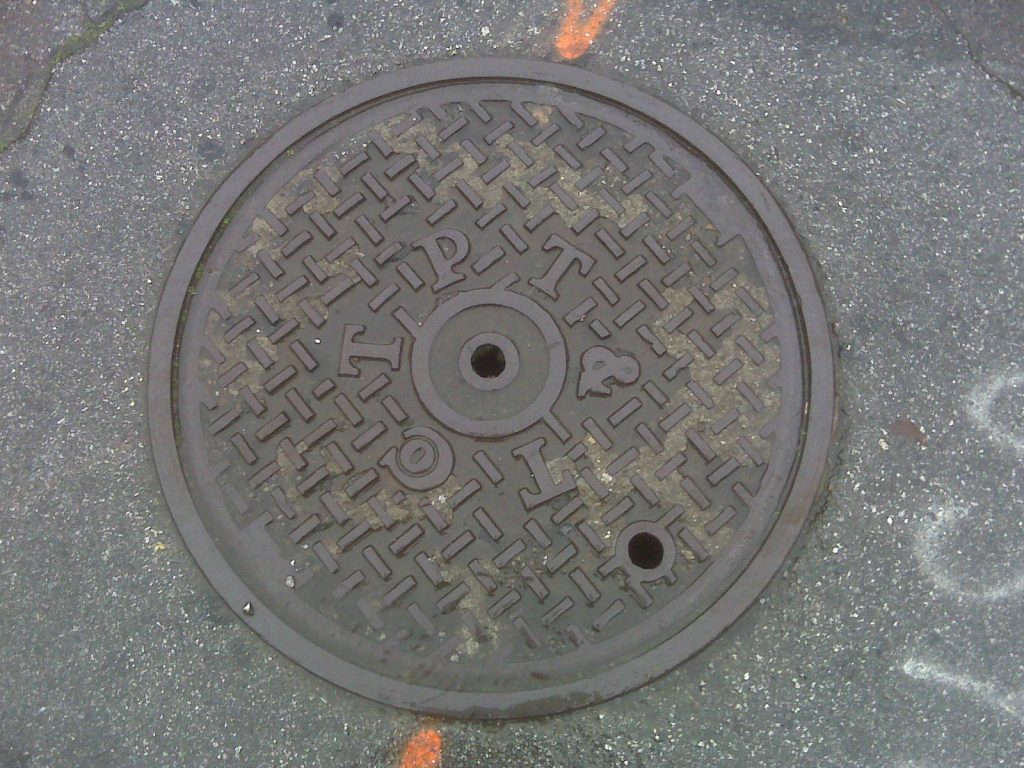
Long distance cable substation manhole cover. Hampshire and 22d.
This one’s really cool. T.P.T. & T. Co. (Toll Pacific Telephone and Telegraph) was a subsidiary of a Pacific Telephone & Telegraph. It was the first and only ‘toll’ or long distance carrier between San Francisco and Los Angeles between the teens and early 20s
This cable connected the two cities for the first time circa 1914. Users paid a ‘toll’ for the use of the long distance cable.The cable ran between two local substations where switchboards would then connect to local circuits
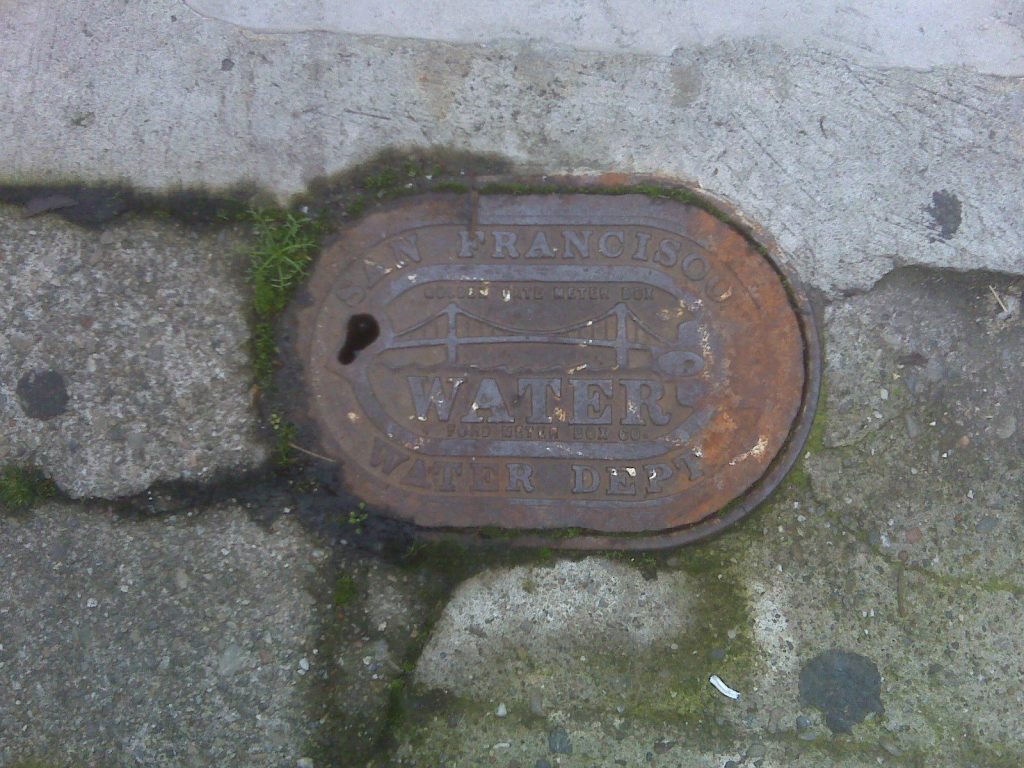
York at 24th.
http://en.wikipedia.org/wiki/The_Ford_Meter_Box_Company
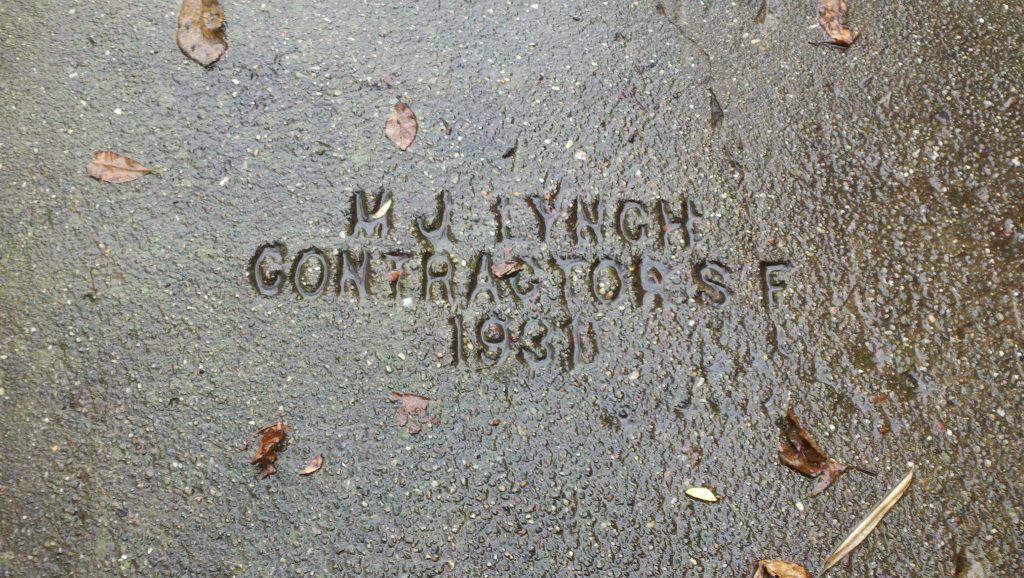
Concrete patent stamp. Alabama between 24th/23d
Referenced in:Western Construction – Volume 12
1937
“Barneveld & Oakdale Sts. San Francisco
was paid $2,538 ($52,525 in 2022 dollars) by the Department of Public Works, City Hall San Francisco for the reconstruction of the Northeast corner of Fell and Polks Streets”
California. Contractors’ State License Board
Directory of Contractors
1956
San Francisco (Calif.). Dept. of Public Works ·
Annual report of work awarded
1961
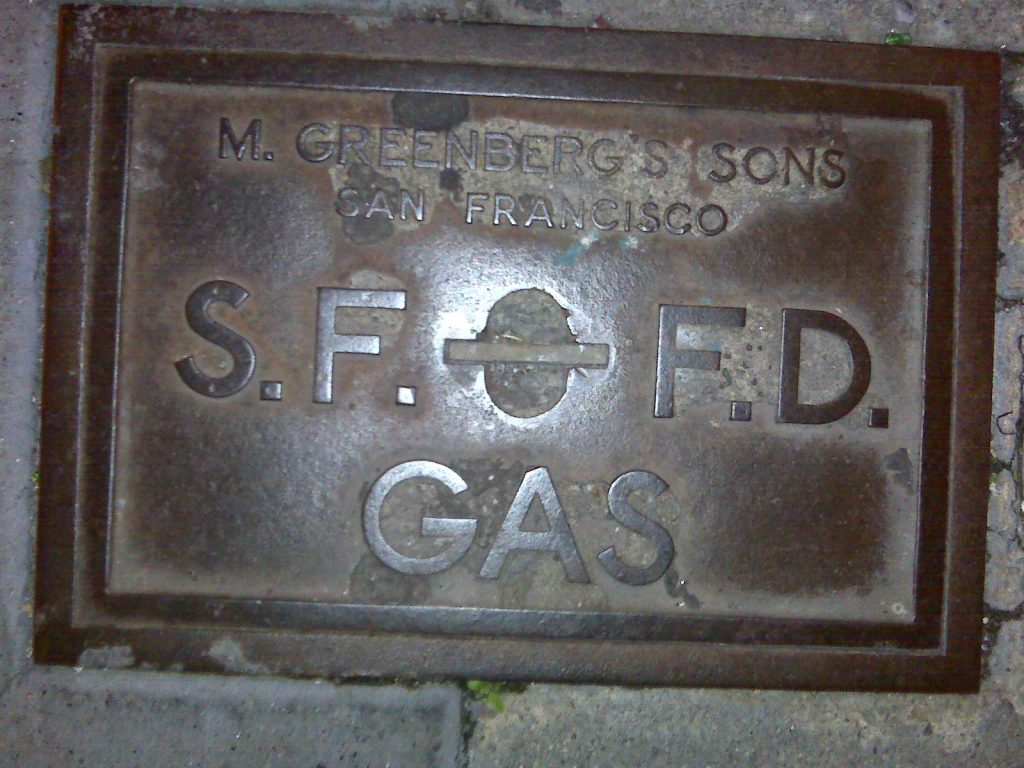
Morris Greenberg invented the ‘California’ wet barrel fire hydrant and owned a San Francisco foundry. Today, the San Francisco plant is still an industry leader
http://firehydrant.org/pictures/g01.html
http://www.sfmuseum.org/hist8/greenberg.html
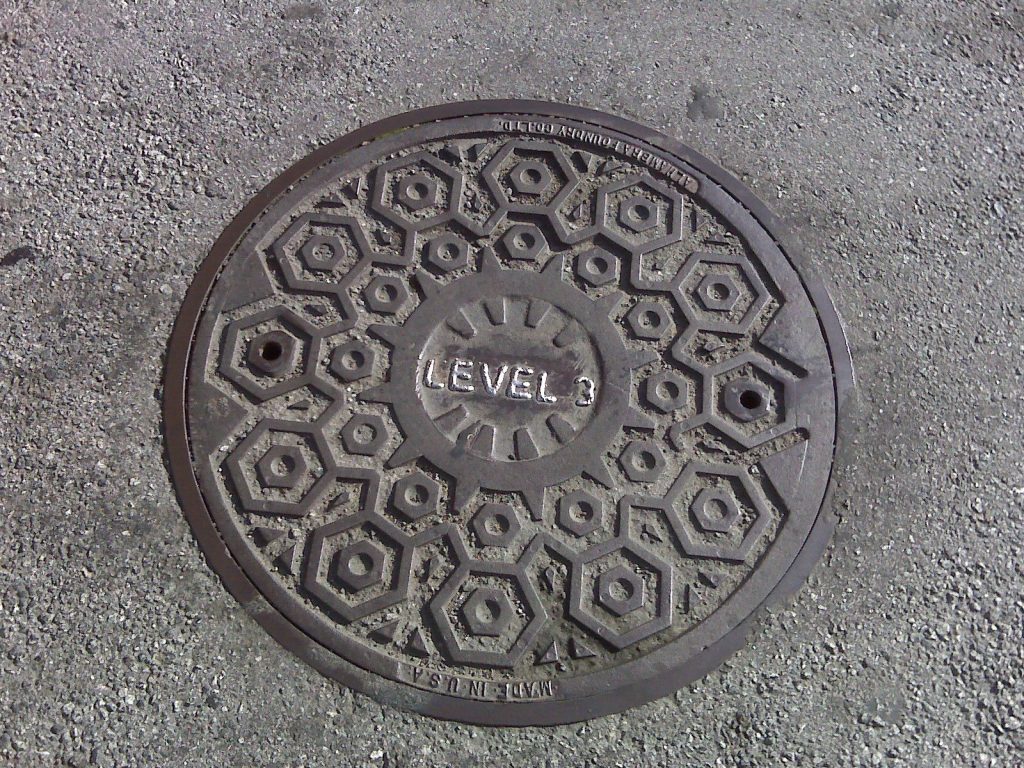
Level 3 Communications is a fiber optics internet service provider company founded in the Silicon Valley in 1985 and is now one of the largest in the world.
The foundry that forged it, Alhambra, was founded in 1923 and is still in business
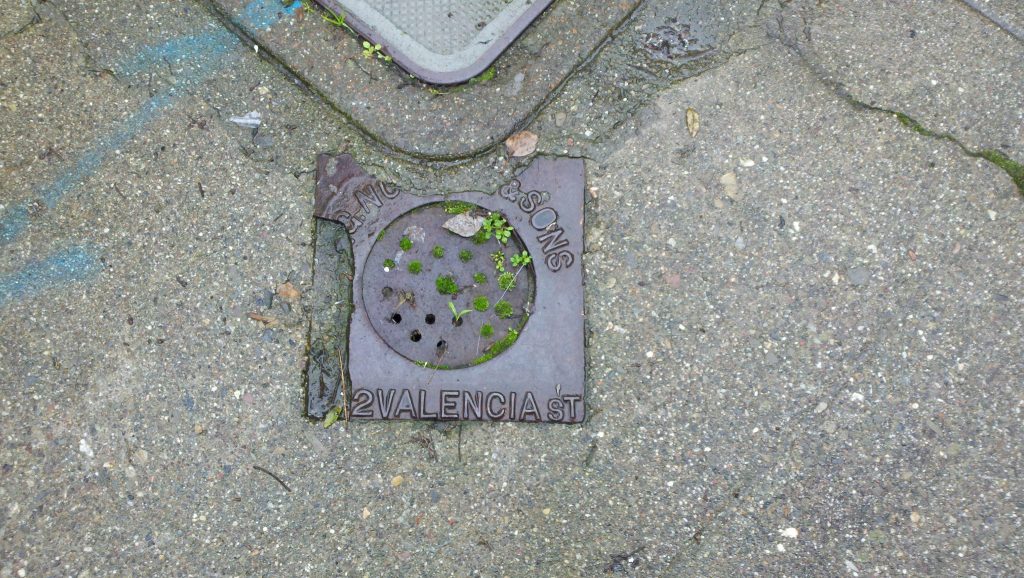
Crocker-Langley San Francisco Business Directories
ranging from 1890-1909
“Norman F. G. & Sons (Frank G., Frederick G. and Edwin H.) Hardware, 842 Valencia”
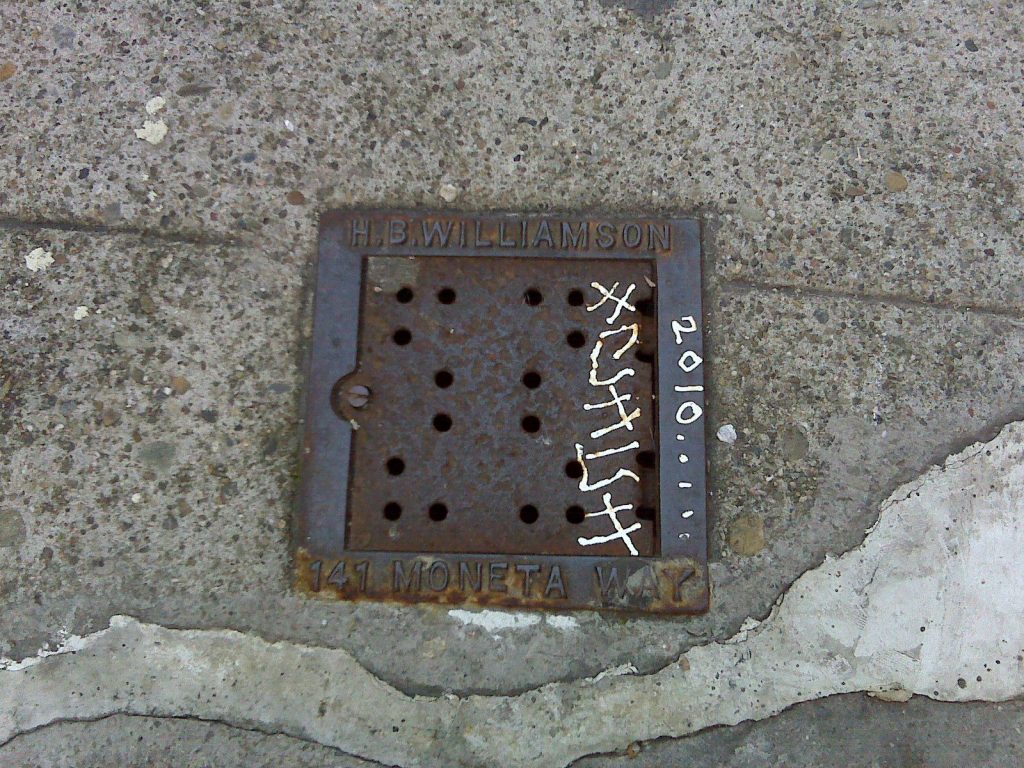
141 Moneta Way’
sewer vent cover, Capp at 21
no definitive references found
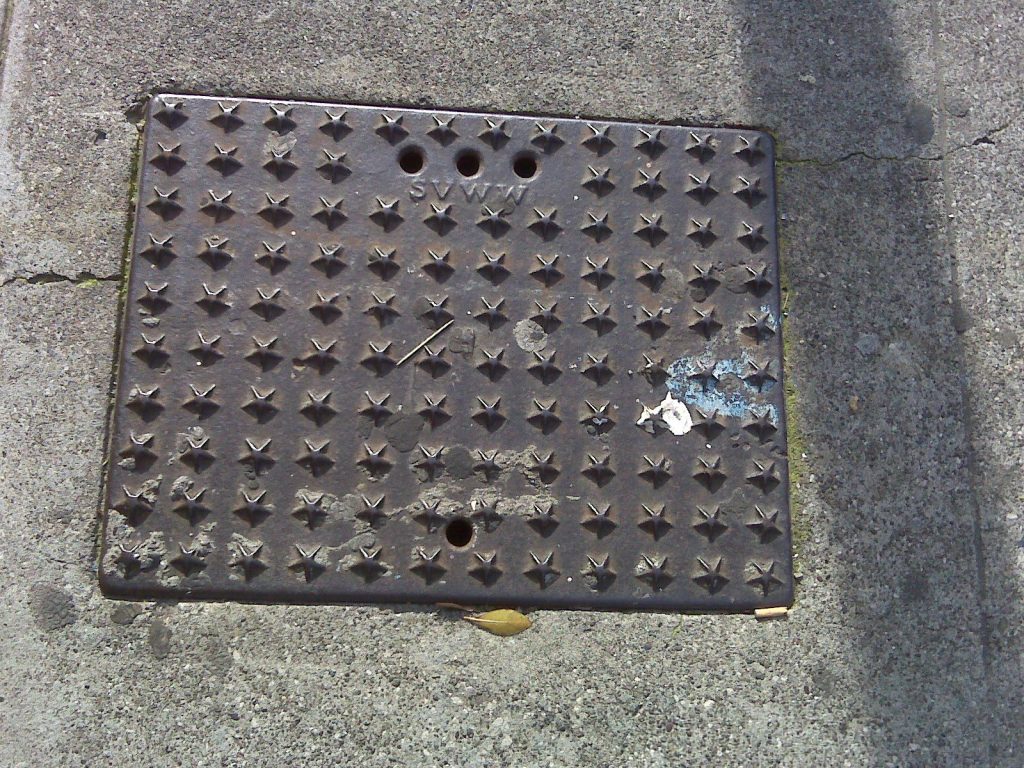
Though not marked it is very possible that this was forged at Ajax foundry as the start tread pattern was used on their other castings.
http://en.wikipedia.org/wiki/Spring_Valley_Water_Company
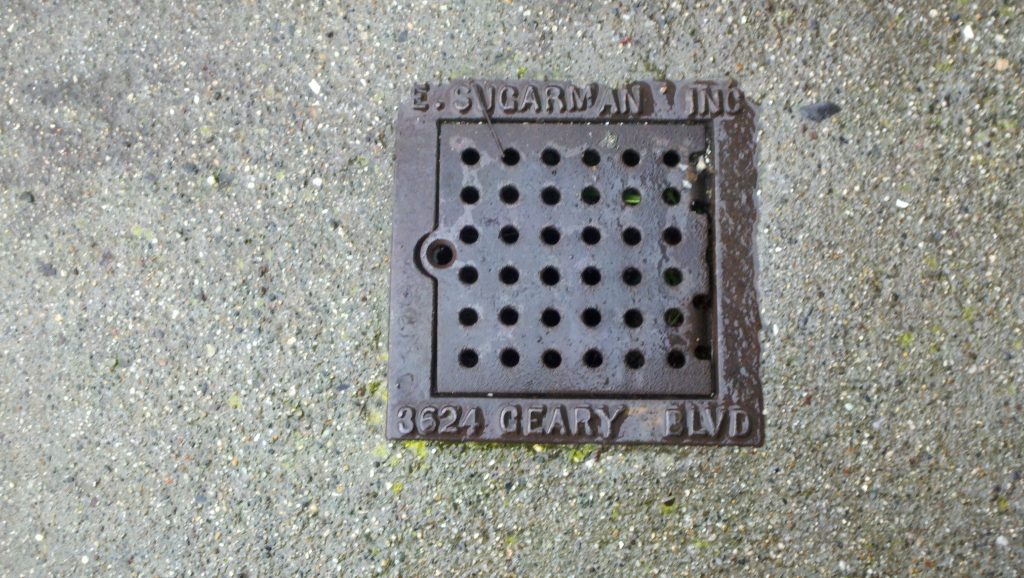
sewer vent cover. Esmeralda and Peralta
Today it is a Wells Fargo but it was once a really cool midcentury modern hardware and appliance store. Check out the SF public library pic
https://digitalsf.org/islandora/object/islandora%3A136568?solr_nav%5Bid%5D=51a1d78e997fbf28acc6&solr_nav%5Bpage%5D=3&solr_nav%5Boffset%5D=17
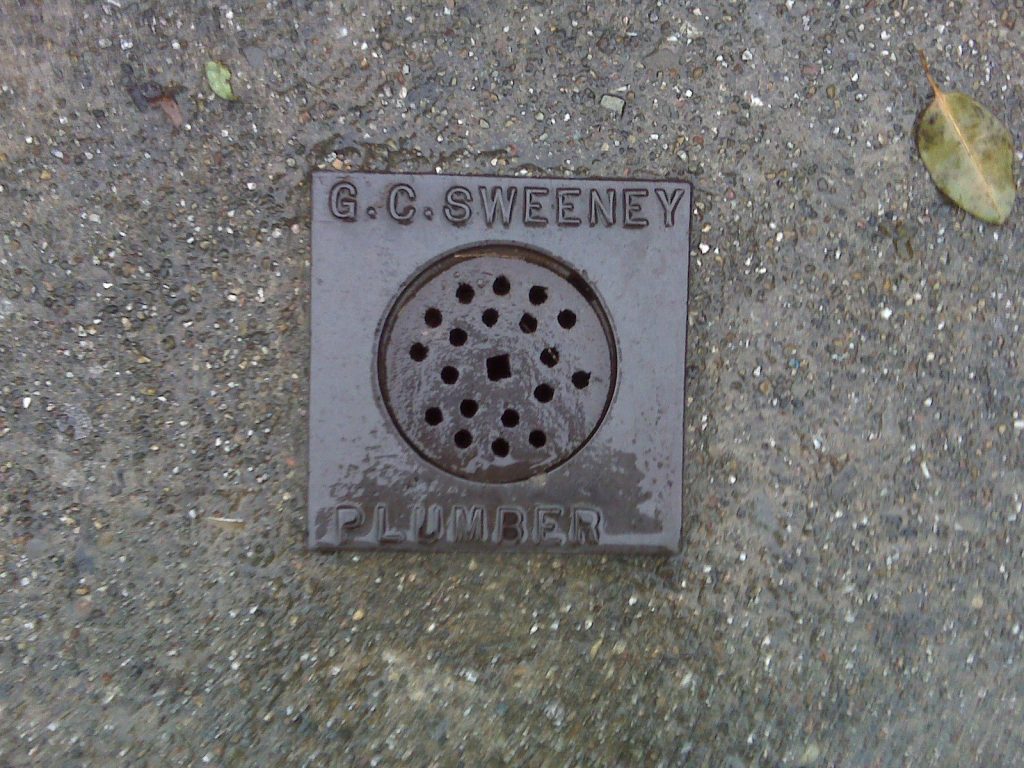
sewer vent cover. South Van Ness and 23d
Garret C. Sweeney is very well referenced. The earliest I found was 1878 Polk’s Crocker-Langley San Francisco City Directory. He was referenced in many directories and trade publications around the turn of that last century with the most recent being 1909.
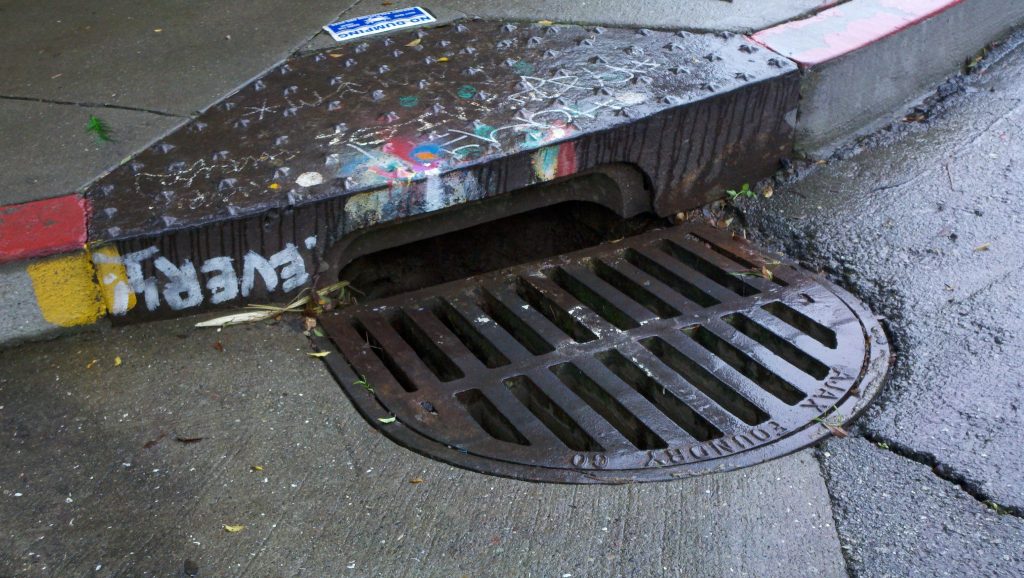
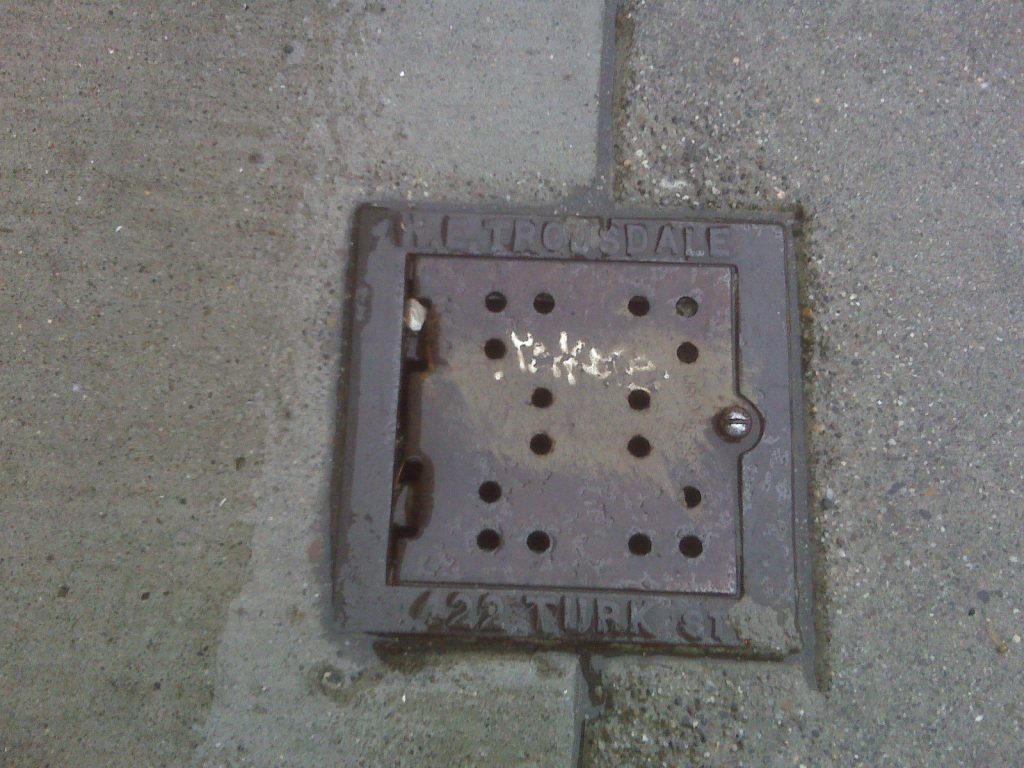
sewer vent cover. Turk and Larkin
Referenced in
Building and Engineering News – Volume 26, Issue 1
1926
‘S. F. Plumbing W. E. Trousdale , 422 Turk St.’
Domestic Engineering and the Journal of Mechanical Contracting
Volume 121
1927
“W. E. Trousdale , 422 Turk street , was awarded the plumbing and heating contracts on the new three – story building”
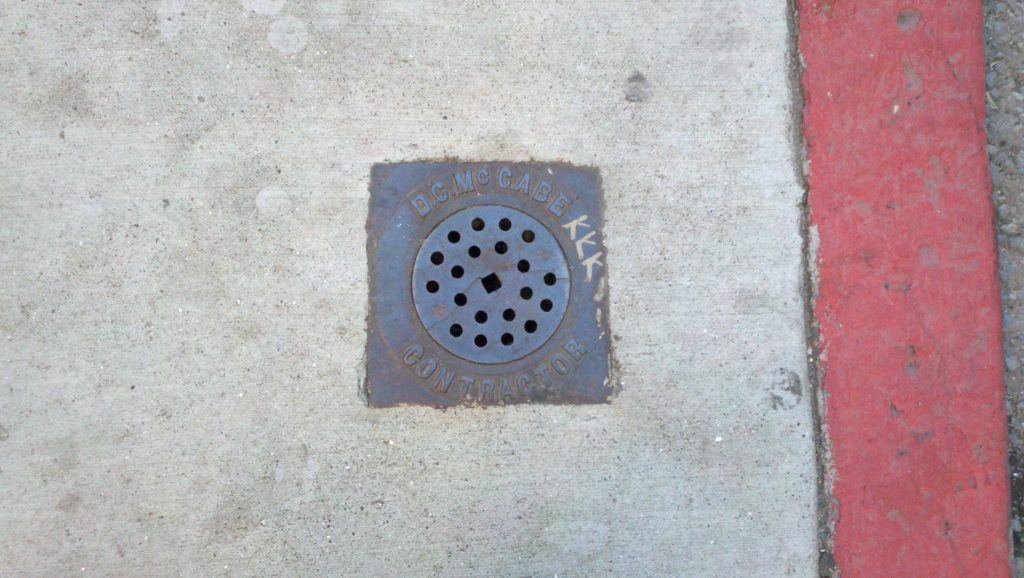
sewer vent cover, Mission at 21st.
Daniel C. McCabe is listed in directories from 1910-1922
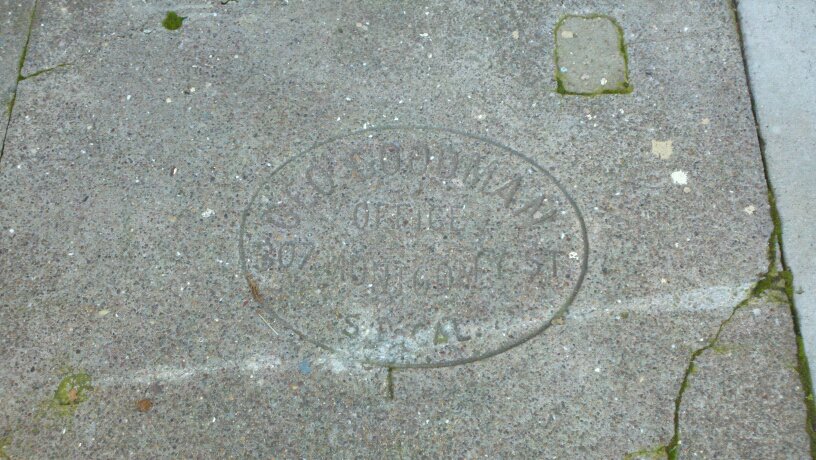
Concrete contractor patent stamp. Liberty at Dolores
Trade publication references from 1890- 1902
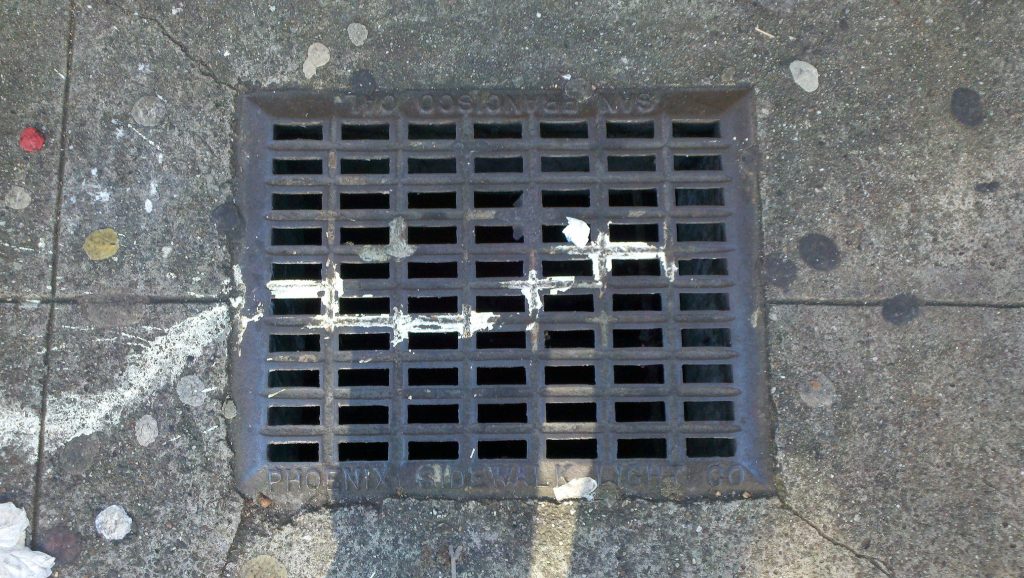
sidewalk light grate. 23d and Mission
I found references for this company in trade journals dating from 1917 to 1926
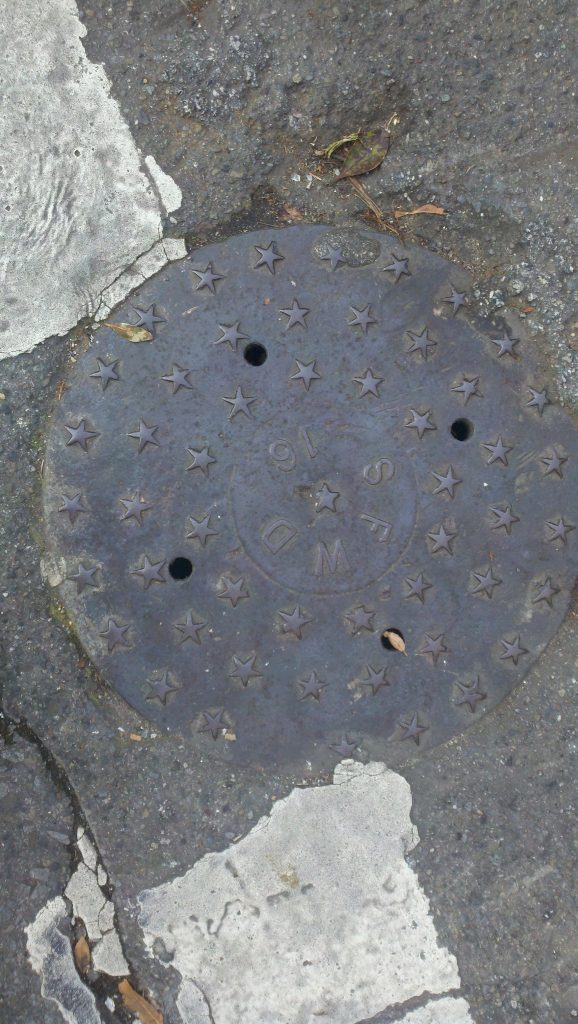
16 inch cover with unusual star pattern traction treads. 24th at Shotwell
Possibly forged by Ajax foundry which used the star pattern as an anti skid element on other things. Probably dated to after 1930 when the SFWD was created as a public utility out of the former Spring Valley Water Company which was a private company that sold water for profit.
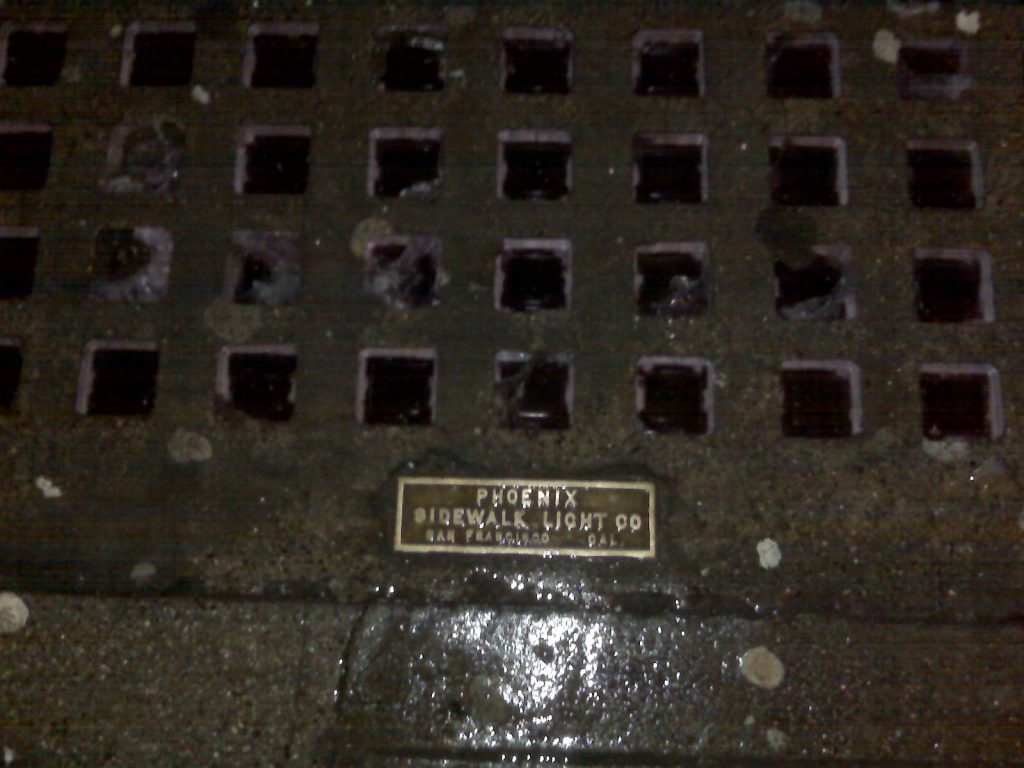
Brass patent stamp and glass and concrete sidewalk light. 16th at South Van Ness.
I found this company referenced by the SF chamber of commerce business listings dated 1926, I would have guessed the building dates to the teens.
Originally invented in the 1840s as a means of transmitting daylight into otherwise lightless basements, these glass prisms are set into steel reinforced concrete to direct light below. The glass was once clear, but the magnesium ironically used as a clearing agent purples over time with u.v. exposure. Electric lighting spelled the end of the need for this kind of transom lighting.
http://glassian.org/Prism/Vault/index.html
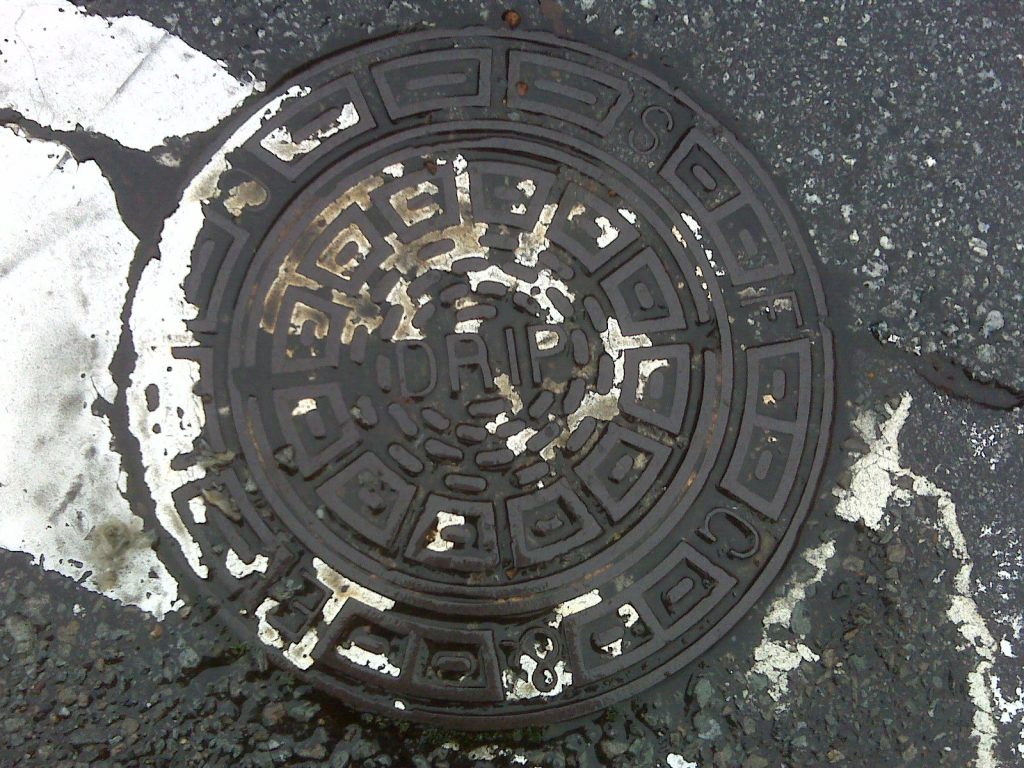
Natural gas condensate (or ‘drip’ gas) collection well cover. Alabama at 23d
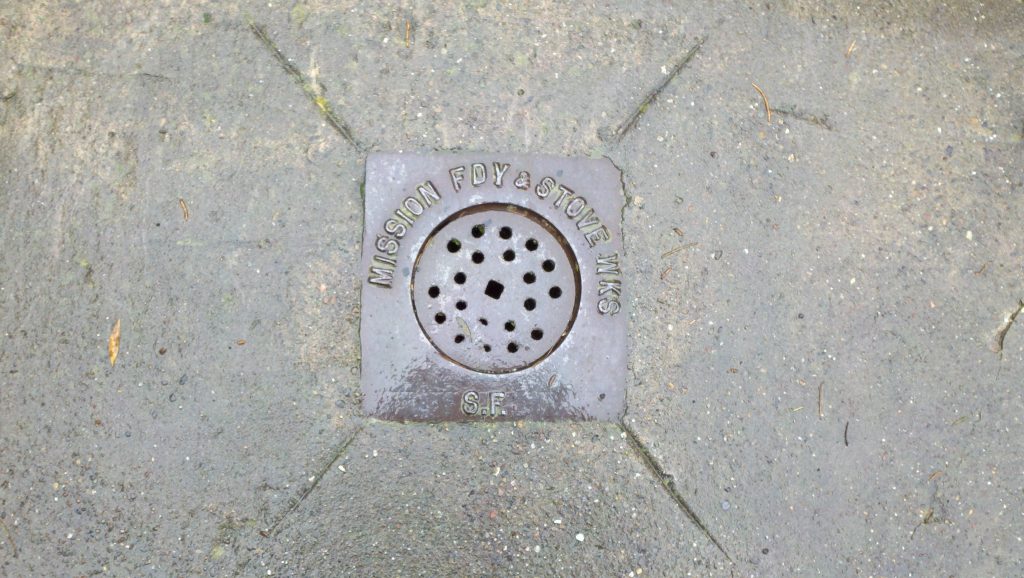
Apparently, this foundry used to make cast iron stoves too.
I’ve found reference for this company in trade directories from 1907 to 1946 so it was in operation until at least WWII
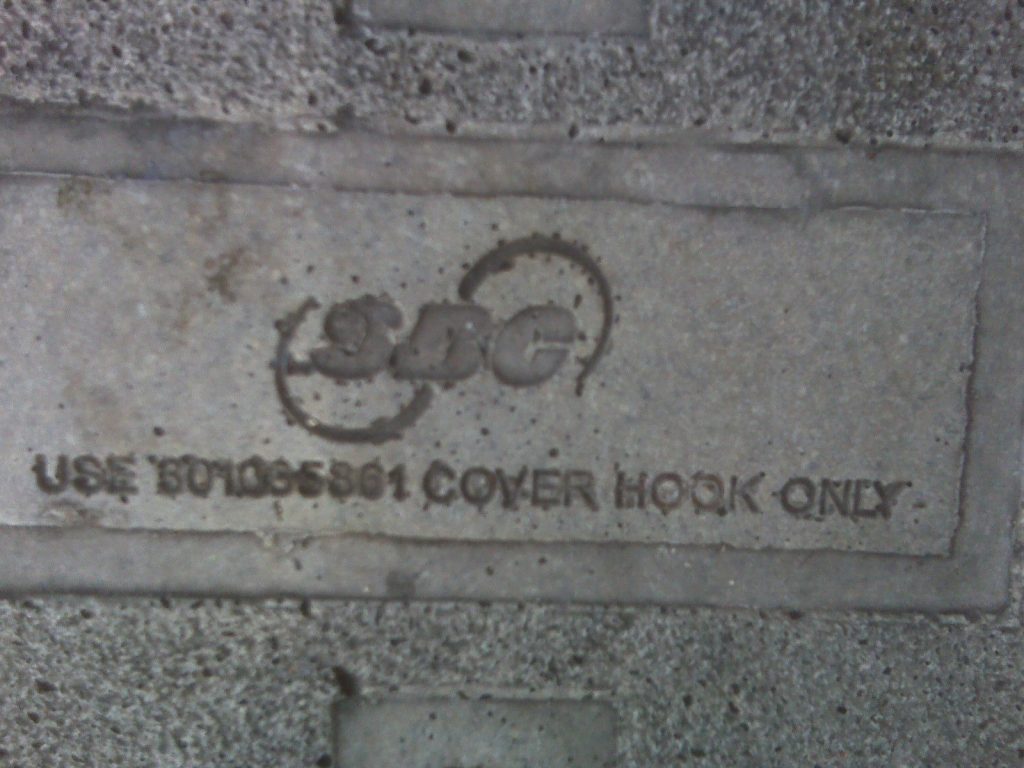
now obsolete. underground telephone utility cover. Mission and 29th
http://en.wikipedia.org/wiki/SBC_Communications
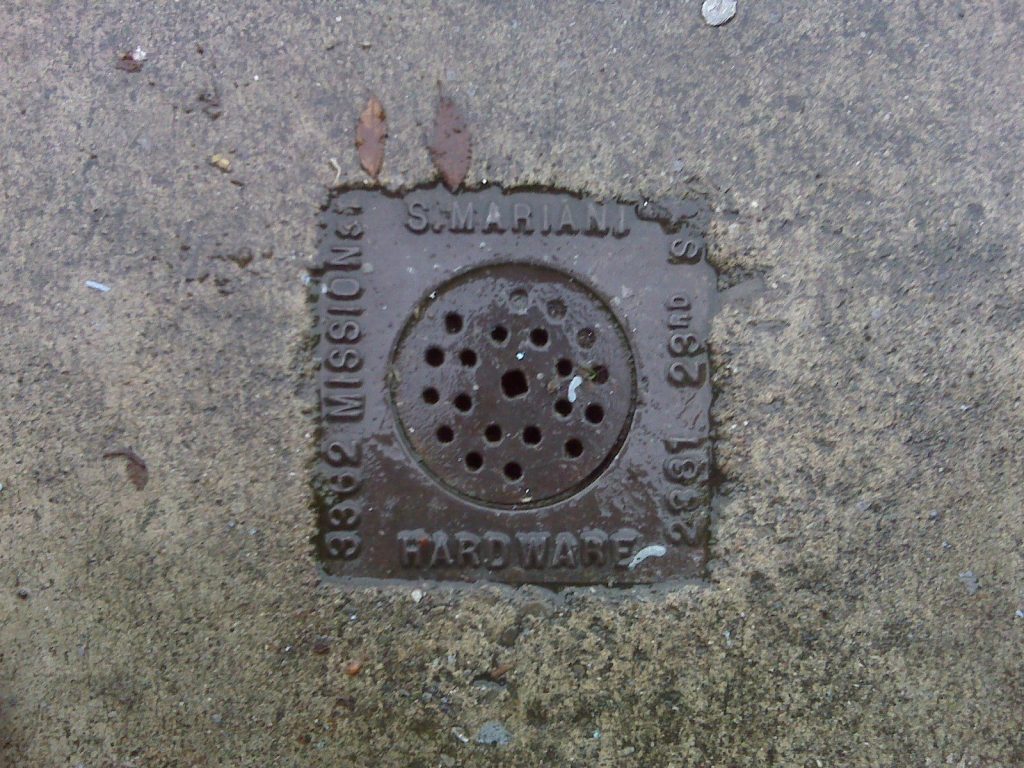
Sewer vent cover. 23d and Folsom
The site of the 23d St shop still exists and a hand painted signs can still be read on the side of the building. It is a residence now.
The company and location is referenced in directory listings from 1899-1909
It was also featured in a 1924 issue of Hardware Dealers’ Magazine
Volume 61. There is a photo of the storefront. It looks more or less the same today!
https://www.google.com/books/edition/Hardware_Dealers_Magazine/RSII0VQz6F4C?hl=en&gbpv=0
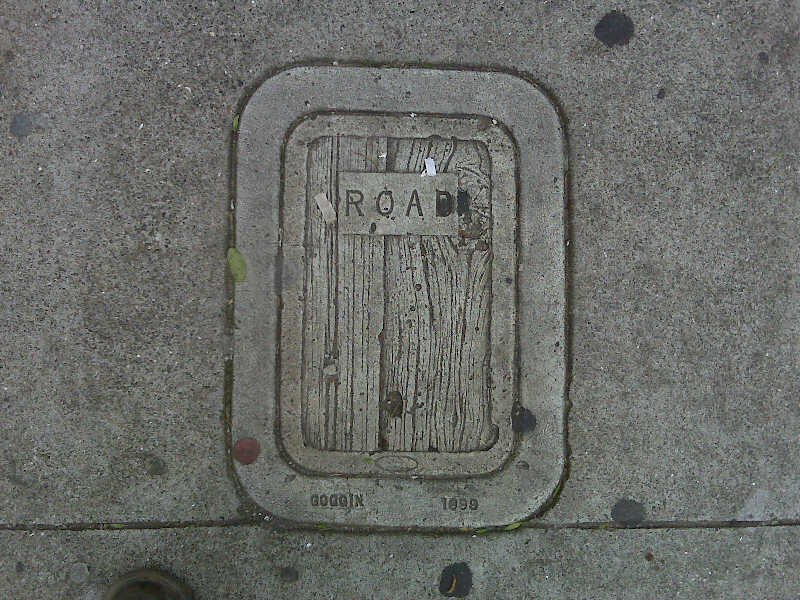
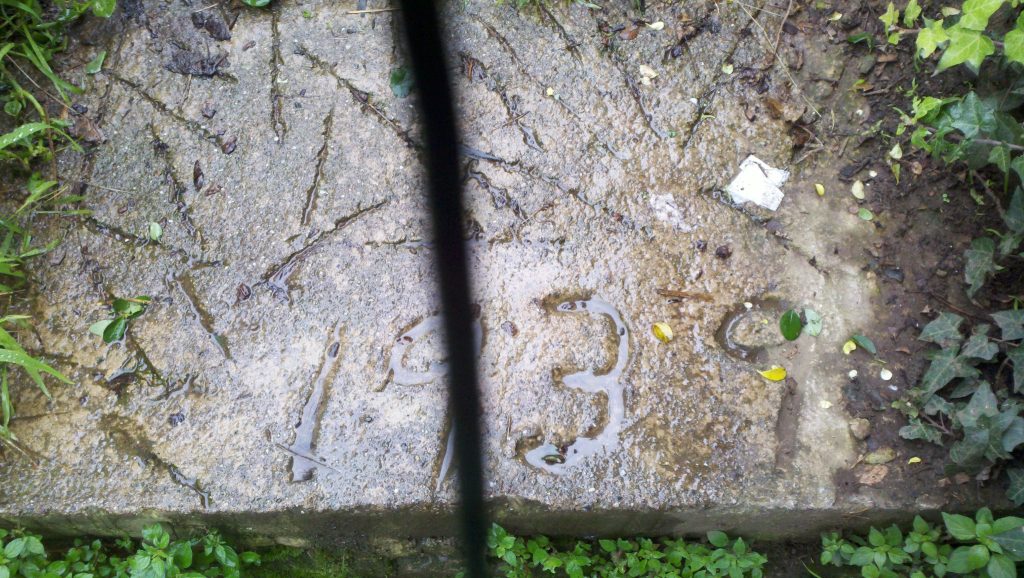
dated wet concrete graffito. Peralta and Rutledge
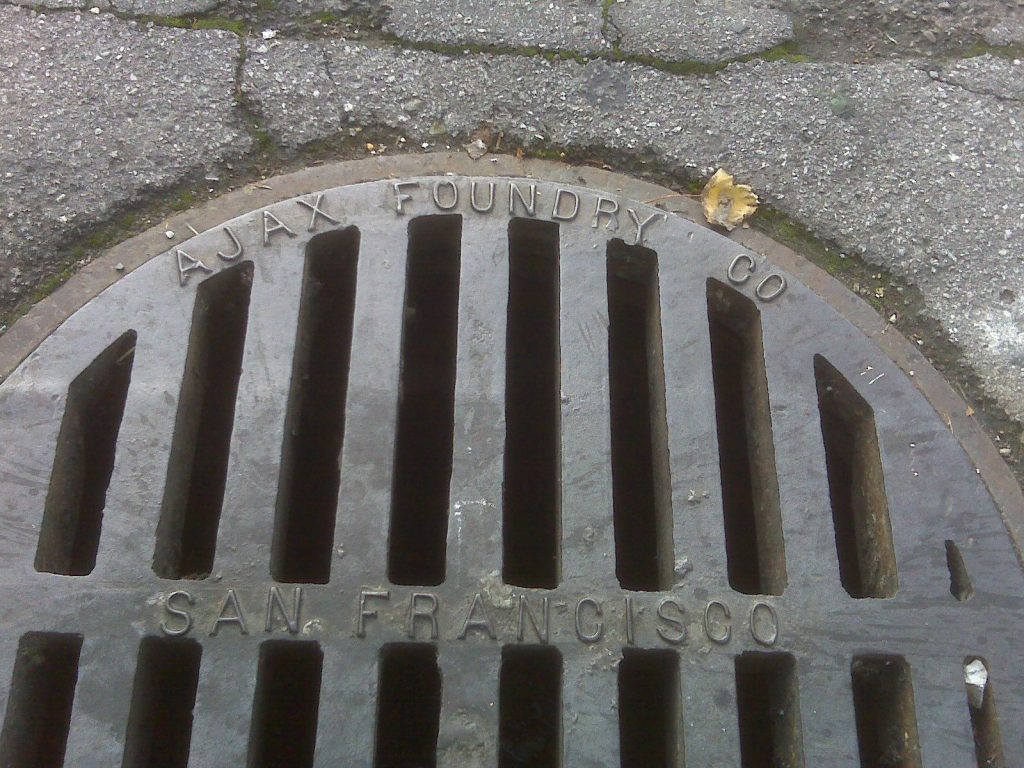
References from 1907-1924 show Ajax Brass and Iron Works at 45 (and later 60) Clementina
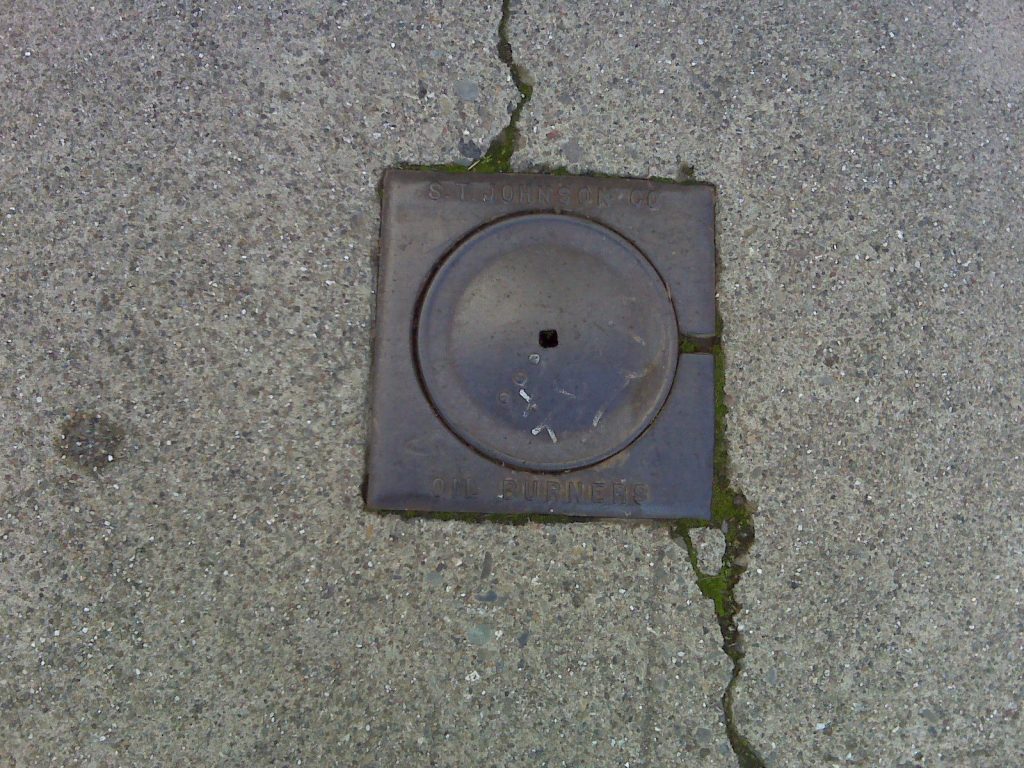
This company has been in business since 1903 and continues to make oil burners in Oakland
http://www.johnsonburners.com/
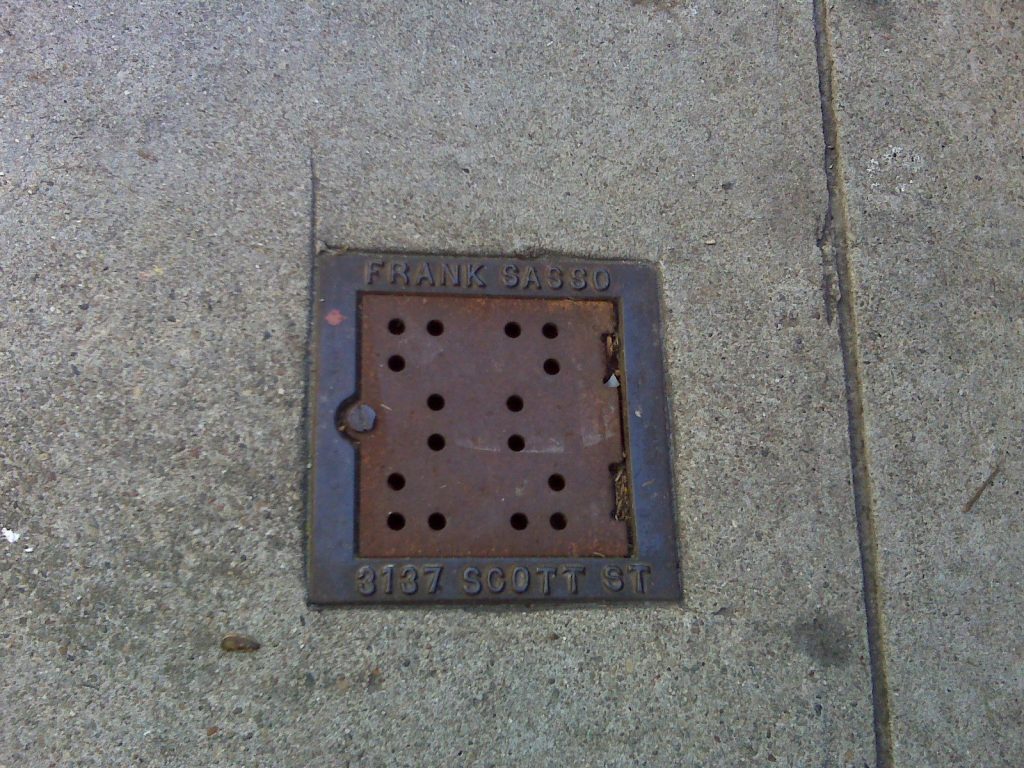
3137 Scott St’
sewer vent cover, Union and Pierce
References appear from 1921 to the early 60s. Don’t know for how long, but it is documented that he was using this address in the 1930s. This appear to be more modern than that.
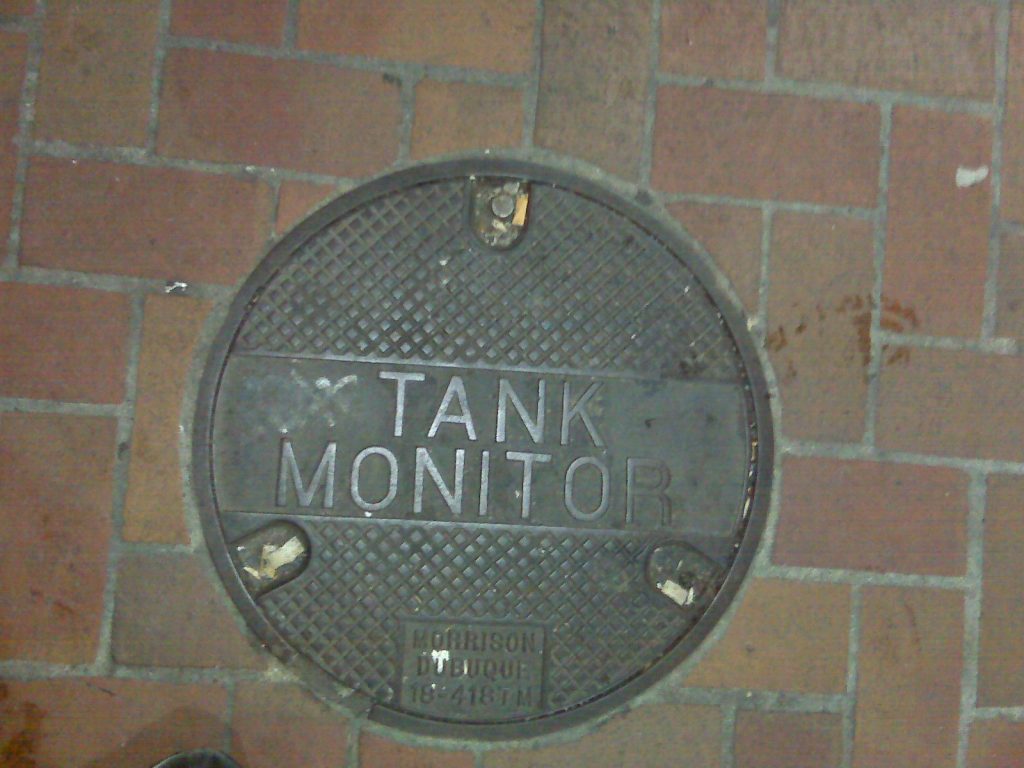
fuel oil monitoring well cover. Mission and 4th
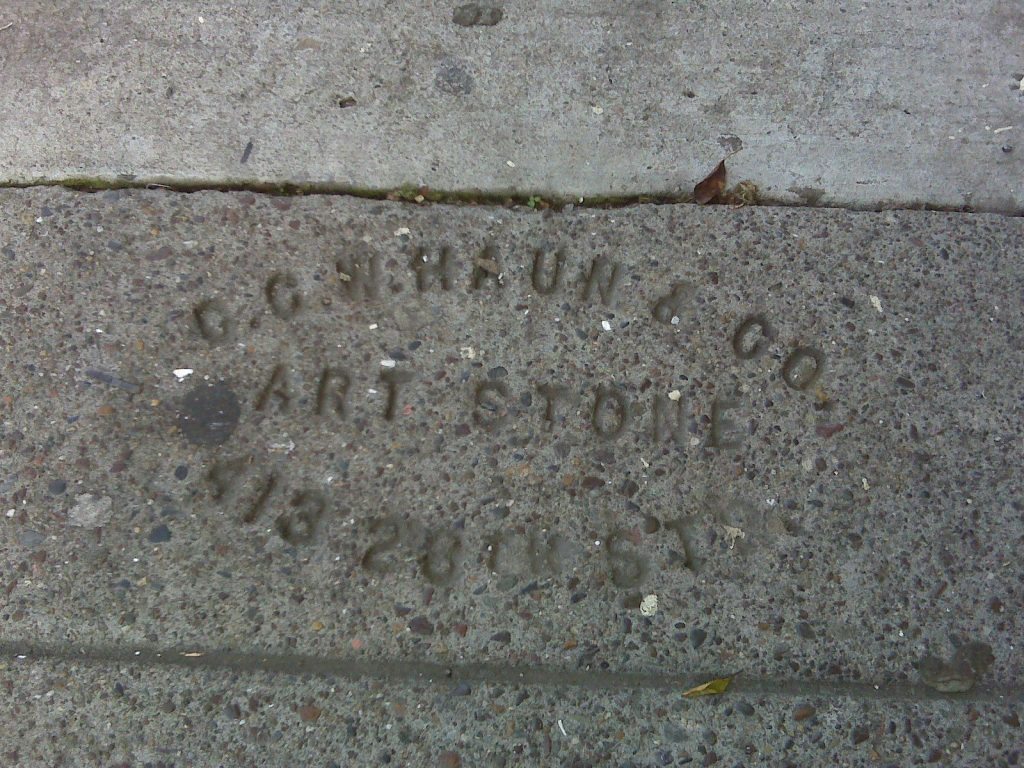
CCW Huan had a prolific career with many references from 1899-1930
He moved west from Minneapolis at some point after his son’s birth in 1885 and before 1899 when he first appeared in directory listings in San Francisco
(His son’s obituary states: ‘Died July 21 , 1962 George Cleveland Haun , the son of C. C. W. and Emma ( Wachsmuth ) Haun , was born in Minneapolis , Minn . , on April 18 , 1885)
A photo of him can be seen in the mixer ad from Cement World Magazine 1916:
https://www.google.com/books/edition/Cement_World/8uQfAQAAMAAJ?hl=en&gbpv=1&dq=C.+C.+W.+Haun&pg=RA6-PA6&printsec=frontcover
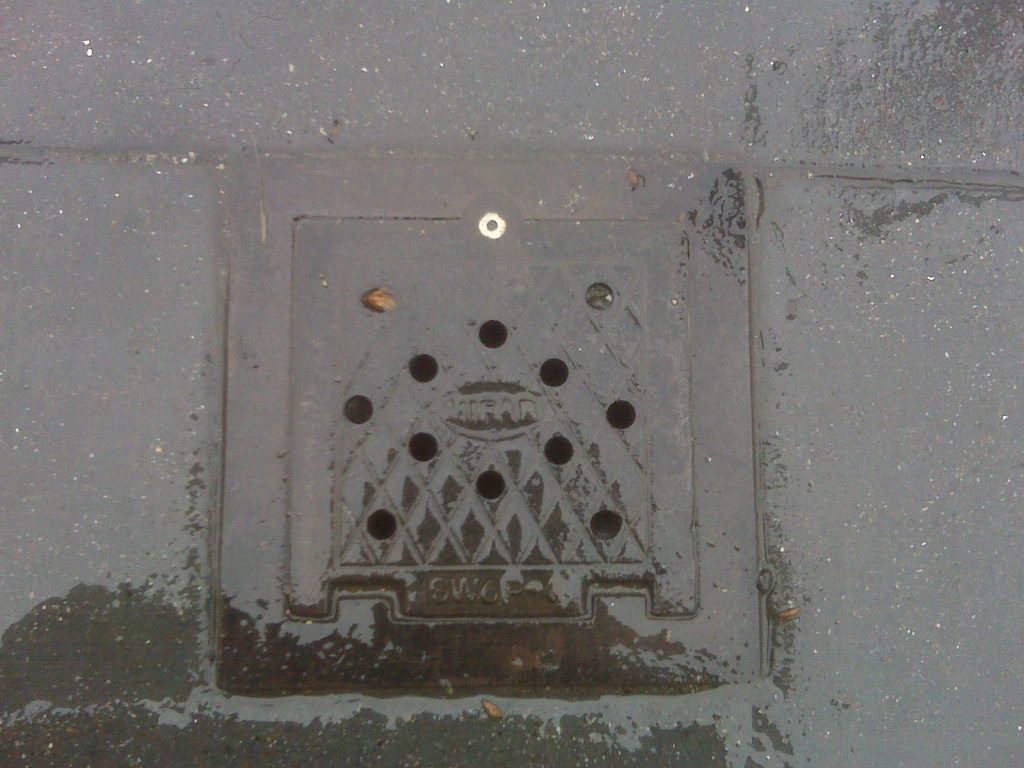
modern sewer vent cover. Eddy at Larkin
https://www.mifab.com/Catalog/Library/sw.pdf
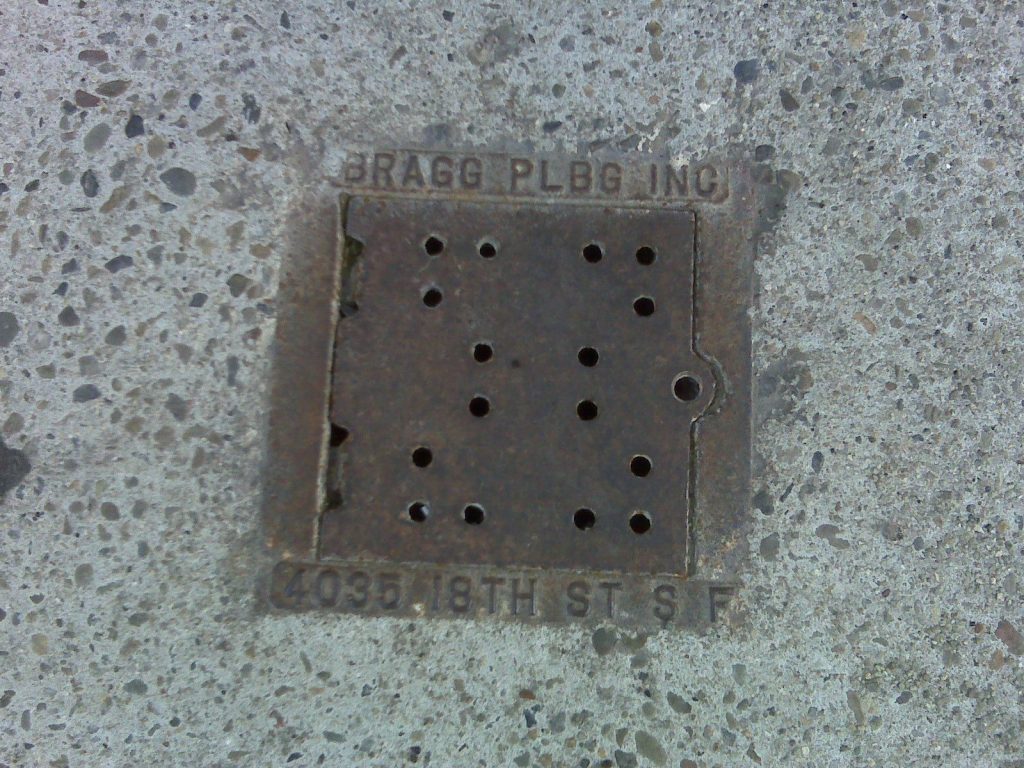
Referenced in the Official Directory, Licensed Contractors of California : 1977-79
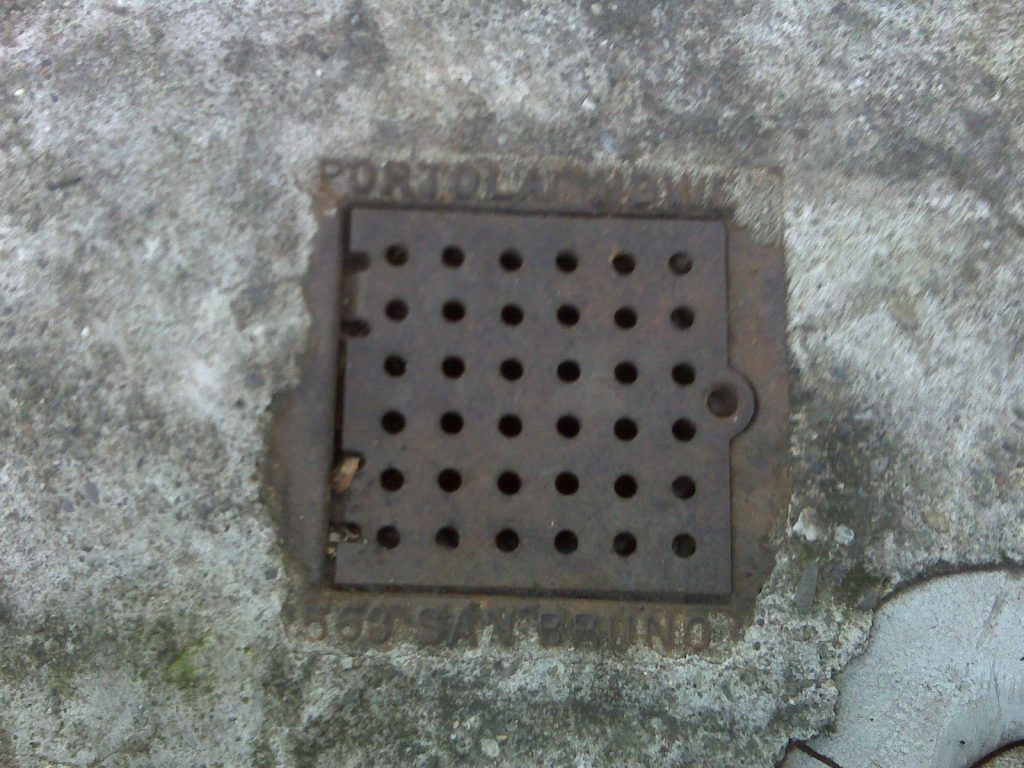
sewer vent cover. Precita and Emmett
references to Portola Hardware and Appliance can be found in the directory listings in the back pages of 1956 Look Magazine and in March 1960 Popular Science.
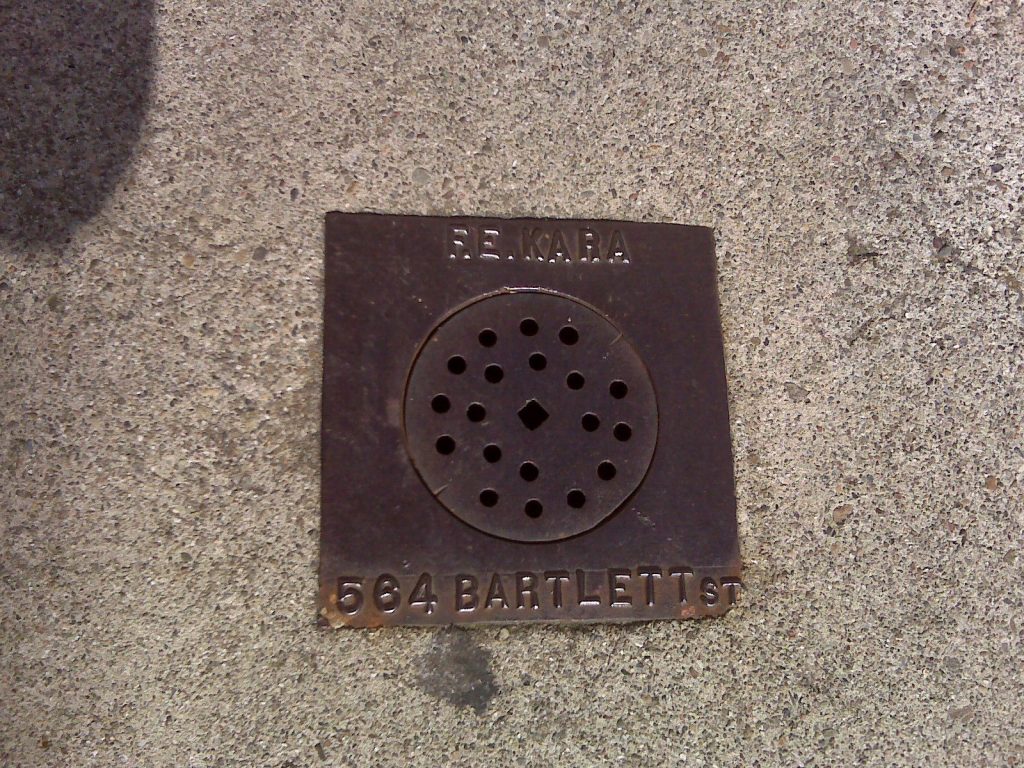
564 Bartlett’
Sewer vent cover. Union at Steiner
Frederick E, Kara was referenced in Crocker-Langley San Francisco Directory from 1890-1909
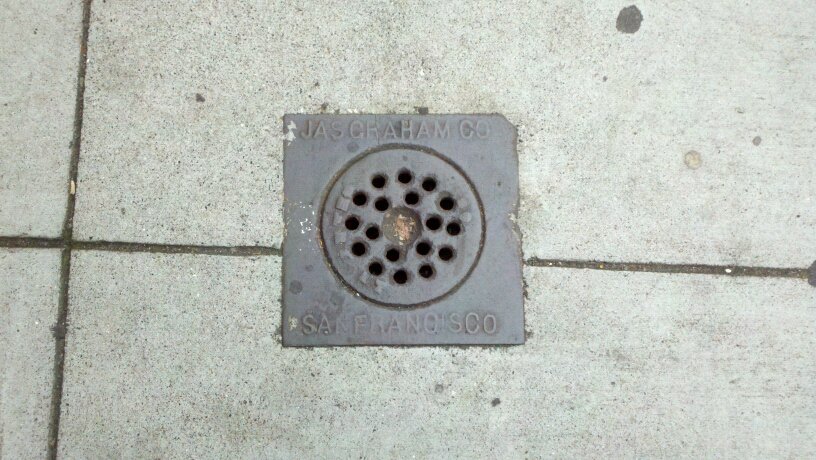
over sized sewer vent cover. Post and Polk
Not plumbing or concrete contractors but a foundry that manufactured plumbing and gas fittings. Trade publication references date from 1914- 1932
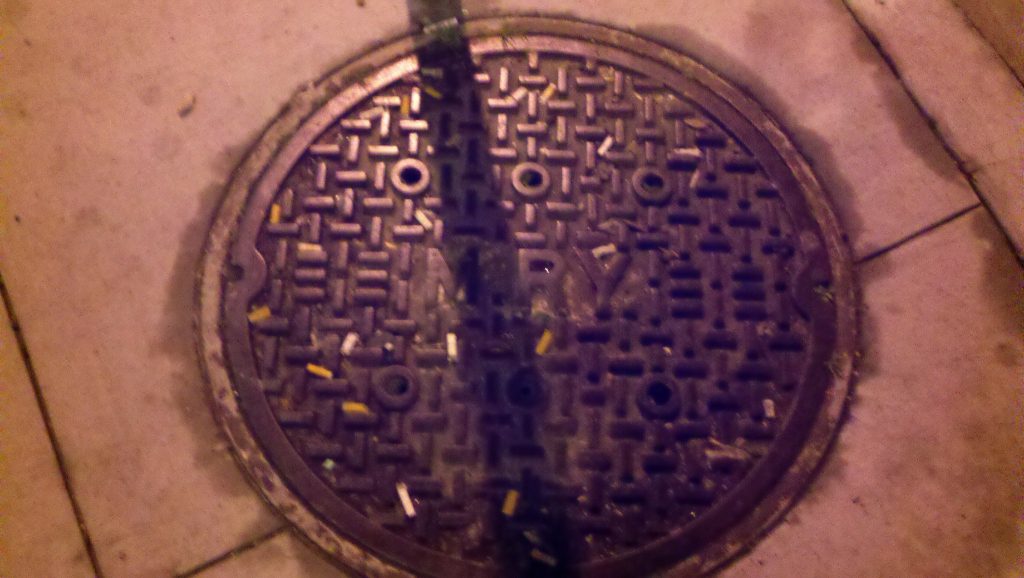
Research as I might, I cannot place this one. It appears to be from the teens. The abbreviation Ry was common for Railroads (as in B & O Ry Co, Baltimore and Ohio Railroad Company) so presumably this manhole services Municipal Railway or ‘Muni’
What Muni does or did with an underground utility in the middle of Harrison St. I do not understand.???
http://en.wikipedia.org/wiki/San_Francisco_Municipal_Railway
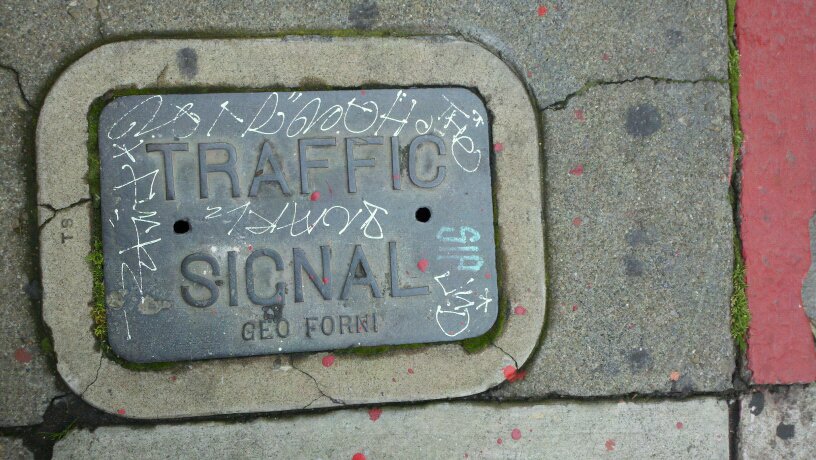
Post and Van Ness
These boxes are pretty ubiquitous, and all I’ve seen are fabricated by Geo Forni in Emeryville from plastic or fiberglass resin. This cast metal is the first I’ve seen.
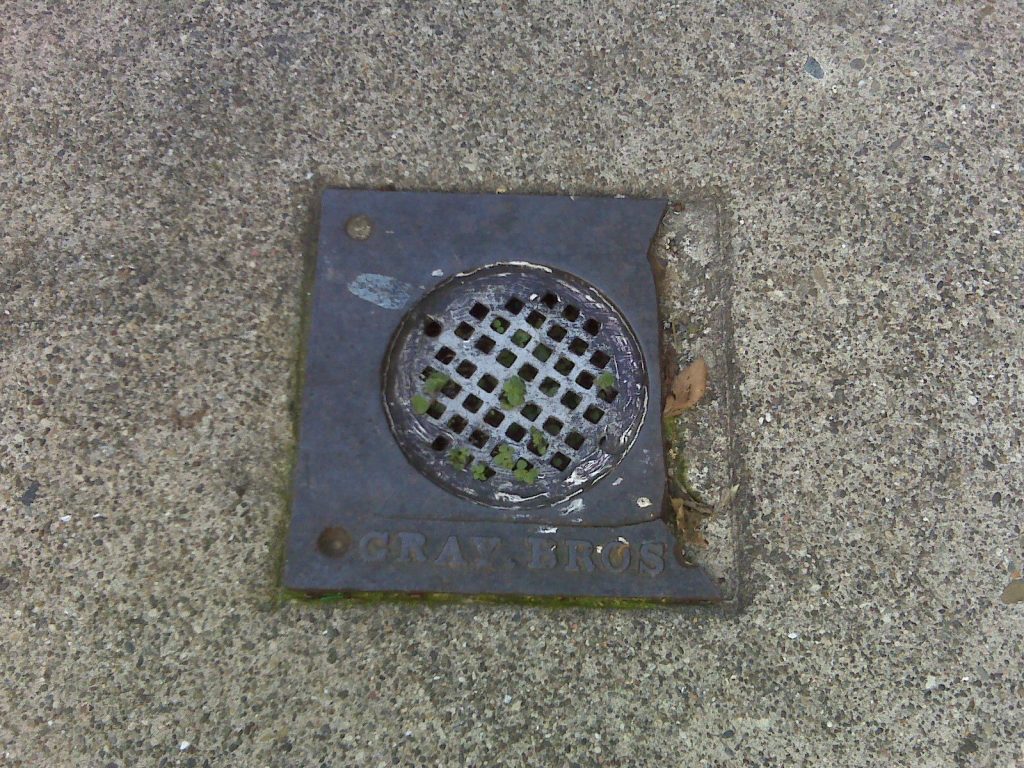
Sewer vent cover. Capp and 24th
This is wild: In 1905 they built the sea walls between King and Channel along the Mission Bay Canal that is still in use today. They quarried the stones used to build the wall at 30th and Castro using dynomite. On multiple occasions, the explosions rained rocks down on the houses next door damaging the houses and nearly killing the neighbors. Their rock crushing machines created dust that permeated all the nearby houses ruining the curtains, carpets and furnishings.
They did nothing to mitigate erosion of the mine tailings which blew and washed into the sidewalks, streets and sewers. The tailings run off created 6′ deep mud flows that washed up against the neighboring buildings and filled the sewers which made the neighboring buildings sewage back up into their houses!.
AND they brothers were assholes when the neighbors tried to talk to them! The neighbors had to sue in a drawn out battle to get them to stop and cover damages.
In 1905, they were paid $69,620 ($2,357,680 in 2022 dollars) to build the seawall and paid out $6,509 ($220,425 in 2022 dollars) in damages to the neighbors. Can you believe? …the drama!
The Pacific Reporter – Volume 79 1905 reports the lawsuit details .
https://www.google.com/books/edition/The_Pacific_Reporter/MULwP3V4QEkC?hl=en&gbpv=1&dq=Gray+Bros&pg=PA523&printsec=frontcover
The ledgers of the Report of the board of State Harbor Commissioners 1905 record the payments made to the Gray Brothers.
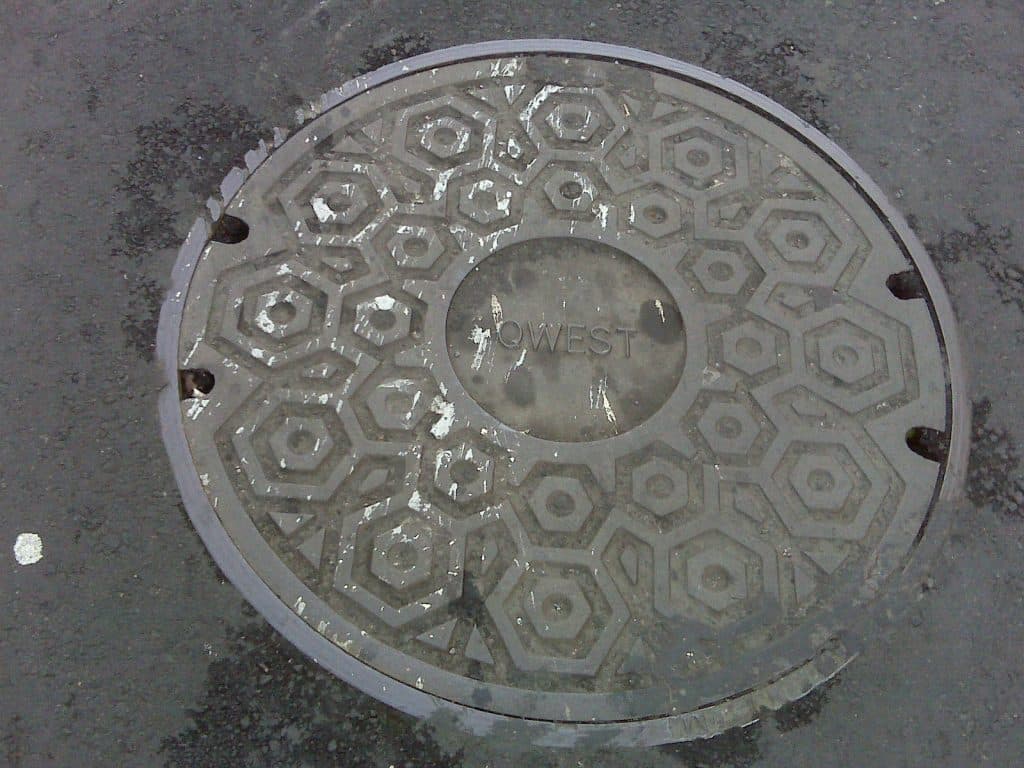
Now obsolete in San Francisco, Qwest still offers bundled telecommunication services in some Midwest and western states. http://en.wikipedia.org/wiki/Qwest
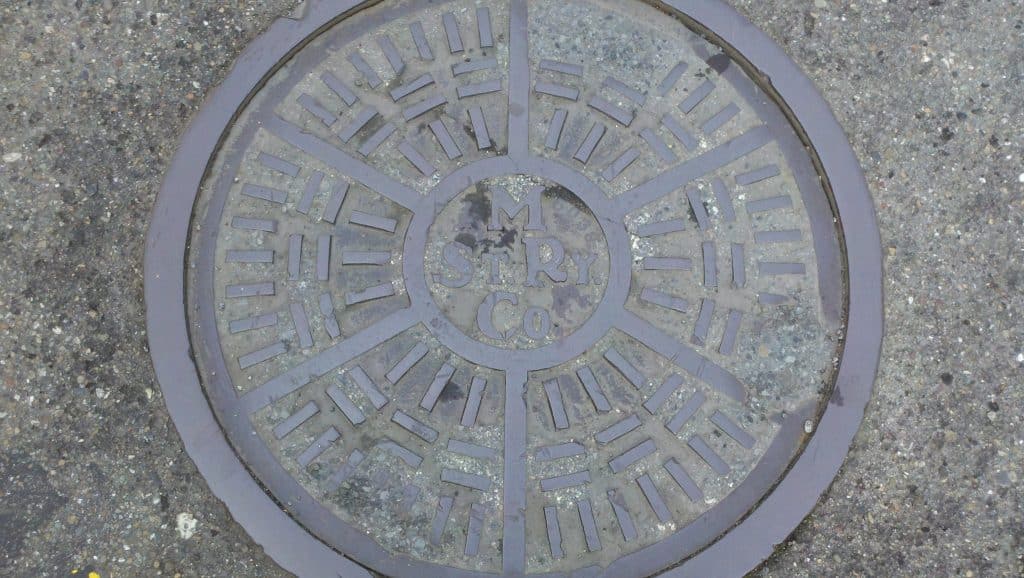
In operation from 1857- 1944 when it was absorbed into Muni
http://streetcar.org/about/history.html
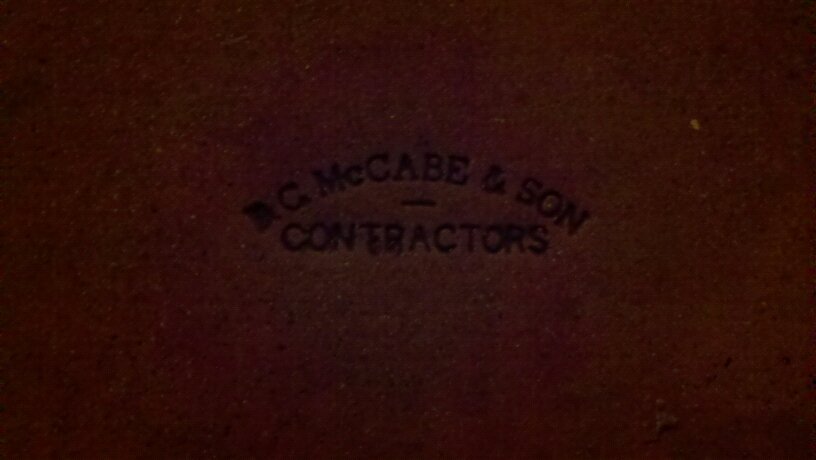
patent stamp. Gough and Market
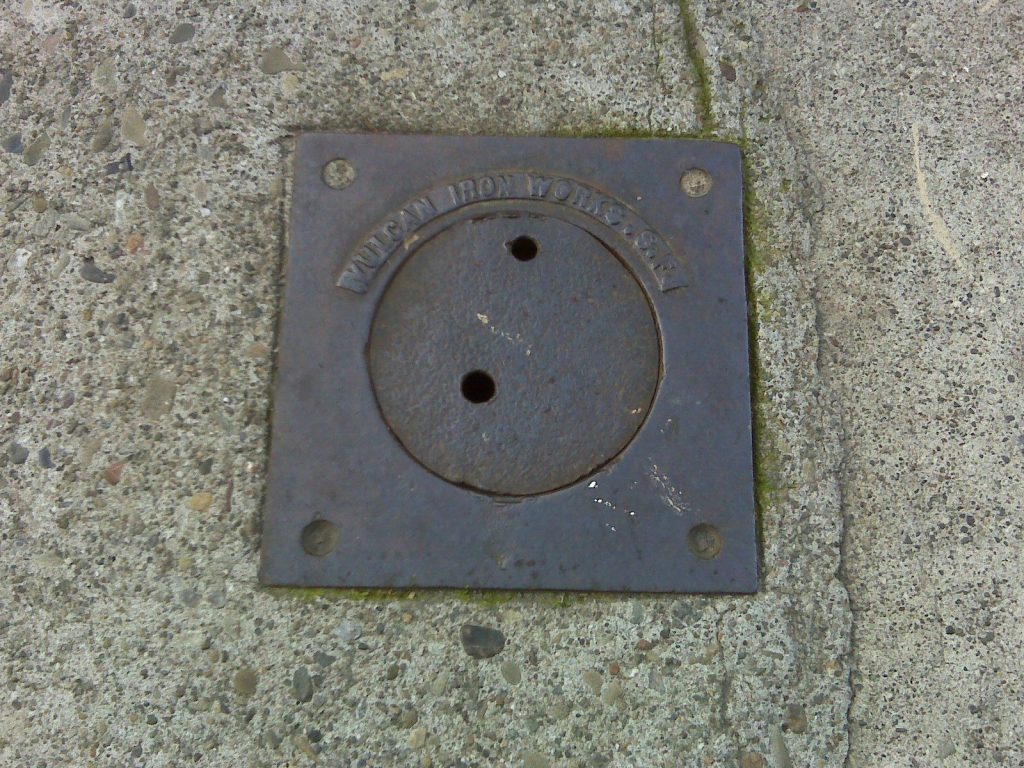
This San Francisco iron company specialized in manufacturing train locomotives and even manufactured the first refrigeration machines for Gambrinas Brewing Co. in Portland Oregon in 1893
A fellow who worked for Volcan in 1906 recounted his experience of the earthquake and firestorm http://www.sfmuseum.org/1906/ew20.html
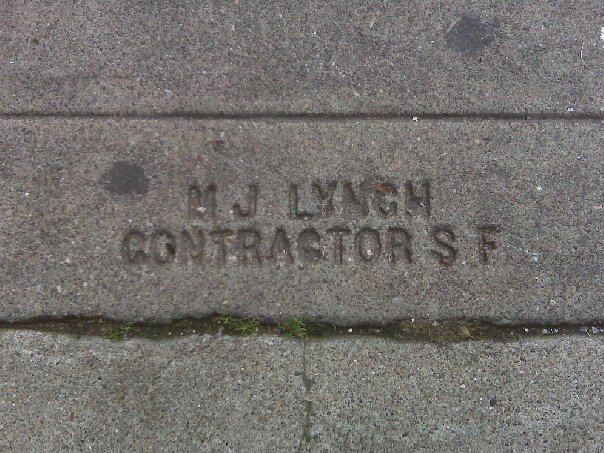
contractor patent stamp. Franconia and Mullen
An undated version of this contractor’s stamp. He was active in the middle of the last century with references ranging from the 1930s-1960s. His office was in the Bayshore. See dated version above.
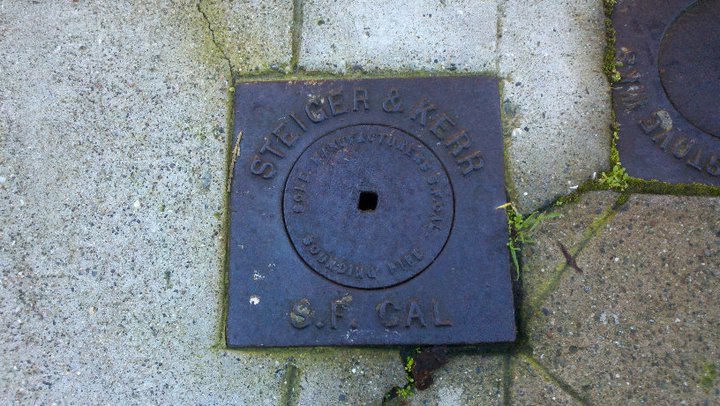
I’m not sure if this is ship hardware used as a sewer vent cover or just it actually serves as a ‘sounding pipe’.
‘Sounding pipe’ is used to check the level of a liquid or oil in a ship’s tank. Possibly there is a tank here, but generally in ground tanks have ‘monitoring wells’ conceptually they are the same so it is possible that the ship hardware was used. Just as likely, it’s ship hardware used for a sewer vent
This company has trade references published as early as 1896 and as late as 1932. The foundry specialized in stoves.
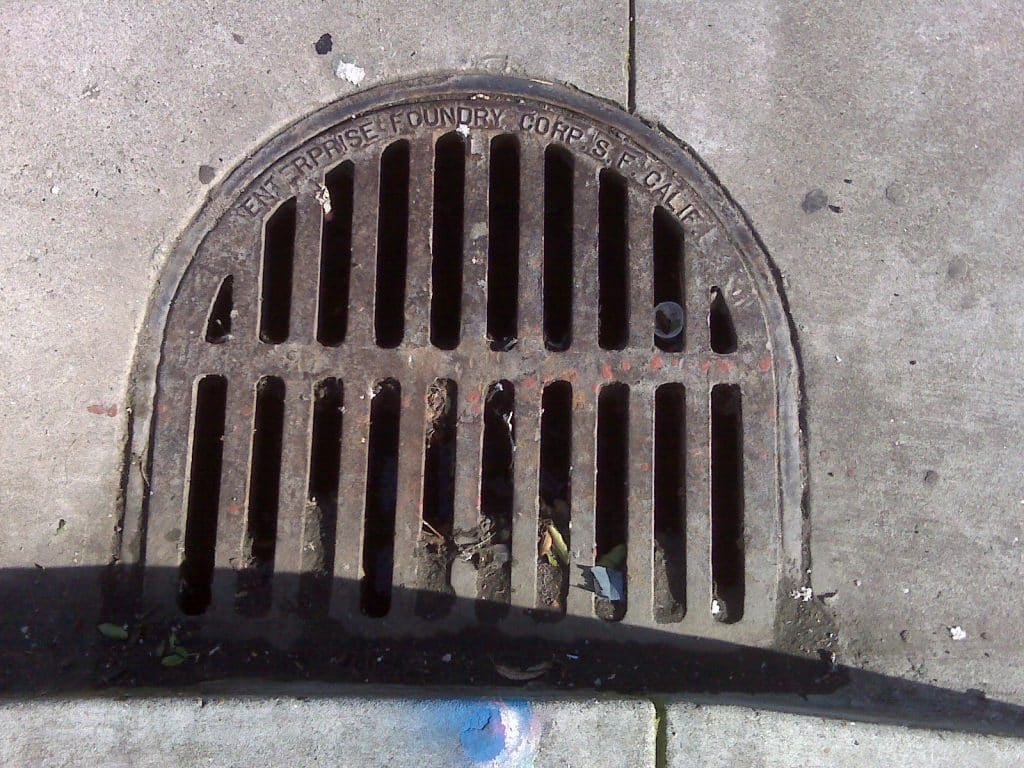
Enterprise foundry specialized in machine parts and engines. In the wake of the 1906 earthquake, the foundry shifted to service the more pressing need of rebuilding and forged construction materials. This company continues to manufacture marine diesel engines in the Bay Area
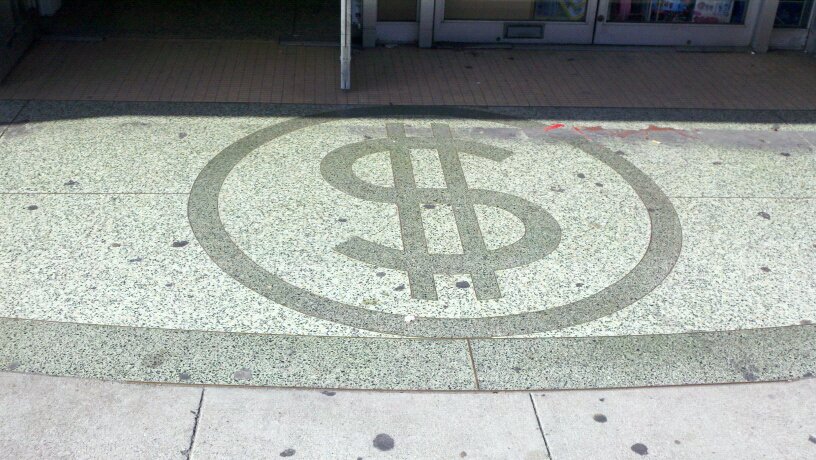
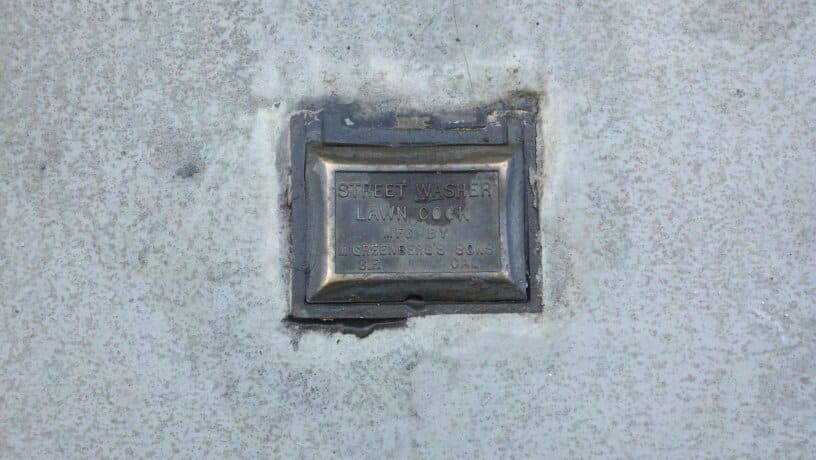
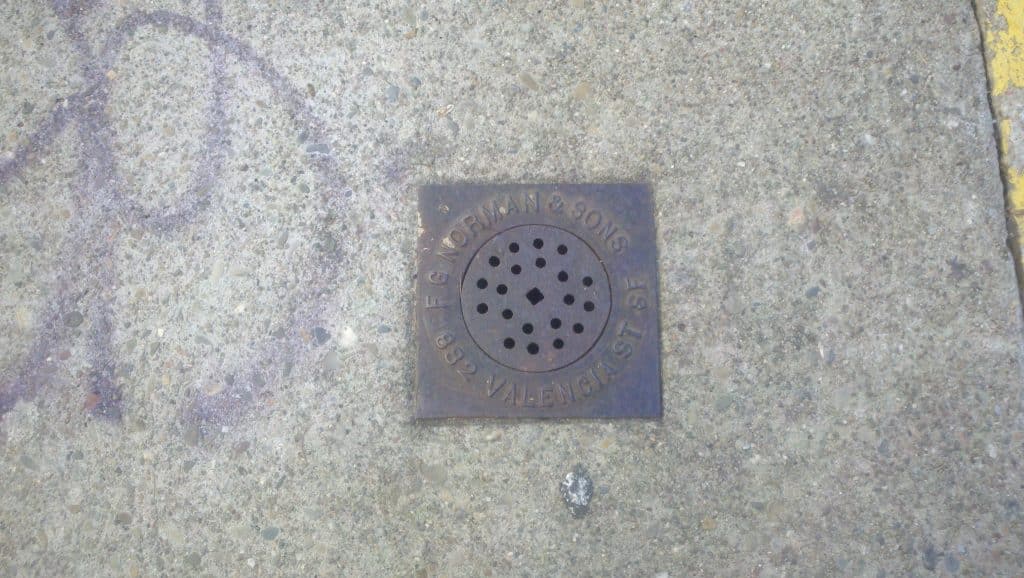
Sever vent cover. 20th and Valencia
I found an 1893 newspaper article that documents a court case that this company was involved in. This company along with 9 other construction companies sued the ‘French Church’ for not paying its construction bills!!! The church is still there today.
http://www.ndvsf.org/church/
http://books.google.com/books?id=-ho8AAAAIAAJ&pg=PA914&dq=F+G+Norman&hl=en&ei=v4o_TcDpG4j4swOFq6yVCA&sa=X&oi=book_result&ct=result&resnum=3&ved=0CC8Q6AEwAg#v=onepage&q=F%20G%20Norman&f=false
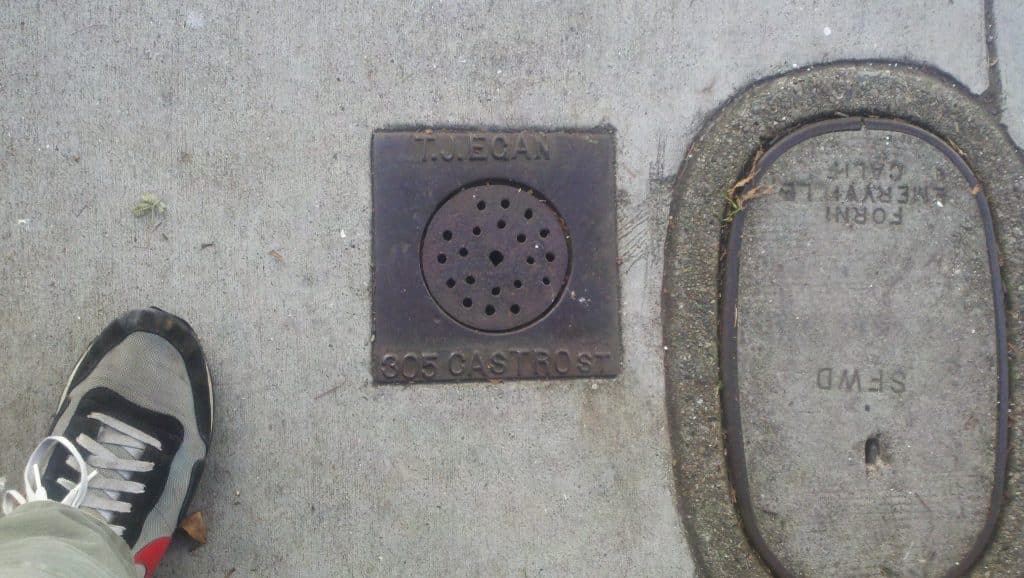
I found an interesting incongruity. I found a 1907 directory listing this contractor’s address as 503 Castro. The iron casting here clearly reads 305 Castro. How funny to discover a 100 year old typo. I wonder if he got his money back for the listing (or worse, was the typo in the metal casting?). I wonder if he Karened out over it.
http://books.google.com/books?id=HwM1AAAAIAAJ&pg=PA874&dq=T.+J.+Egan+plumber&hl=en&ei=pYI_TfqrM5D2swOKovyJBQ&sa=X&oi=book_result&ct=result&resnum=1&ved=0CDsQ6AEwAA#v=onepage&q=T.%20J.%20Egan%20plumber&f=false
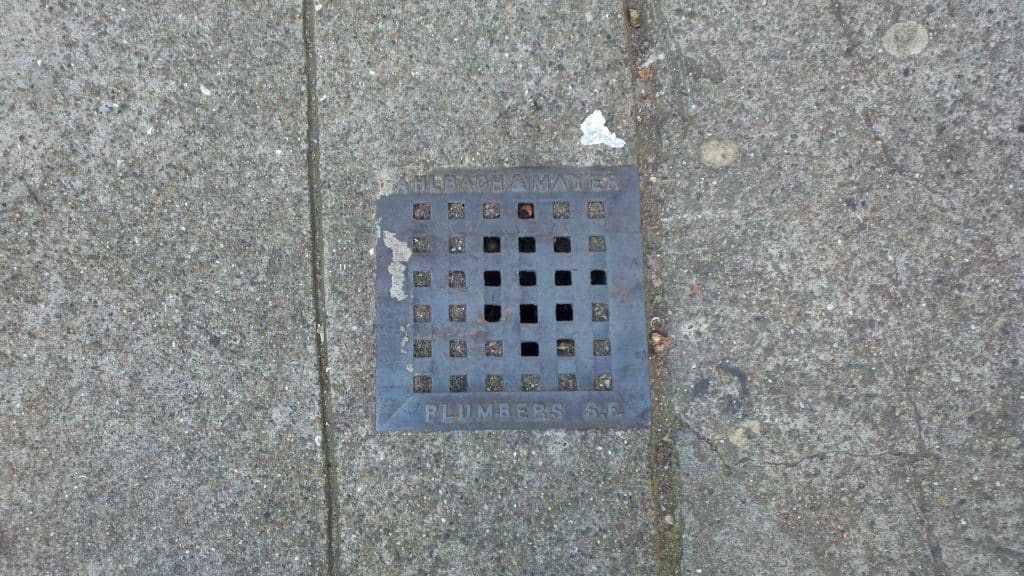
Sewer vent cover. Mission at 23d
Joseph Ahlbach of the firm of Ahlbach & Mayer was elected president of the California Sanitation Development League in 1926.
Many trade and directory listings can be found from 1907-1929
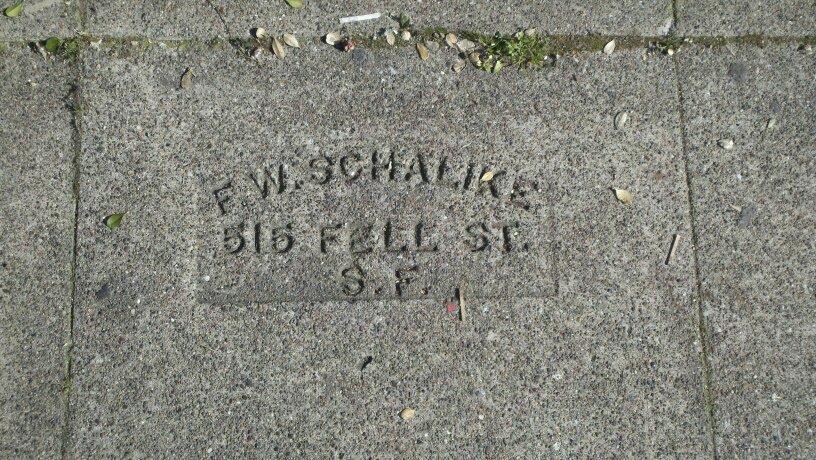
I found municipal reports referencing this contractor dated 1890
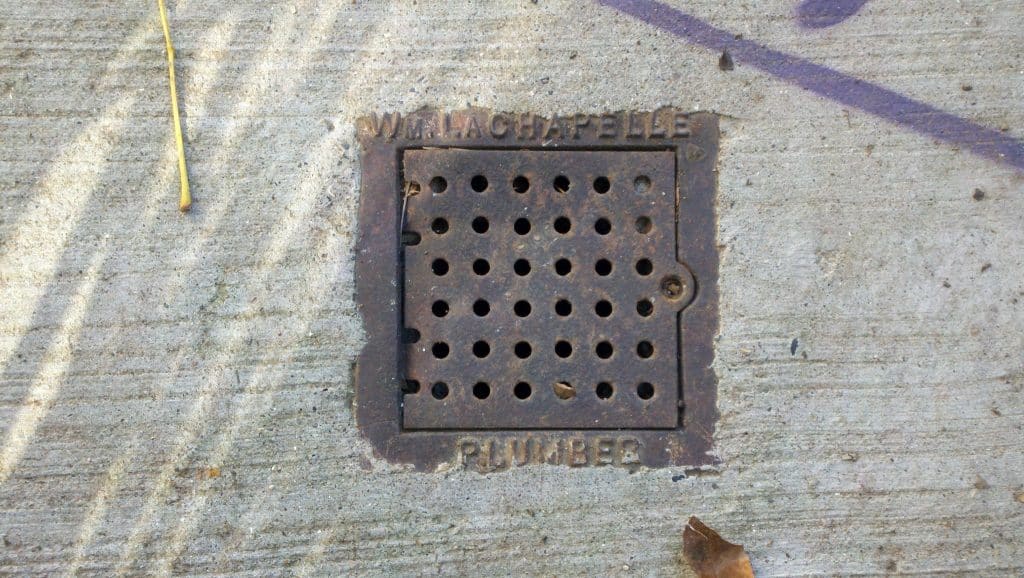
This contractors has references in trade publications from the turn of the last century and early teens. There are also references to a plumbing and heating company in San Francisco operating under the same name in the 1950s. Whether the latter is a continuation of a single person or a family company I cannot tell
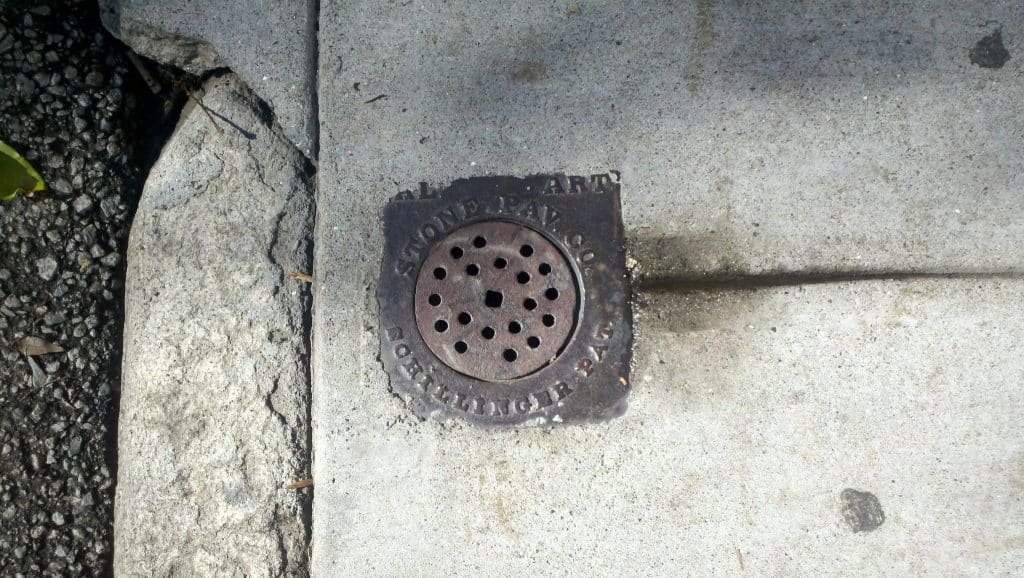
I found references for this company beginning in 1886 which is consistent with the context of this vent. It is on the historic Liberty Hill district where some of San Francisco’s earliest remaining large homes can be found.
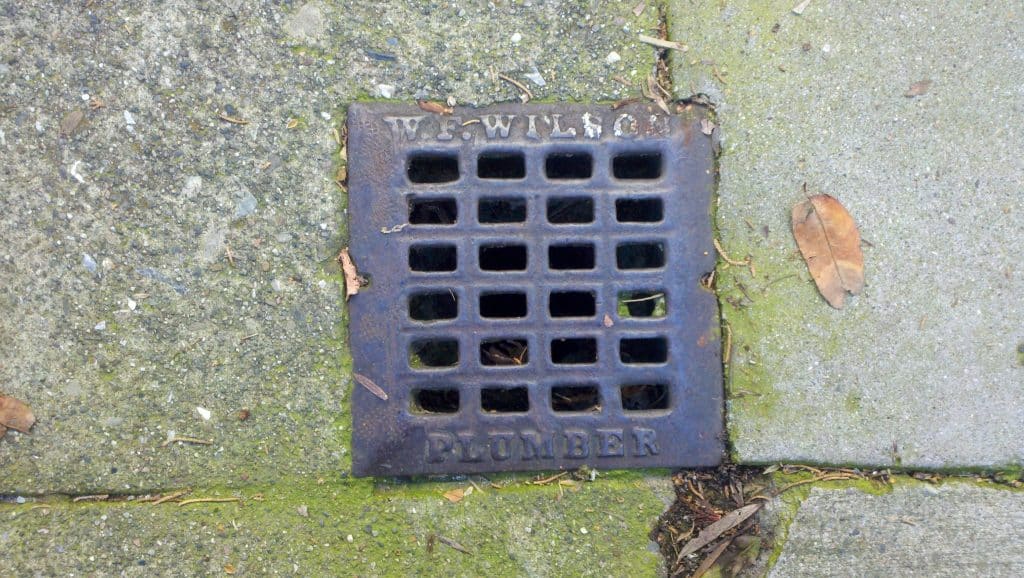
I found some of the earliest references of any plumber for this guy. His references in trade journals begin in 1876 and run into the turn of the century. He did some large commercial jobs and was well known.
These references are consistent with the context of this vent. It is in front of the earliest and oldest Italianate mansion I know of in town on Liberty Hill
Italianate was the first and simplest of Victorian domestic architectural aesthetics, as seen in San Francisco anyway. It was popular from the 1840-1880s in America but most popular from the 1840s – 1860s in San Francisco. Many of these early homes were lost in the fire of 1906
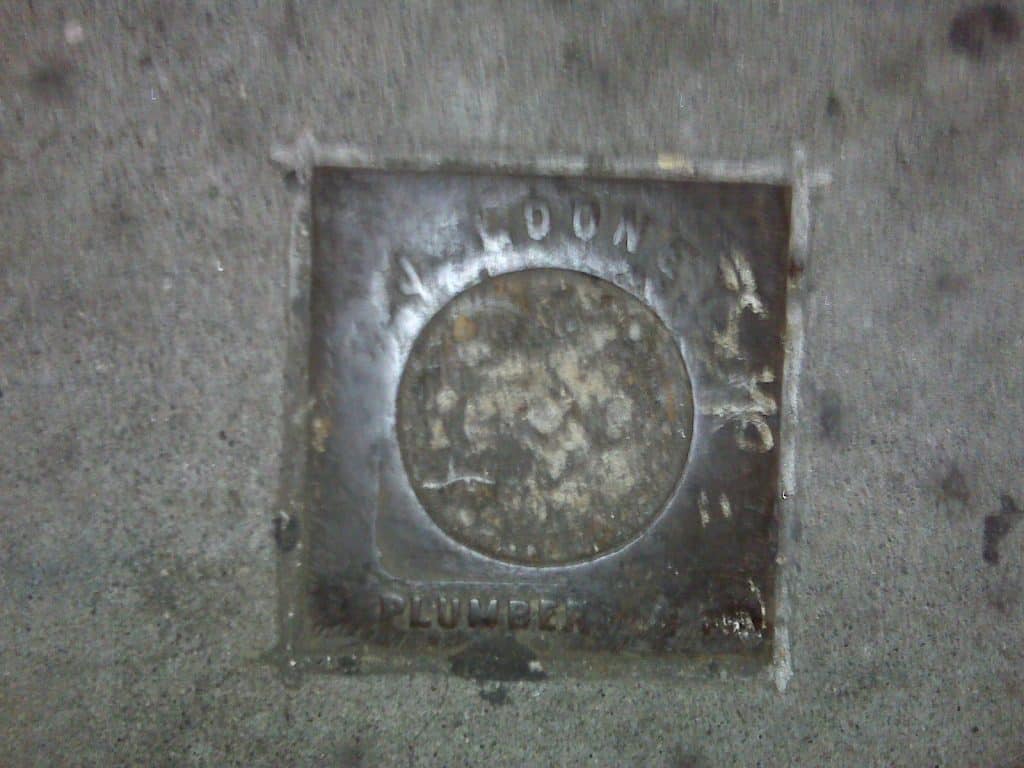
filled in sewer vent . Mission and 4th.
He was well referenced from 1902-1915
in Domestic Engineering and the Journal of Mechanical Contracting
1914
“The J. Looney Co. , has secured the plumbing contract for the Main Entrace (sic) Tower at the Panama – Pacific Exposition grounds for $4,945” ($147,400 in 2022 dollars)
For more on the Panama – Pacific Exposition of 1915 see the https://en.wikipedia.org/wiki/Panama%E2%80%93Pacific_International_Exposition
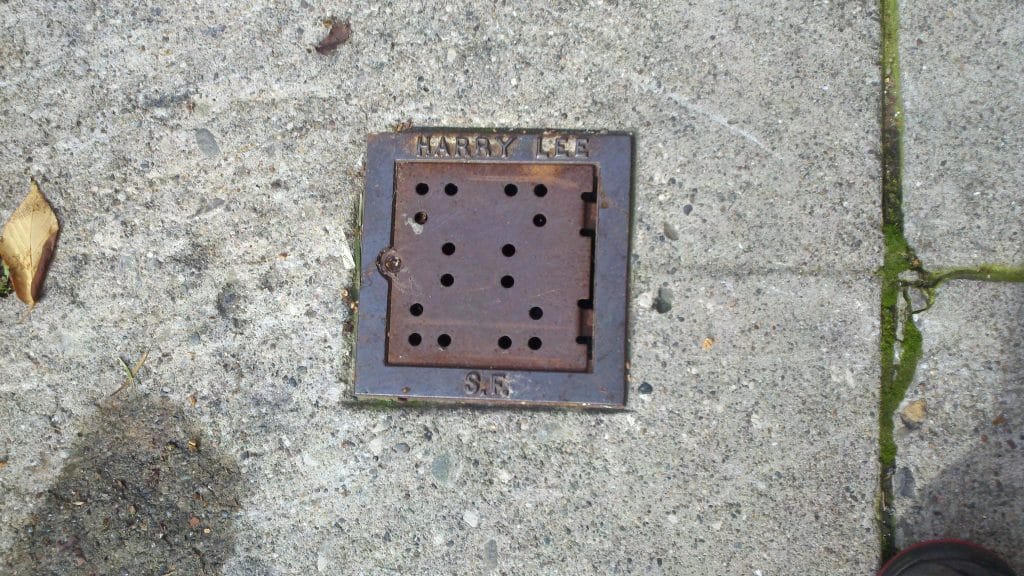
sewer vent cover. Capp at 23d
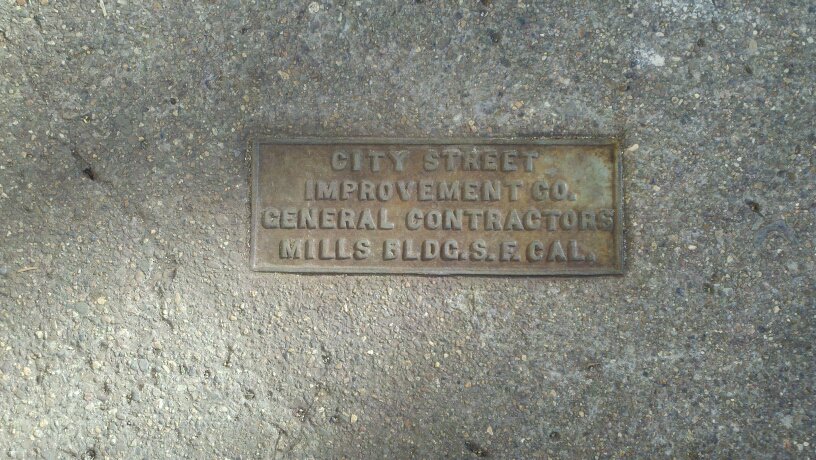
Improvement Co.
General Contractors
Mill BLDG S.F. Cal.’
brass patent stamp. Duncan at San Jose
Many references exist. The company was awarded San Francisco contracts in 1911 and 1912
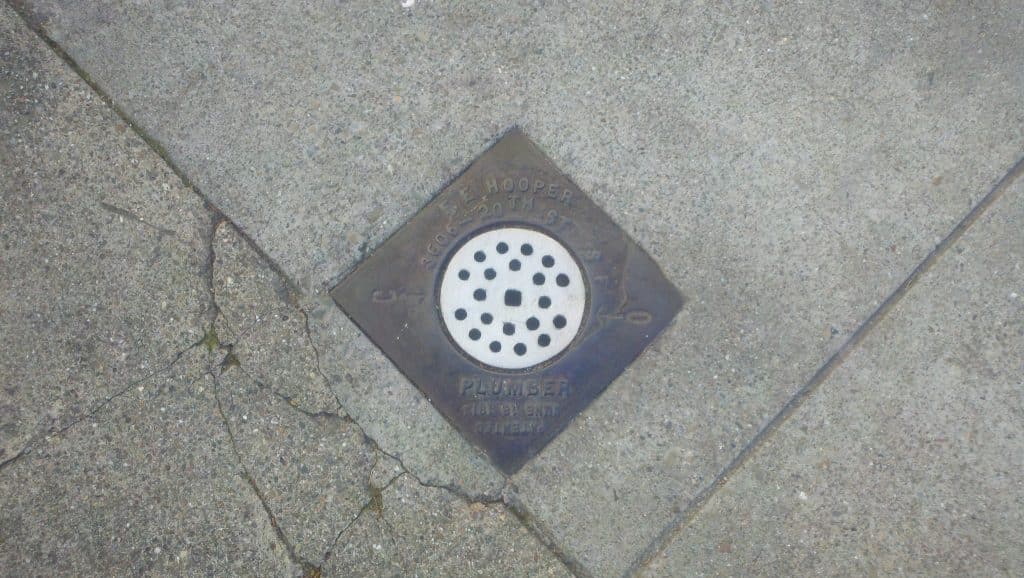
Sewer vent cover, 20th and Valencia.
Unique in that it has a patented feature whereby the cover (now missing and replaced) could be rotated to open or close. Usually the opening cover in older examples rests in place and can be secured if at all with a screw. More modern covers are hinged. This feature apparently didn’t take off. Was Hooper disappointed his innovation wasn’t a hit?
This plumber also ended up owning a foundry that manufactured plumbing and steam fittings and documented by this vent cover and also in the Domestic engineering and the journal of mechanical contracting, Volume 59 (dated June 29th, 1912) which notes:
‘A contract for ‘The plumbing and steam fitting work on the three-story building at Market and Taylor streets, JK Prior Estate, owner, has been awarded to FE Hooper for $3584.’ ($110,110 in 2022 dollars)
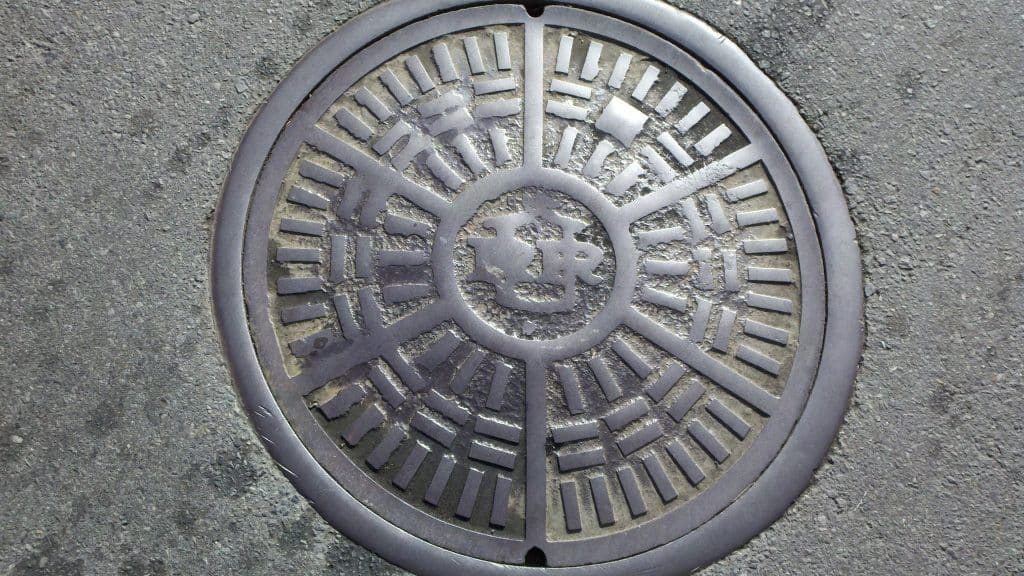
Union Railroads operated under many names including Market Street Railroad Company (a horsedrawn incarnation began in 1857), and Market Street Cable Railway Company (the name after the company converted to cable drawn cars beginning in 1882).
The electrically powered company operated as Union Railroads from the turn of the century and most of the teens until 1918 when is became Market Street Railway (the company that operated the vintage cars that run on Market today).
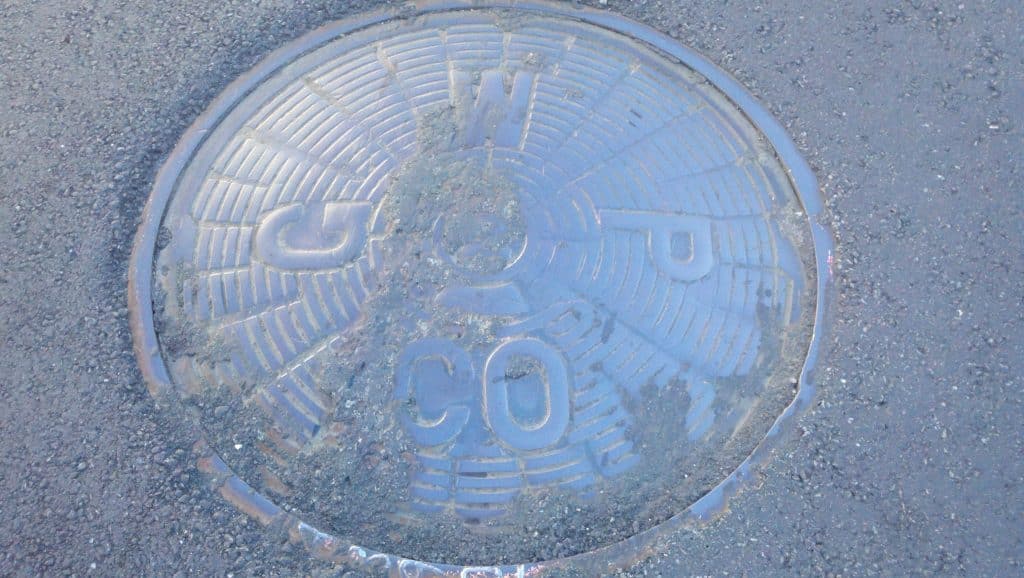
Initially this one proved vexing. I could find no references that GWP Co had been producing power in San Francisco’s early years and no other power companies have operated in SF since PG&E came into existence in 1906. A few obscure references helped me to piece together what I imagine GWP Co was doing here.
Starting in the teens, Great Western Power Company began snapping up California water rights and building hydro-electric dams. (The latter is fact, the following is conjecture) The company sold the power it created wholesale. This power was then conveyed to San Francisco where it was bought and then distributed by PG&E.
As the city grew it became less practical to produce power within its confines while developing electrical infrastructure facilitated the transmission of power from more distant places of generation.
GWP Co itself was bought by PG&E in 1930 shortly after this manhole cover was put in place.
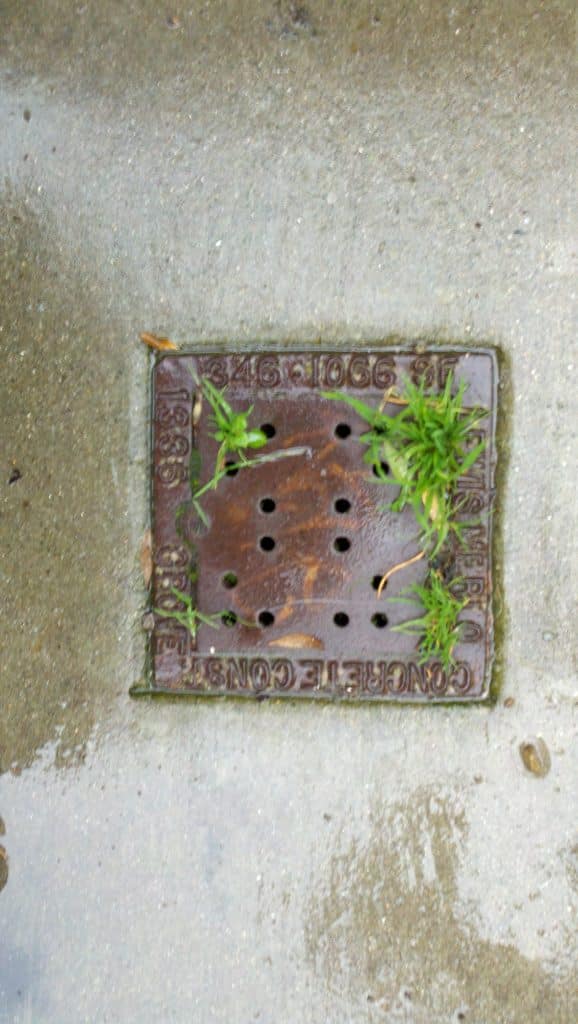
Concrete Const. 1336 Grove,
346-1066 SF’
sewer vent cover. Folsom and Precita
Still in business today after 100+ years using this address and phone number http://www.merloinc.com/
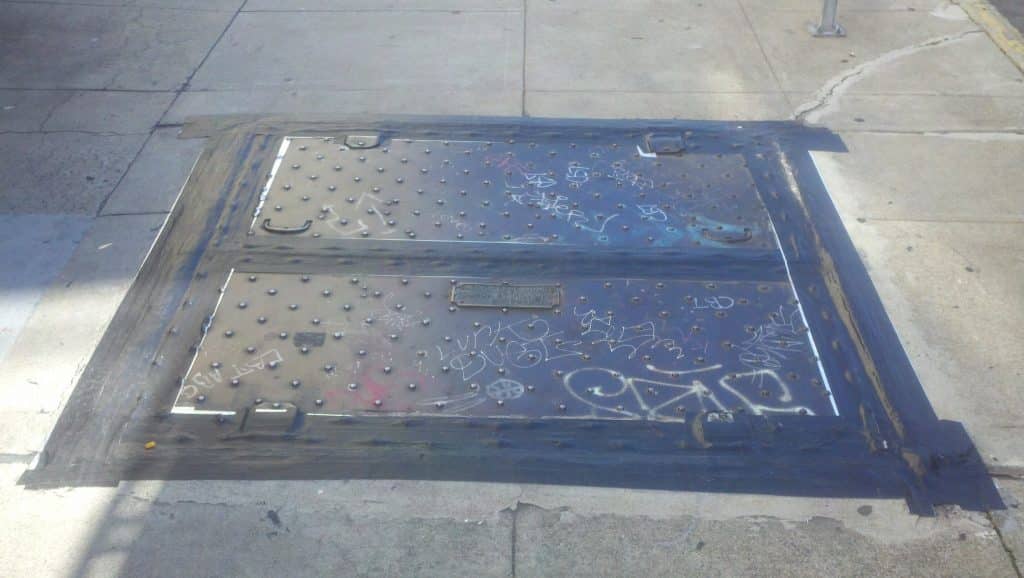
Judging from the heavy application of roofing tape, these doors haven’t lived up to their ‘leak proof’ claim.
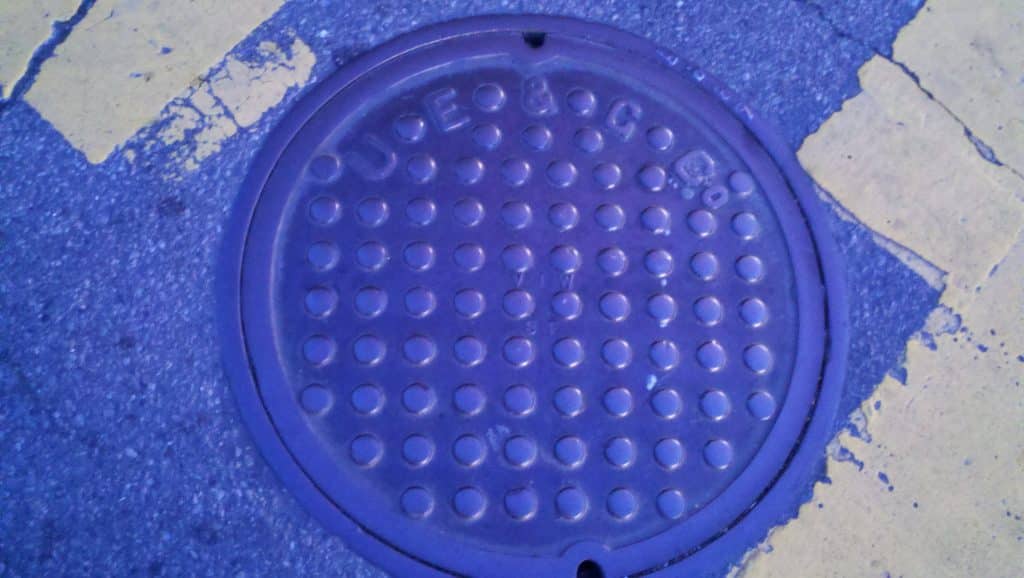
rare manhole cover. Capp at 21st
Very few references exist today so I can’t say when Universal Electric and Gas was founded. It is referenced as early as 1912. It was acquired by Great Western Power in 1922. Great Western was then acquired by PG&E in 1930
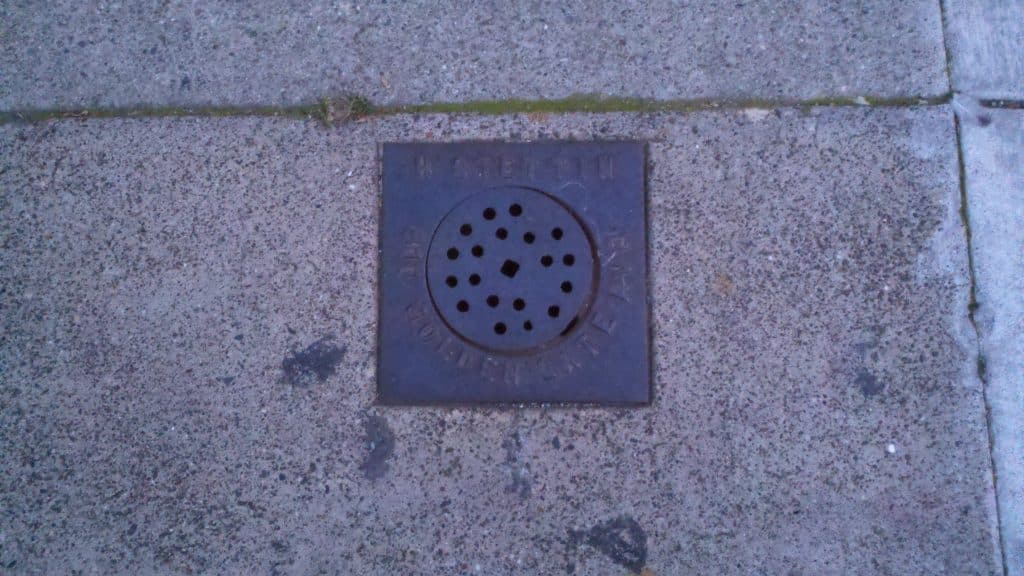
Sewer vent cover. Capp at 22d
Directory listing for “Stettin Herman , r artificial stone contractor” exist from 1890-1909 but only at the address above in 1890 so this vent must be dated to the earliest part of his career. He moved to 815 Cole with his sons by 1899. Herman’s wife was an accomplished embroideress and teacher. Her own needle work is well referenced in 1876-1978 She is listed in the directory in 1890 as an embroidery teacher but not again so perhaps she didn’t survive to see the family’s new house on Cole.
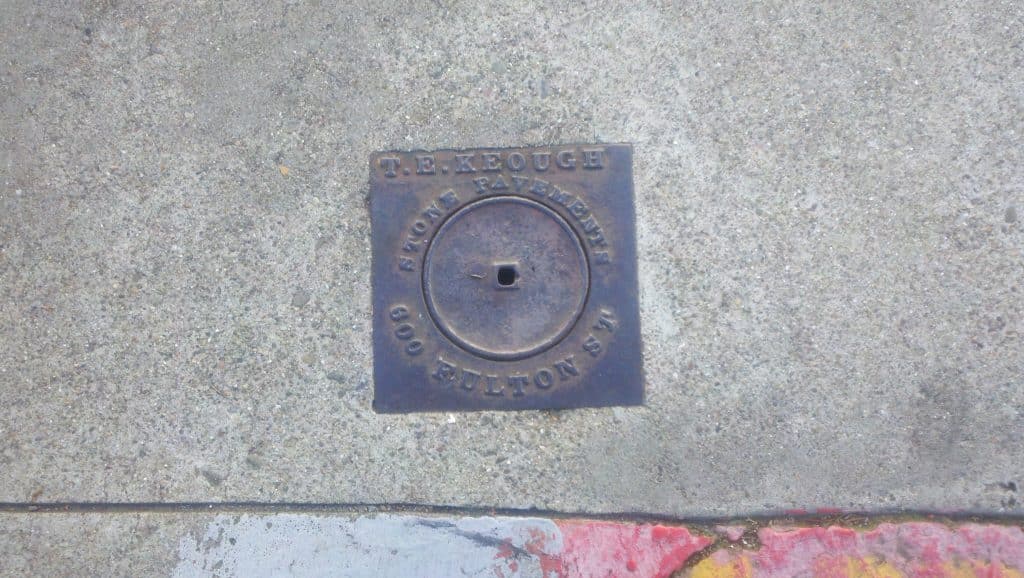
Sewer vent cover. 20th and Valencia
There are lots of turn of the century references to this contractor including documentation his election as the president of the trade organization ‘Cement Workers of California’ in 1907
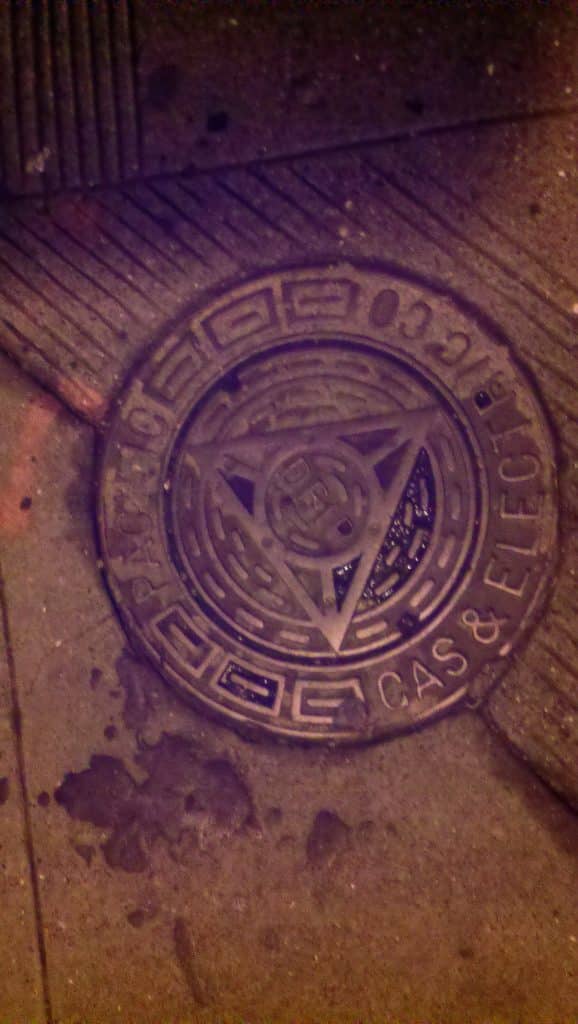
This well is used to clear the low grade natural gasoline that condenses out of natural gas inside the pipeline. It is collected and used as a solvent. At one time it was used as a fuel in automobiles in the place of refined gasoline.
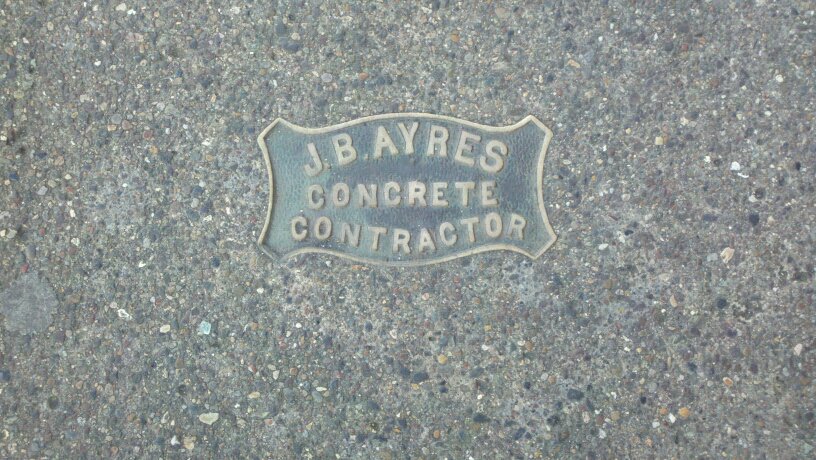
BRASS patent stamp! Howard and 5th
referenced in trade journal in 1907
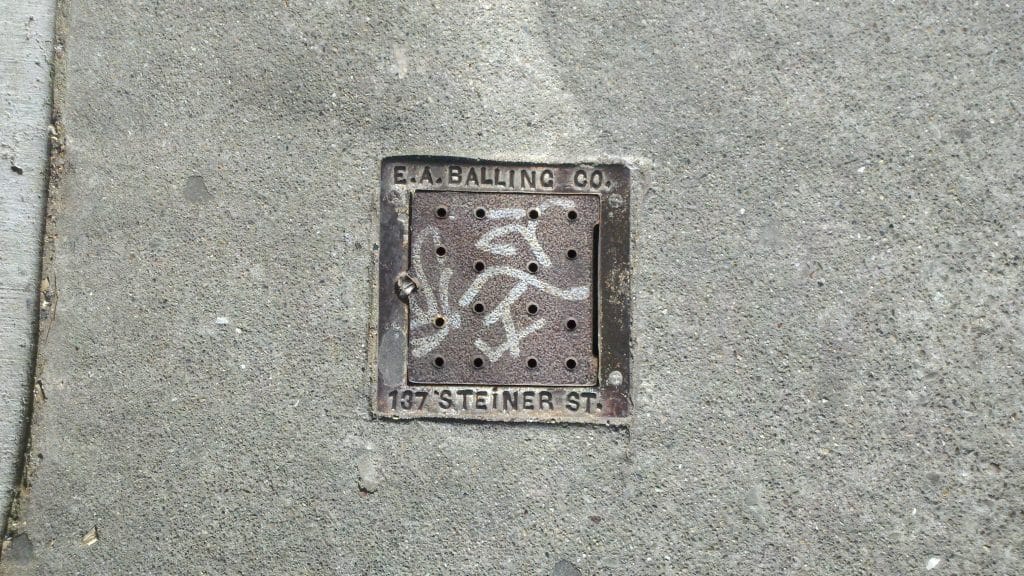
Trade and directory listings from 1918-1959. This vent is from the latter part of his long career when his address is listed as on Steiner. In 1918 he was listed at 819 Haight st.
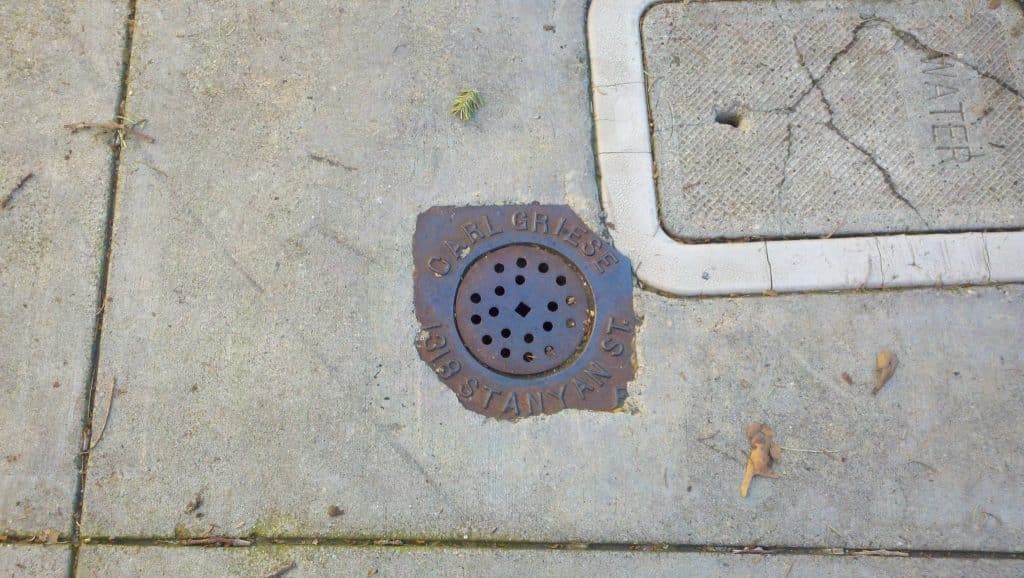
I found two director listings for this concrete contractor both from 1901
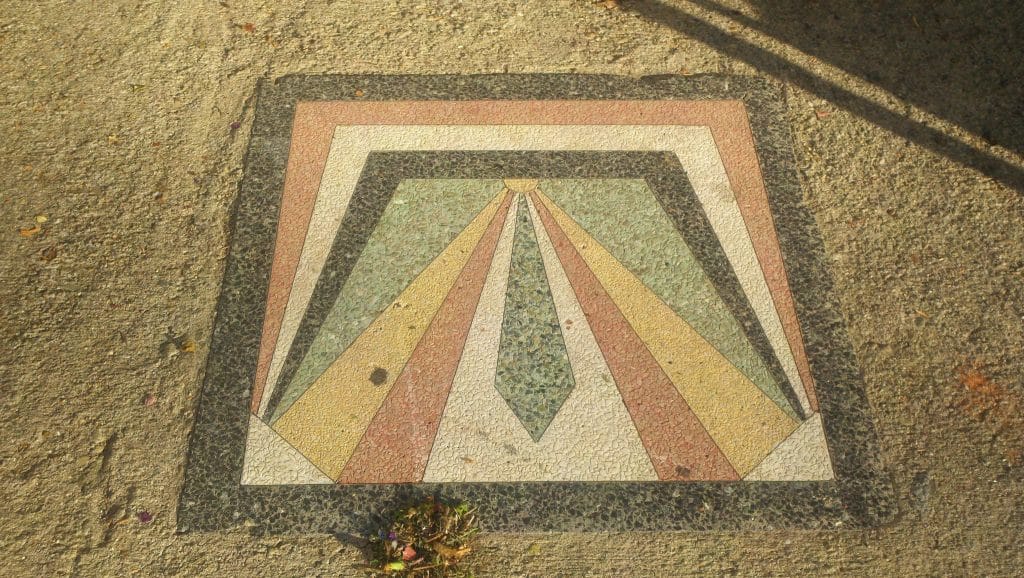
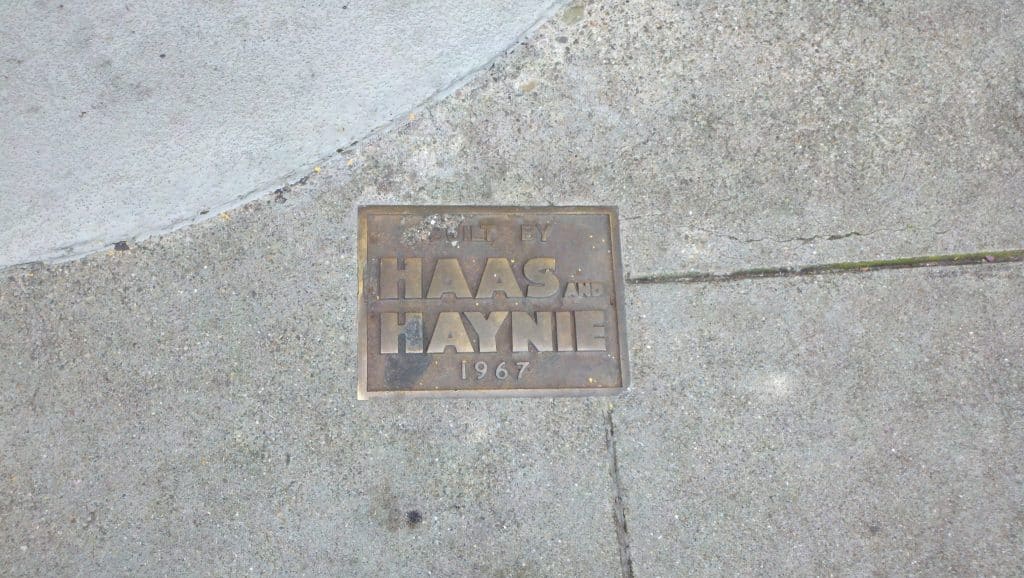
Super mod brass contractor stamp. Post and Webster
This firm was founded in 1898 and is still around is still around https://www.hh1898.com/
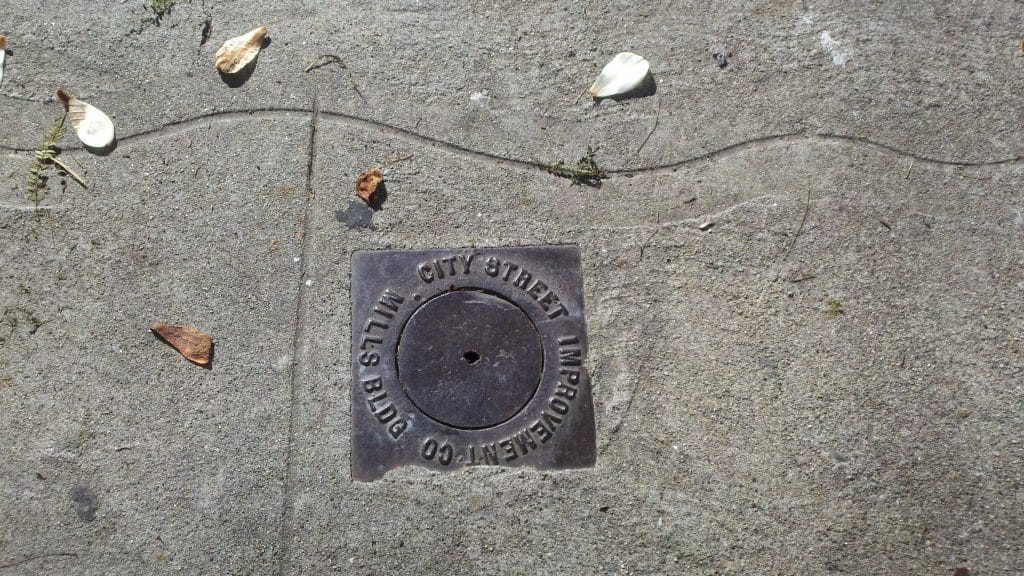
Mills Building’
Sewer vent cover and scallop detail expansion joint.
Was paired with a brass patent stamp Duncan and San Jose
I found references for these contractors in trade journals ranging in dates from 1902 to 1922. Judging from the context of the job here they were still around in the 1930s. This work was part the modification of a modest stick Victorian to add a driveway and garage. the driveway, retaining walls, and sidewalk all appear to be from the same job. The scallop detail was pretty popular in the 1930s and cars, and therefore garages, were also becoming typical during this period.
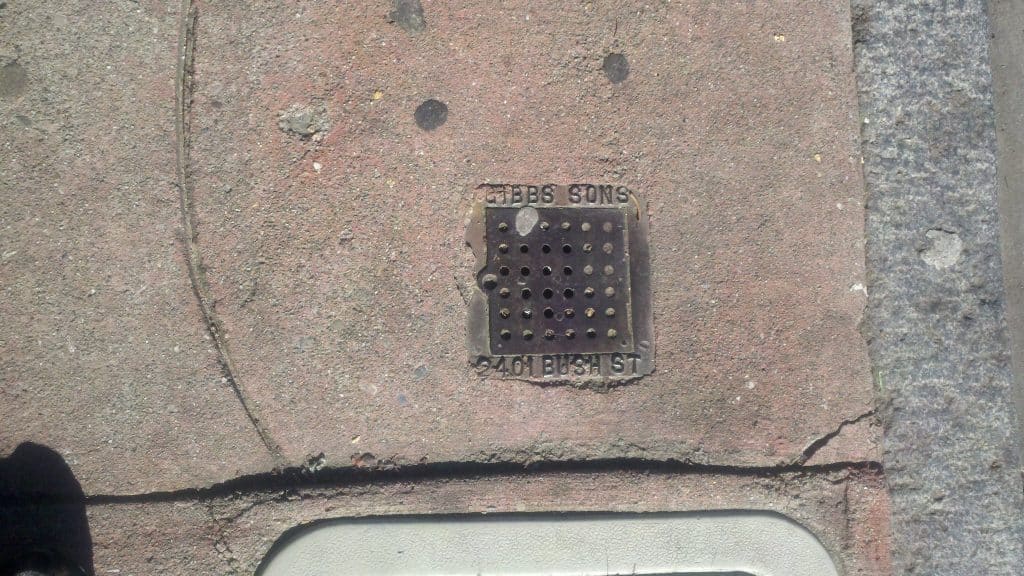
Sewer vent cover. Valencia and Liberty
The only reference I could find was CA Contractors Board Directory listing from 1951 which is consistent with this fairly modern casting and pink colored concrete.
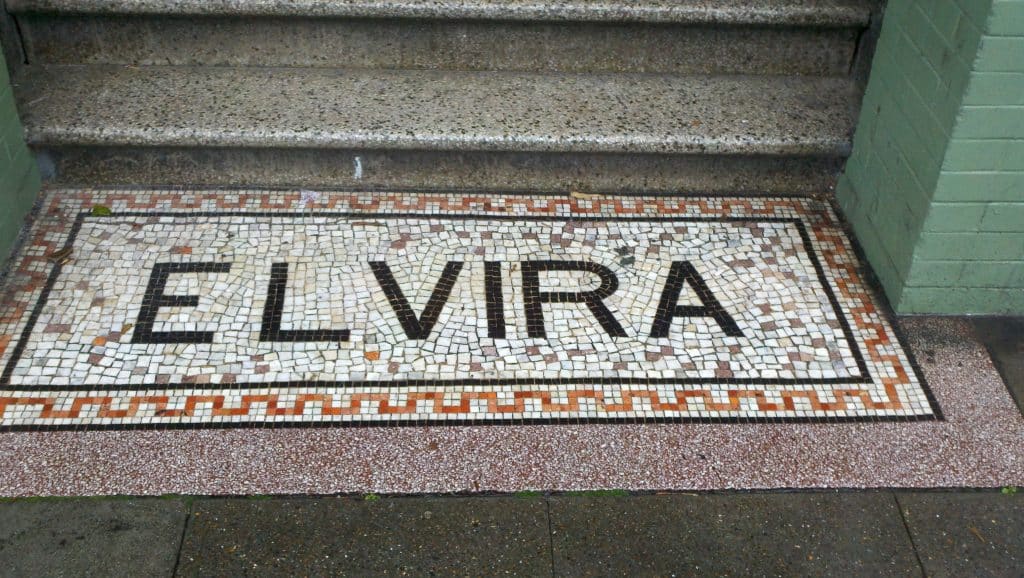
Officially Pompeii was rediscovered in 1599 but extensive systematic excavation didn’t begin until the 1860s and lasted through that century.
As archeologists began to piece together the picture of what had been, popular interest soared. The ‘Romantic’ image of ancient Rome captured the world’s imagination. New construction drew heavily on this fascination to inspire its detailing. Neoclassicism became a prevailing theme in both domestic (Queen Anne) and institutional (Beaux Art) architecture of this period.
This mosaic, and many more throughout the city, resulted from this mania. It is meant to suggest the many marble mosaics that were unearthed in the villas and baths of Pompeii.
http://en.wikipedia.org/wiki/Pompeii
http://www.google.com/images?hl=en&client=firefox-a&hs=zev&rls=org.mozilla:en-US:official&q=pompeii+mosaic&bav=on.1,or.&um=1&ie=UTF-8&source=og&sa=N&tab=wi&biw=1280&bih=607
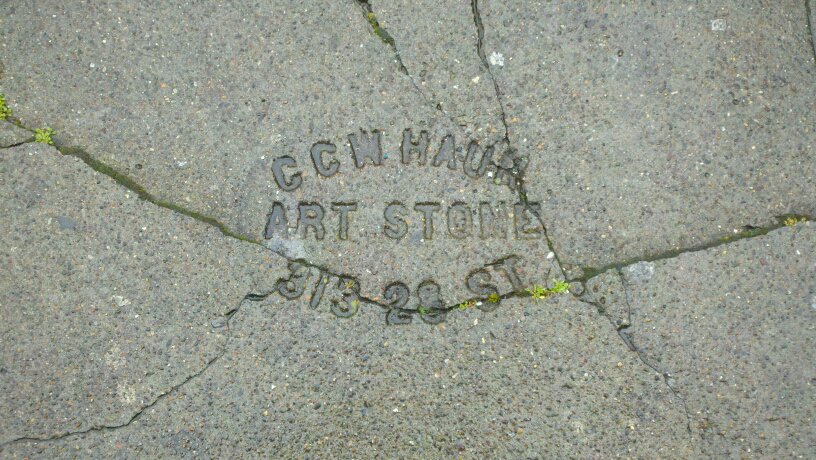
He moved west from Minneapolis at some point after his son’s birth in 1885 and before 1899 when he first appeared in directory listings in San Francisco
(His son’s obituary states: ‘Died July 21 , 1962 George Cleveland Haun , the son of C. C. W. and Emma ( Wachsmuth ) Haun , was born in Minneapolis , Minn . , on April 18 , 1885)
A photo of him can be seen in the mixer ad from Cement World Magazine 1916:
https://www.google.com/books/edition/Cement_World/8uQfAQAAMAAJ?hl=en&gbpv=1&dq=C.+C.+W.+Haun&pg=RA6-PA6&printsec=frontcover
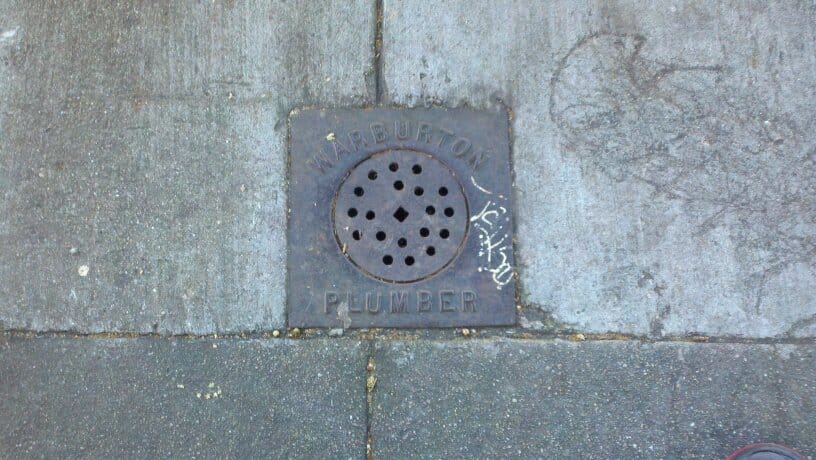
sewer vent cover. 19th at Valencia
no definitive references found
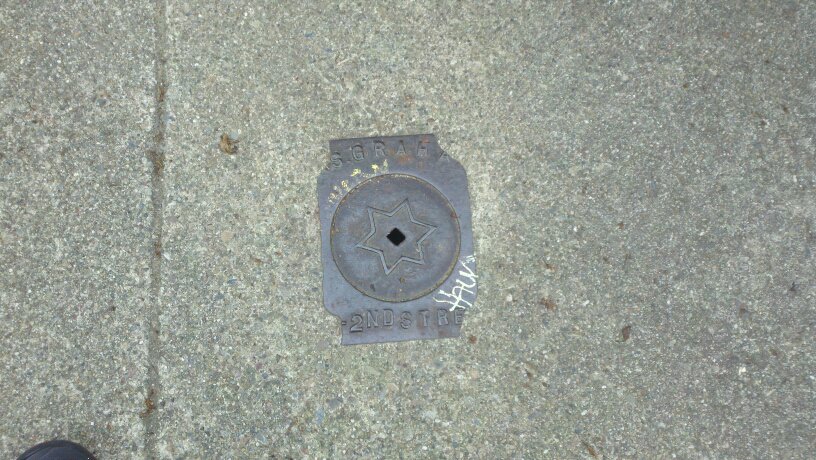
2nd street
sewer vent cover
pre1906: ” THE JAMES GRAHAM MFG . COMPANY , which was formerly located at 14 Second street , has reopened for business on Minna street , between First and Second , San Francisco , with a line of Wedgewood Ranges and Stoves” from The Metal Worker, Plumber, and Steam Fitter – Volume 66 1906
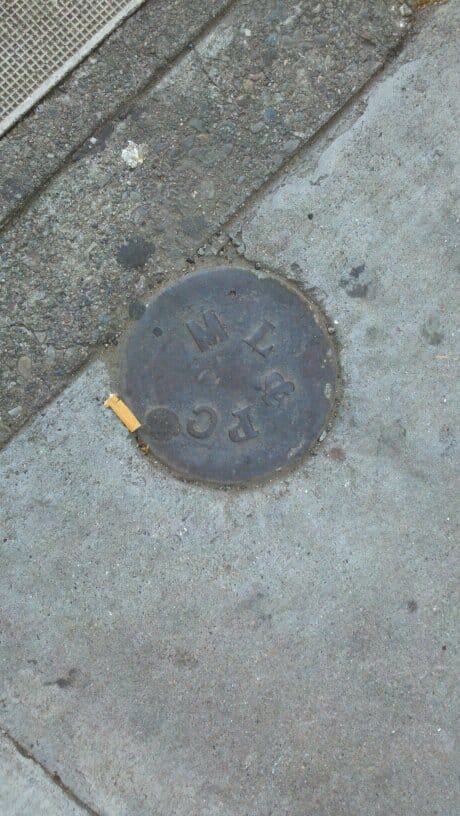
unknown significance no definitive references found
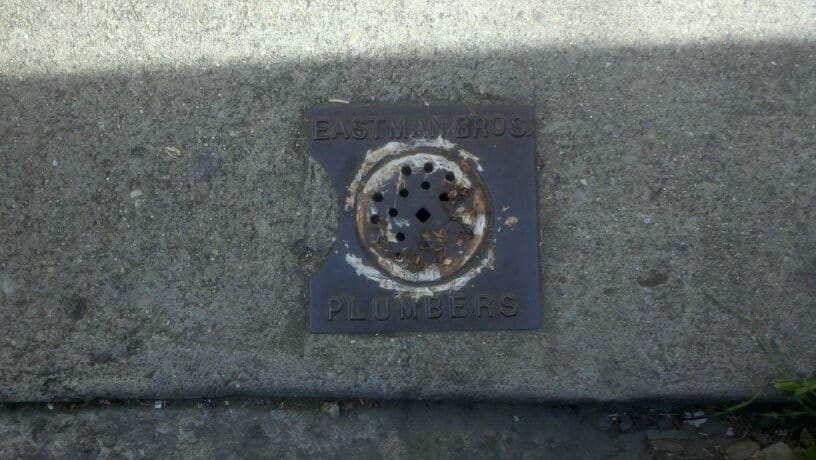
an 1899 directory lists Edward as living at 549 Valencia and his brother, George, as living across the street at 516 Valencia
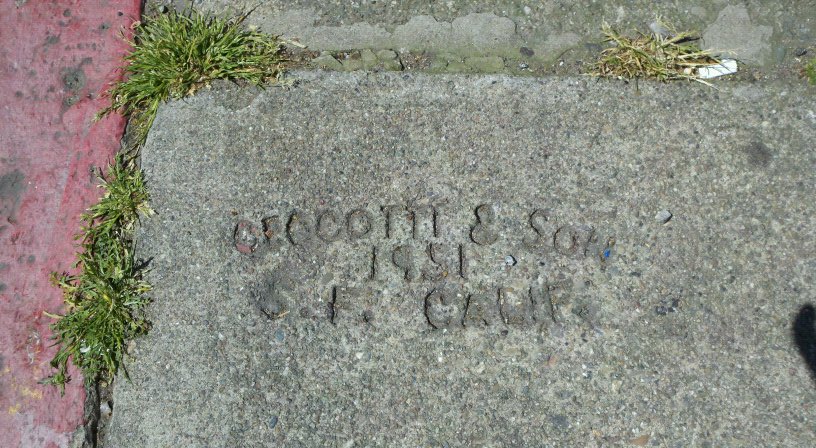
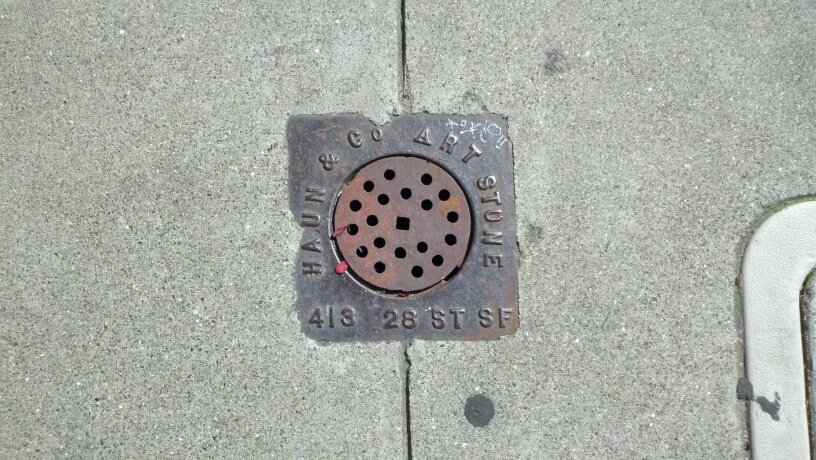
Sewer vent cover. 23d at Shotwell
CCW Huan had a prolific career with many references from 1899-1930
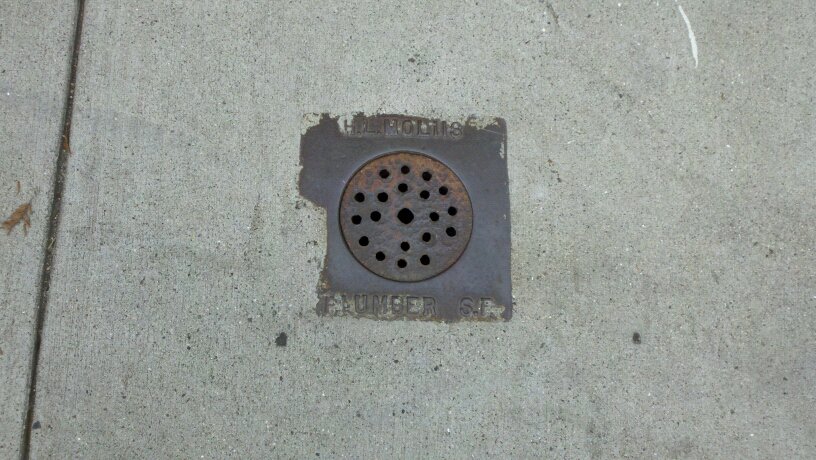
plumber’
sewer vent cover South Van Ness and 18th
No definitive references found
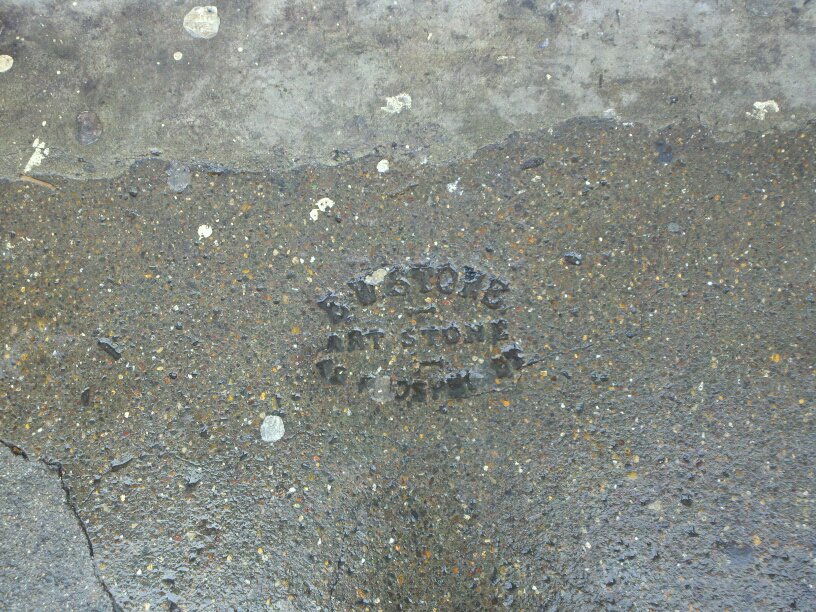
Art. Stone
Patent stamp. 16th and Valencia
no definitive reference found
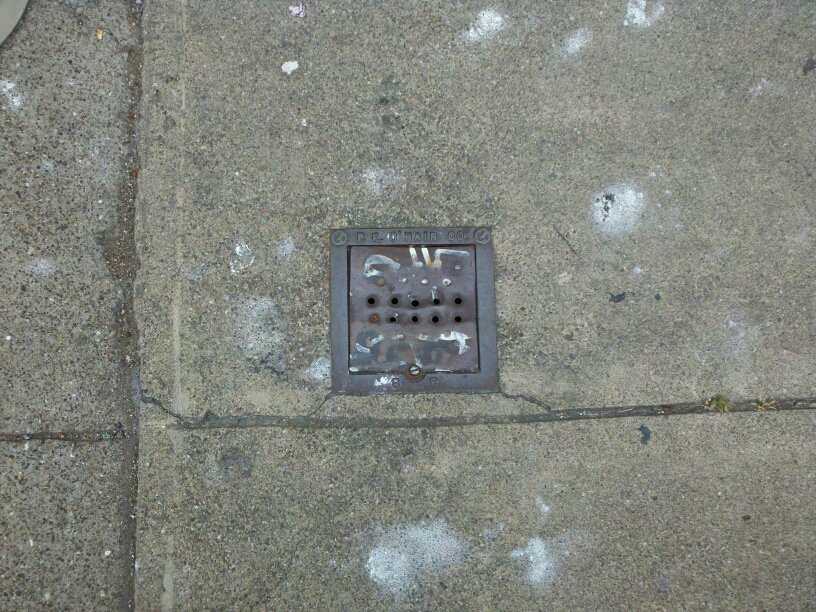
Sewer vent cover. 21st at Harrison
Patrick Edward (P.E.) O’Hair was born in Charles City, Iowa in 1856. By 1897 he owned a hardware store in San Francisco. On April 18, 1906, at the age of 49, Patrick’s home and hardware store were destroyed by the earthquake and fire. His insurer did not cover damage claims. Nonetheless he managed to rebuild a plumbing supply business. Patrick Edward O’Hair died in 1923 in San Francisco at the age of 67. His oldest son, Donald, then became President of P.E. O’Hair and Company. The company remained an independent business until 1988, when it was sold to United Westburne Industries and became a subsidiary. In 1997 United Westburne discontinued use of the P.E. O’Hair and Company name.
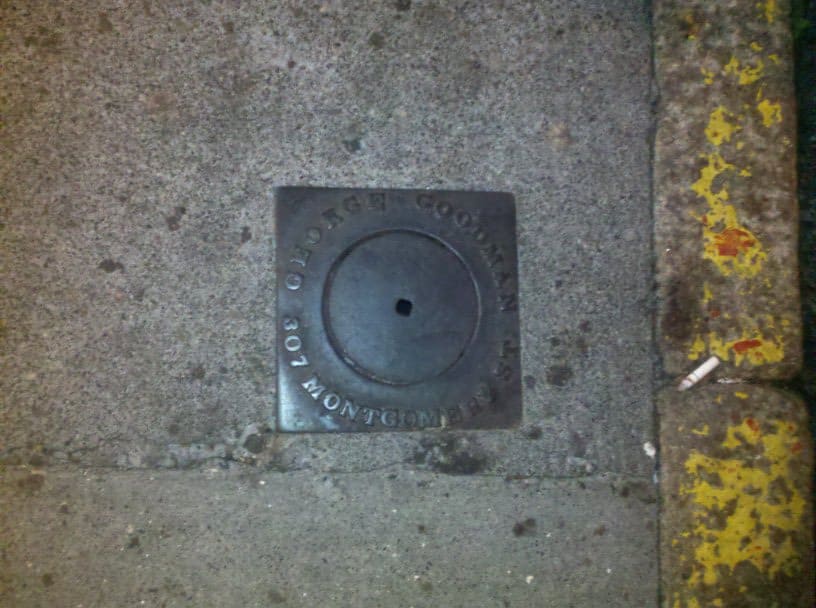
307 Montgomery
sewer vent cover . 18th at Castro
references from 1890-1902′
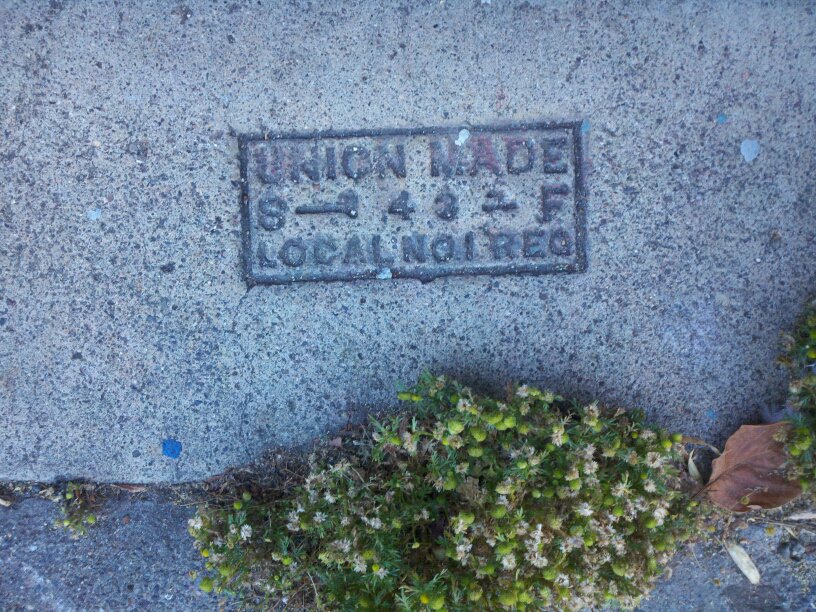
patent stamp. South Van Ness at 18th
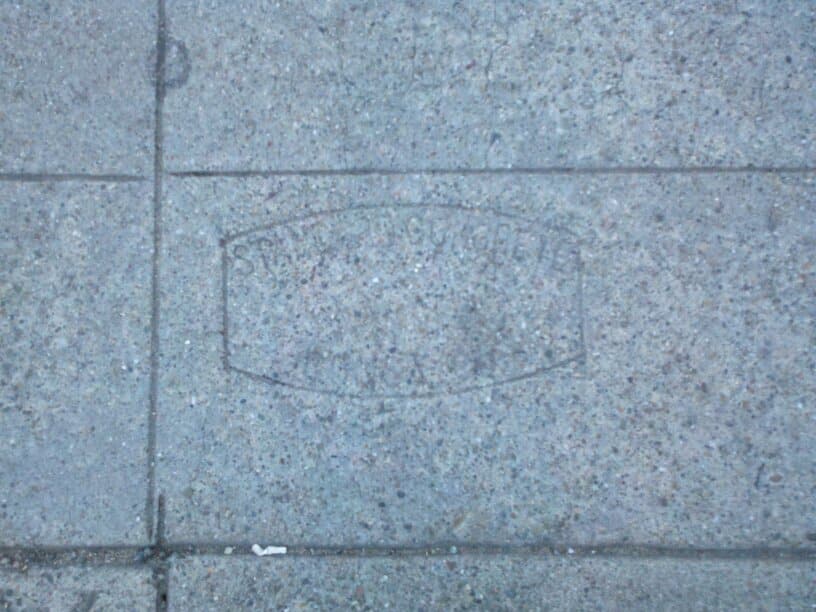
no definitive references found
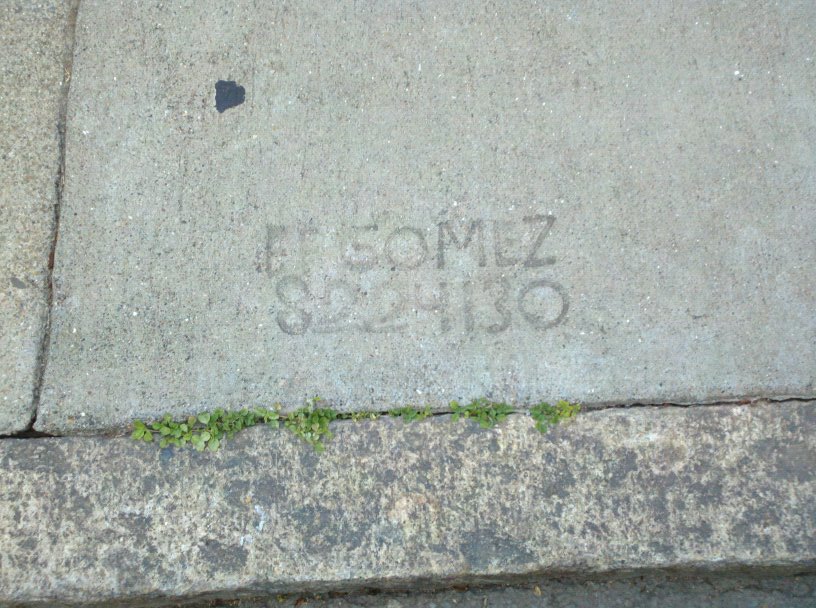
I have worked with E.F. Gomez Concrete. They started business in 1993 and are still in business and using this phone number today.
https://www.efgomez.com/
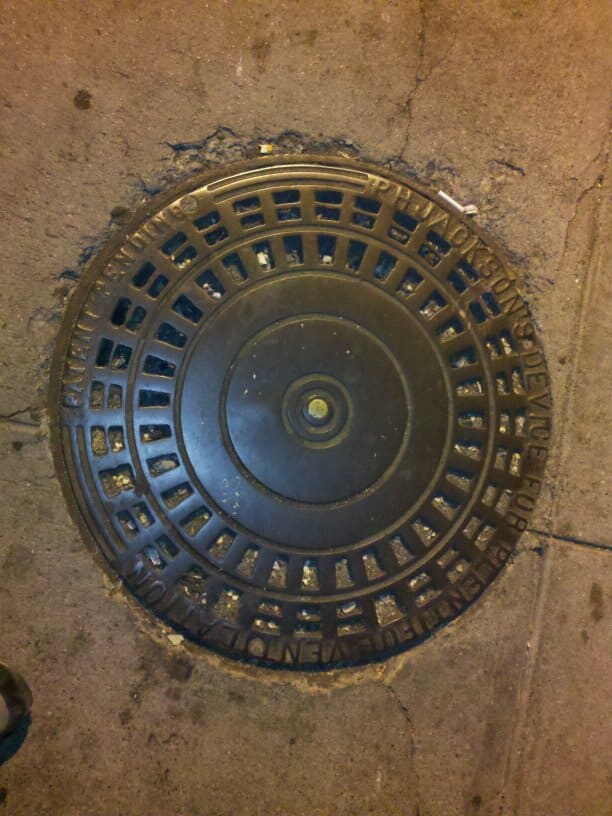
“P. H. JACKSON & Co. – Acme Ventilator . It is claimed that this ventilator has no equal for the exhaustion of sewer gas” from the Report of the Industrial Exhibition of the Mechanics’ Institute of the City of San Francisco Issue 23· 1888
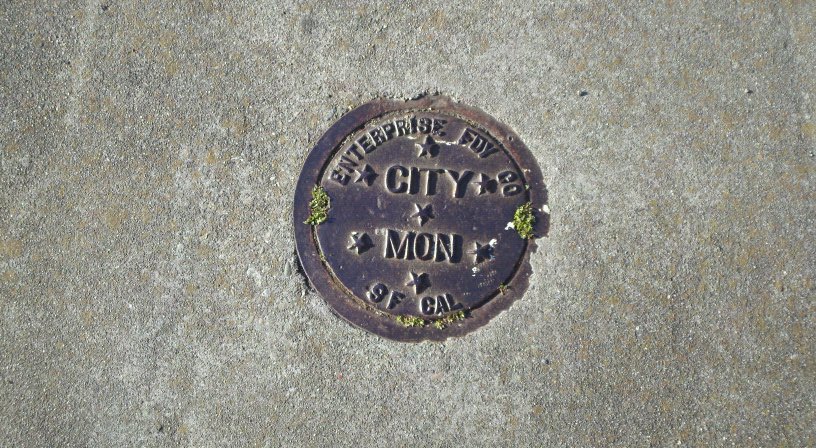
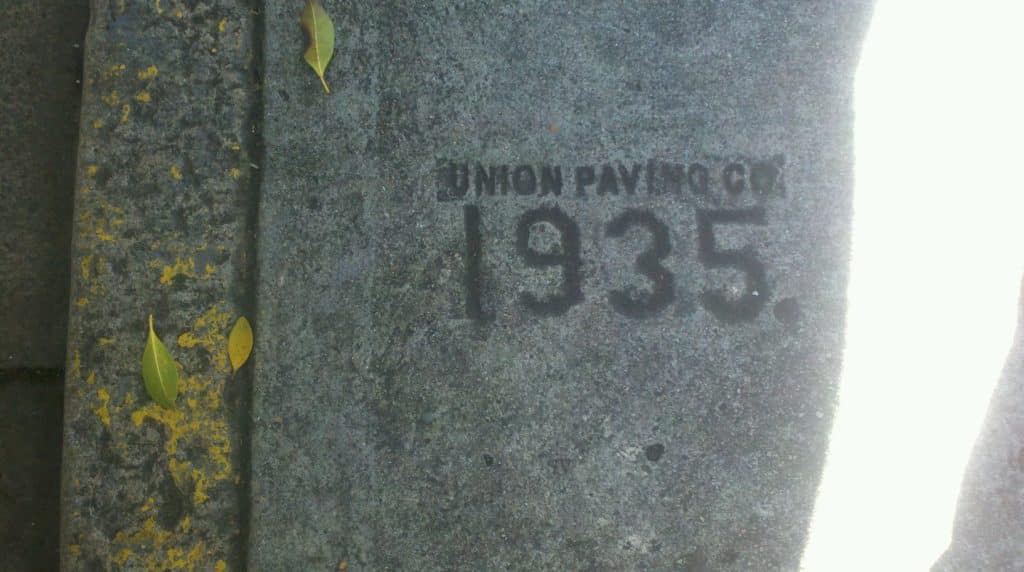
dated patent stamp Potrero at 16th.
references from as early as 1897
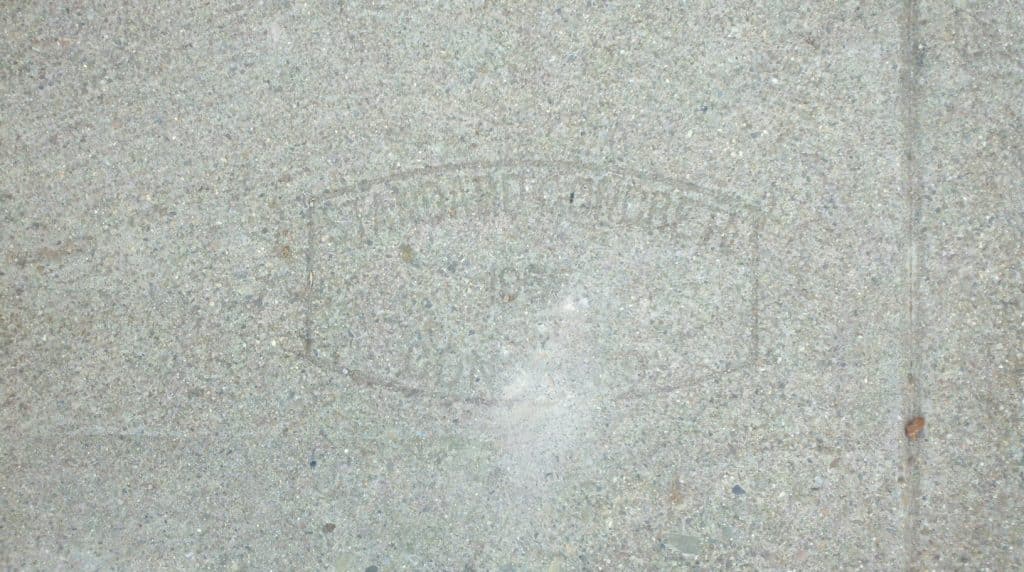
Dated concrete contractor patent stamp. 20th at Collingwood
no definitive references found
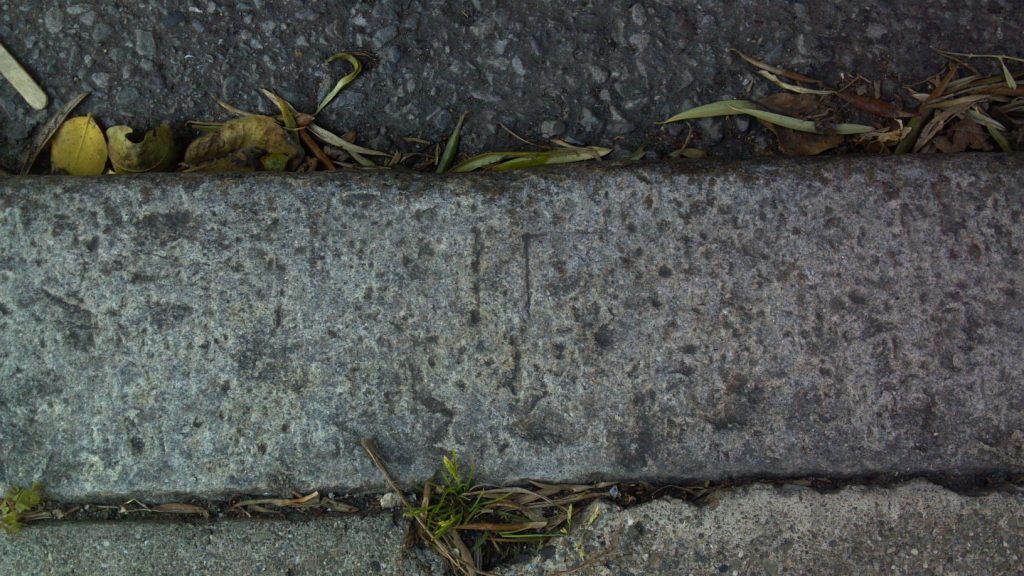
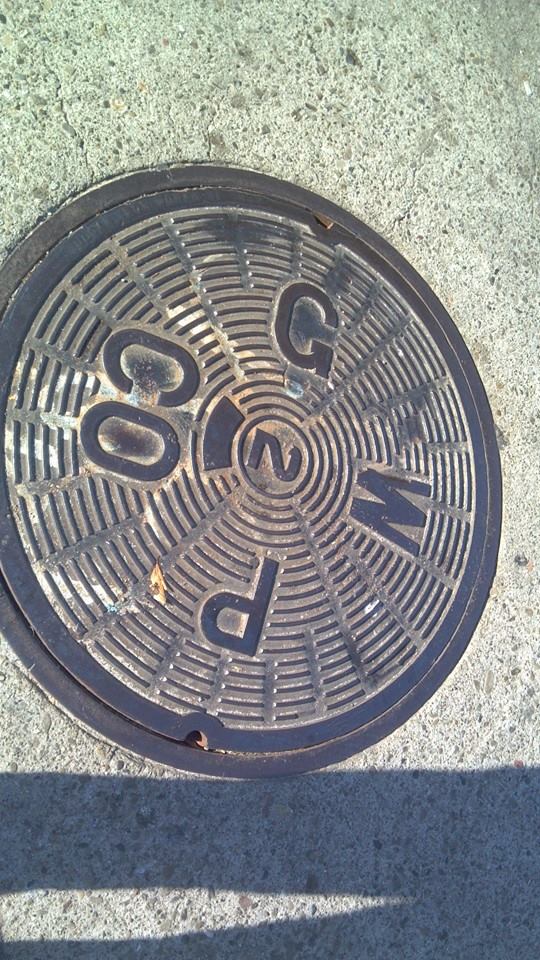
Manhole cover Hayes at Octavia
Great Western Power Co
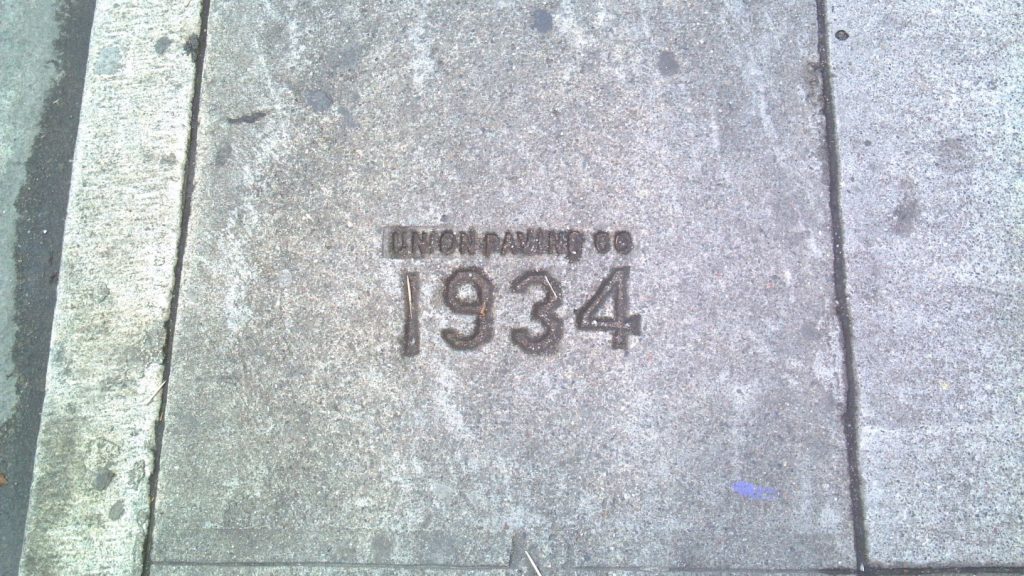
1934′
Dated patent stamp. Potrero and 22nd
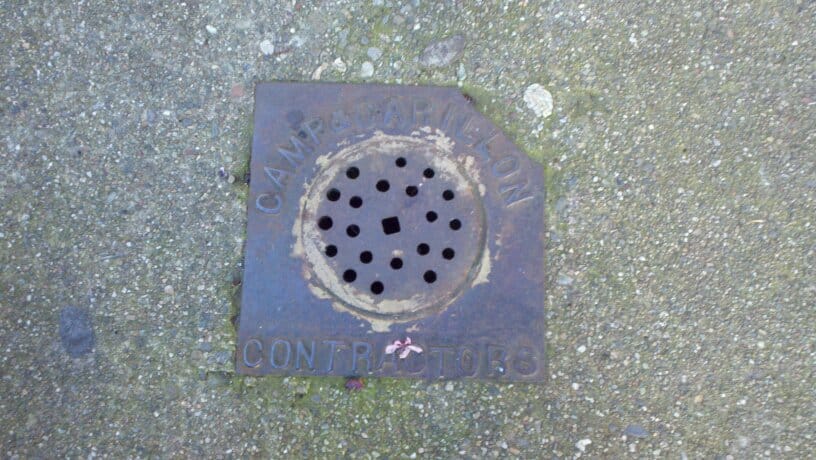
An 1899 directory listing shows their offices at 49 New Montgomery. William Camp lived at 3966 18th St. and Charles Carillion at 4516 20th St. SF municipal reports show they were awarded DPW contracts in 1910 and 191
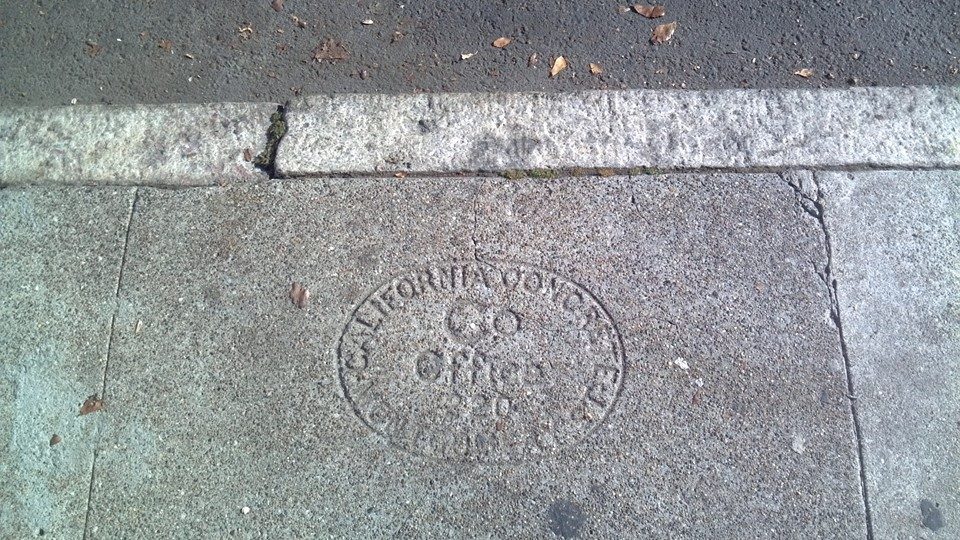
concrete patent stamp. Florida at 24th
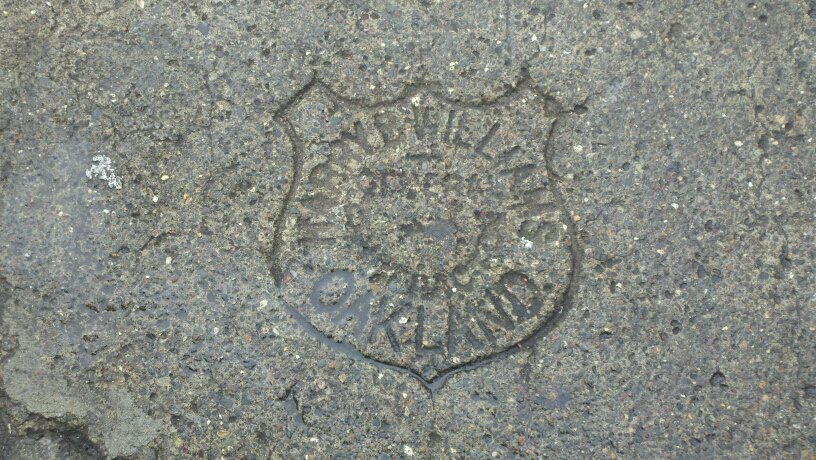
patent stamp. Mission and South Van Ness.
No definitive references found
Click on the links below to see more!
SF Gate: These overlooked fixtures of San Francisco tell the story of who built the city
Using San Francisco History: Patent Stamps: History Beneath Your Feet
